
BEYOND CONVENTION ACCESSIBLE HOTELS GREAT ESCAPES PLUS
Expanding the horizons of a growing MICE travel market
Discover the properties making inclusive hospitality a reality
Unlocking the potential of the escapism travel trend
Indonesia • Long-term stays • Tried & Tested


LEGACY REKINDLED, SHAPING A VISIONARY FUTURE

businesstraveller.com MAY 2024
DIRIYAH A
DHS12 RO1.30 BD1.30 SR12 KD1 6 291100 745012














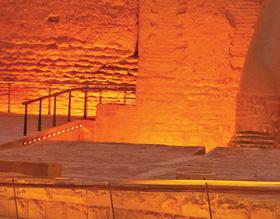

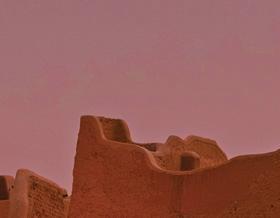















The birthplace of the Kingdom A 300-year-old legacy




DIRIYAH.SA
At-Turaif, UNESCO World Heritage Site
REGULARS FEATURES
24 HOME AWAY FROM HOME
Exploring the rising potential of the extended stay market
32 EQUAL ACCESS


Accessible tourism – an ethical choice that’s also good for business
28 AIR MILES
Raha Moharrak, the youngest-ever Arab and rst Saudi woman to have climbed Mount Everest
30 ELEVATOR PITCH
Gregory Viaud, general manager of the Four Seasons Hotel Rabat at Kasr Al Bahr in Morocco
36 INSIDE SCOOP e travel capitals of the future
Regal picks and ne fragrances
66 POSTCARD
Ground breaks on the Sharaan Resort in Saudi Arabia’s AlUla





Discover the properties that are making inclusive hotels a reality
37 24 HOURS IN e Black Sea resort and port city of Batumi, Georgia



38 BEYOND CONVENTION


Expanding the horizons of a growing market around MICE (Meetings, Incentives, Conferences, and Events) travel




44 GREAT ESCAPES
Unlocking the expanding lure of the escapism travel trend
50 THE DRAGON AND THE DEEP BLUE SEA
Flores and Komodo National Park, in the heart of the Indonesia archipelago, are a nature-lover’s paradise



the
historically-rich











CONTENTS MAY 2024 MAY 2024 COVER IMAGE: DIRIYAH COMPANY THE REPORT
TRIE D & TESTED FLIG HT 58 Japan Airlines Boeing 787-9 business class Doha–Tokyo TRIE D & TESTED HOTELS 60 Villa Fontaine Grand Haneda Airport 61 voco Dubai e Palm 62 Four Seasons e Pearl-Qatar SMAR T TRAVELLER 64 Our guide to... British Airways’ £7-billion transformation 24 06 UPFRONT
latest airline, hotel, and travel news 12 SUSTAINABLE TRAVELLER
region 14 GLOBAL NEWS An update on international travel
e
Best practices from across the
22 OPINION
54 LIFESTYLE
Diriyah,
City of Earth, forges a new story as this
Arabian jewel begins its modern reign
38 44 32 3



























Community is everything. Whether you’re a writer, an athlete, or a corporate worker, having the right people around you can make or break an experience, or indeed, one’s path in life.
Business Traveller Middle East is jointly
MOTIVATE MEDIA GROUP
Editor-in-Chief Obaid Humaid Al Tayer
Managing Partner and Group Editor Ian Fairservice
Editor Yi-Hwa Hanna
Art Director Clarkwin Cruz
Editorial Co-ordinator Londresa Flores


It’s a sentiment that I felt keenly during a trip to Tokyo last month, where I visited the “Manuscript Writing Café”, a unique spot in Japan’s capital created speci cally for creatives to be able to work in a focused environment that provides an intangible sense of support through solidarity. e owner, Takuya Kawai, sees himself as a coach of sorts, and works from there too: “ e manager creates an atmosphere by writing here himself,” he said. And he was right: I le four hours later with 3,000 words written, and a true sense of accomplishment. Leading by example is a time-tested way to build teams that reach inspiring new heights, and there’s no better place to see how this is done in the region’s travel, tourism, hotels, and aviation industries than the annual Business Traveller Middle East awards – which takes place this month. On the 6th of May, 300+ industry C-suite executives, thought leaders, and key decision-makers will gather at e Ritz-Carlton, Dubai International Financial Centre for a gala dinner during which some will receive awards recognising their outstanding impact. eir contributions are an exemplary way to achieve growth, not only for the individuals and teams involved, but for the region as a whole. We can’t wait to celebrate you.
One shining example of the type of progress that an inspired community can achieve is Diriyah. e giga-project has transformed the rst Saudi state into a jewel worthy of the kings that once lived there, and has begun its new reign as one of the region’s most coveted cultural destinations. Diriyah was historically celebrated as a place for gathering, and that strength of community still shines through today. Learn more in our cover story (p16).
In order to create a successful community, one must account for the needs of as many of its members as possible, regardless of their physical or intellectual limitations, disabilities, or age. It is inspiring to see so many hotels (p32) and tourism destinations (p22) around the world rising to this challenge through increasingly accessible tourism.
Still, while we all need a fair dose of connection, a bit of introspection never goes amiss – and in an information-overloaded world with an attention economy that constantly demands our hustle, it’s little surprise that when it comes to recreation, escapist travel is a trend that’s on the rise ( p44). Whether you have travel planned this month or not, we hope you enjoy escaping into this issue for now, at least! Until next month.
 Yi-Hwa Hanna Editor
Yi-Hwa Hanna Editor

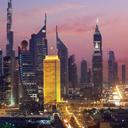

Contributors Tamsin Cocks, Hannah Brandler, Zana Azeredo, Amy Sessions, Camille Macawili, Sara Hamdan
General Manager – Production S Sunil Kumar
Production Manager Binu Purandaran
Production Supervisor Venita Pinto
Chief Commercial Officer Anthony Milne
Group Sales Manager Chaitali Khimji
Senior Sales Manager Murali Narayanan
PANACEA MEDIA LTD
Managing Director Julian Gregory
Associate Publisher Middle East Rania Apthorpe
HEAD OFFICE: Media One Tower, Dubai Media City, PO Box 2331, Dubai, UAE; Tel: +971 4 427 3000; Fax: +971 4 428 2266; E-mail: btme@motivate.ae
DUBAI MEDIA CITY: SD 2-94, 2nd Floor, Building 2, Dubai, UAE; Tel: +971 4 390 3550; Fax +971 4 390 4845
ABU DHABI: PO Box 43072, Abu Dhabi, UAE; Tel: +971 2 677 2005; Fax: +971 2 657 3401; Email: motivate-adh@motivate.ae
SAUDI ARABIA: Regus Offices No. 455 - 456, 4th Floor, Hamad Tower, King Fahad Road, Al Olaya, Riyadh, KSA Tel: +966 11 834 3595 / +966 11 834 3596
Email: motivate@motivate.ae
LONDON: Motivate Publishing Ltd, Acre House, 11/15 William Road, London, NW1 3ER, UK; E-mail: motivateuk@motivate.ae
Panacea Media Ltd
41-43 Maddox Street, London, W1S 2PD; Tel: +44(0)20 7821 2700; businesstraveller.com
Panacea Publishing Asia Ltd
#2408 24/F Dominion Centre, 43-59 Queen’s Road East, Wanchai, Hong Kong; Tel: +852 2594 9300; Fax: +852 25196846
SUBSCRIPTIONS:
Email: subscriptions@motivate.ae; Tel: +971 4 427 3542 businesstraveller.com/middle-east
btmiddleeast businesstravellerme
WELCOME MAY 2024
© 2024 PANACEA MEDIA LTD AND MOTIVATE MEDIA GROUP
published by Motivate Media Group and Panacea Media Ltd
THIS
BEYOND CONVENTION Exploring the horizons of a growing MICE travel market (Page 38) HOME AWAY FROM HOME e rising potential of the UAE’s extended stay market
24) THE
ISSUE’S PICKS
(Page
DRAGON AND THE
DEEP BLUE SEA
Discover a nature-lover’s paradise in Indonesia (Page 50)
AUSRA OSIPAVICIUTE; DUBAI WORLD TRADE CENTRE; USO/GETTY IMAGES 4

Enrol in Rotana Rewards Select and save 10% off room rates Book a stay at any Rotana hotel or resort in the region and receive 10% off all public room rates with flexible cancellation, 10% off dining, as well as access to exclusive VIP amenities, late check-out and more. Book now via rotanarewards.com or call +971 (0) 2 811 9777

JERRY INZERILLO APPOINTED UNITED NATIONS TOURISM AMBASSADOR
DIRIYAH COMPANY Group CEO Jerry Inzerillo was appointed a United Nations Tourism Ambassador during the rst ever UN Sustainability week in New York in April. e accolade recognises his achievements as a global visionary in the hospitality industry, and as an internationally-acknowledged visionary in tourism development during his over 50-year career. He was presented with the award by the Secretary General of the UNWTO Zurab Pololikashvili, during a day dedicated to debating and discussing future global tourism strategies and the vital role sustainability will play in that future.
Inzerillo joins an elite group of nearly 50 UN tourism ambassadors from the world of arts, business, gastronomy, and sport, including Georgio Armani, Lionel Messi, and Placido Domingo. e honour re ects his lifelong commitment to the use of innovative design and development strategies to support local communities and create new and undiscovered tourism destinations.
Etihad and Manchester City launch community football projects across India
A NEW JOINT INITIATIVE from Manchester City football club and Etihad Airways will see the two work together with Club charity City in the Community, as well as non-governmental partner organisation (NGO) Magic Bus India Foundation, to deliver health and life skills training for local young people in India through football. Having kicked o in April in three cities within Etihad’s network – New Delhi, Kolkata, and Bangalore –the project aims to help support a better future for young people, and upli the local community. e two organisations have been fostering such initiatives since the launch of their o cial partnership in 2009, with past e orts including a number of global and regional summits in Manchester and Abu Dhabi that worked towards upskilling young leaders in community football coaching and leadership.

Nikki Beach Global evolves into Nikki Beach Hospitality Group
AFTER OVER 25 YEARS of successful beach club and resort operations, Nikki Beach is continuing its global expansion with the introduction of a new restaurant concept, Lucia. Launched in March 2024, this significant new development joins the group’s portfolio of Nikki Beach resorts, beach clubs, residences, and lifestyle boutiques. The new restaurant has first launched in Cannes, with more international locations set to follow.
"We have openings in the pipeline for Nikki Beach across the Middle East, Asia, and the Caribbean,” said Lucia Penrod, the brand's co-founder, owner, and CEO.
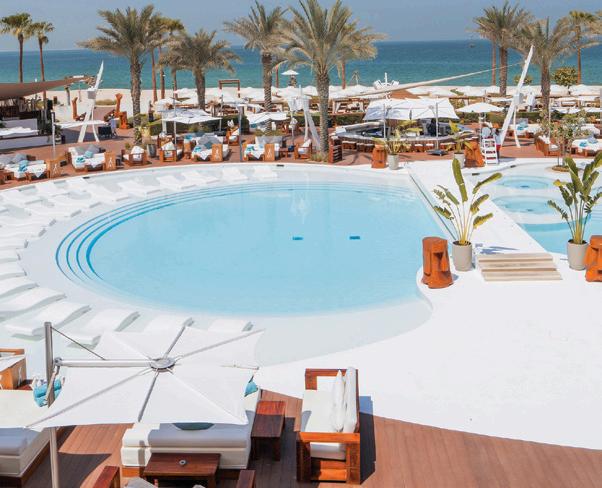
UPFRONT MAY 2024


Cigarette Racing launches in the Middle East
LUXURY PERFORMANCE boat
manufacturer Cigarette Racing is bringing a range of models – all of which are custom-designed – to the region, ranging from the 41’ Nighthawk to the 59’ Tirranna, all of which o er a unique combination of meticulous cra smanship, performance, and luxury. e company is currently appointing dealers strategically around the region to ensure that the customer support on sales and a ersales are kept at the highest level for existing as well as future Cigarette boat owners. During the VIP Open Day launch event, attendees were given the opportunity to view and experience ve Cigarette Racing models, including the centre conole boats 59 Tirranna, 52 under, 42 Auroris, 41 Nighthawk, and the iconic 515 performance boat.
INFLIGHT ENTERTAINMENT
READ: ARABIAN NOIR, CRIME WRITERS’ ASSOCIATION, GULF CHAPTER
With work from regionally-based authors Alex Shaw, Annabel Kantaria, Sara Hamdan, Michael Lynes, Padmini Sankar, Paul A Freeman, Moxie Anderson, Mohanalakshmi Rajakumar, Daisy Line, Gal Podjarny, Rohini Sunderam, Glen Stansfield, and Greig Parker, these thirteen dark, mysterious tales from across the Middle East will appeal to fans of hard-boiled thrills, golden age mysteries, whodunnits, and police procedurals alike. US$9.95, Amazon.
LISTEN: Bookshelfie: Women’s Prize Podcast
This weekly podcast from the Women’s Prize Trust is now in its seventh series and sees presenter Vick Hope interview famous women about their favourite books by female authors. Recent interviewees include authors Dame Jacqueline Wilson and Kiley Reid, as well as interior designer Kit Kemp.


WATCH: The Beach Boys
This documentary traces the legendary band’s humble beginnings and their rise to meteoric fame. Viewers will get a chance to watch never-before-seen footage and interviews with band members Brian Wilson, Mike Love, Al Jardine, David Marks and Bruce Johnston. An o icial soundtrack featuring songs from the film will be released, too. Available on Disney+ from 24 May.



JUMEIRAH GROUP EXTENDS PARTNERSHIP WITH WILLIAMS RACING FOR 2024
GLOBAL LUXURY HOSPITALITY company Jumeirah Group has extended its partnership with British Formula One team and constructor Williams Racing, which was first established last year to reach new global audiences as part of Jumeirah’s continued growth trajectory and international expansion. Under the extended partnership, Jumeirah –which currently has a varied global portfolio of 26 properties in 11 countries – will continue to curate exclusive events and moments at Grand Prix locations worldwide throughout 2024, with a focus on locations featuring Jumeirah properties.
MICHAEL OCHS ARCHIVES/ WALT DISNEY STUDIOS/GETTY IMAGES
Our picks to make time fly by
7 UPFRONT MAY 2024
MIRAL AND EMIRATES FOUNDATION TRAIN EMPLOYEES AS PART OF ‘SANID’ EMERGENCY RESPONSE PROGRAMME
ABU DHABI-BASED creator of destinations and experiences Miral has partnered with Emirates Foundation for a series of specialised employee training workshops that are part of the charity’s national emergency response volunteer programme, “SANID”. Part of Miral’s ongoing partnership with Emirates Foundation, the workshops will enable employees across the Group to enhance their skills in crisis management, disaster preparedness, and emergency response. It aims to build dedicated teams of volunteers who are well-prepared to safeguard civil safety. Led by experts from Emirates Foundation, additional sessions will be organised quarterly throughout the year.

Etihad Airways to begin ights to Al Qassim, Saudi Arabia
BEGINNING 24 JUNE 2024, Etihad will link Abu Dhabi’s Zayed International airport directly with Al Qassim’s Prince Naif Bin Abdulaziz International airport (ELQ) with four weekly flights. The addition of Al Qassim to its growing list of destinations increases its total number of Saudi Arabia gateways to four.
Arik De, chief revenue and commercial o icer at Etihad Airways, said: “Launching the new service to Al Qassim this year is not just about introducing a new destination; it’s also a celebration of Etihad’s 20 years of connecting Abu Dhabi with the rich culture and economic opportunities of the Kingdom of Saudi Arabia.”
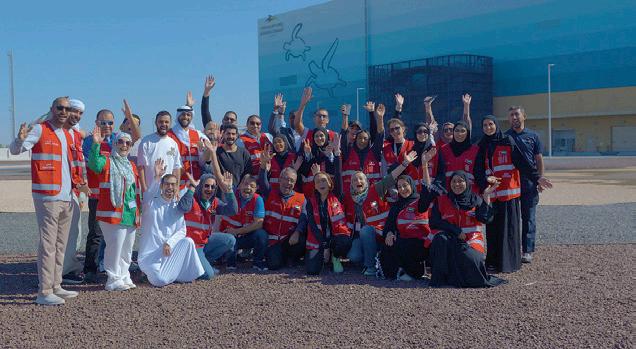
INSIGHT OUT
CONSULTANCY
AND THE HOSPITALITY INSTITUTE GCC TO PROVIDE COMMERCIAL HOSPITALITY TRAINING FOR SAUDI NATIONALS
INSIGHT OUT Consultancy has developed tailored training programmes for Saudi youth, to enhance the kingdom’s hospitality talent pool. e programmes, which blend theoretical knowledge with practical skills, are o ered through the Hospitality Institute GCC. Designed to cater to two distinct groups within the Saudi youth demographic, and address both school leavers entering the industry as well as young Saudis currently employed within the industry, the collaboration aims to empower Saudi youth with foundation training on a vocational level, equipping them with a practical understanding of commercial skill sets, and allowing them to future-proof their careers in a rapidly changing hospitality sector, which is set to generate US$3.02 billion in revenue by 2027.

LI HAWKINS, MANAGING DIRECTOR OF INSIGHT OUT CONSULTANCY 8 UPFRONT MAY 2024

































FOUR SEASONS PRIVATE JET OPENS FOR 2024 CHARTER BOOKINGS
THE FOUR SEASONS PRIVATE JET, a custom-designed Airbus A321neoLR serviced by the luxury hospitality company, is now available for charter bookings, for custom trip lengths taking place between the dates of 4-26 August and 20-27 December, 2024 only. Once booked, Four Seasons team members will work with the booking party to create a customised itinerary. e jet is priced at approximately US$115,000 per day, inclusive of all Four Seasons Private Jet ights and onboard services, all meals, as well as airport services where applicable. Ground transfers, overnight accommodations, on-location meals, tours, and tickets can be arranged at an additional cost through the Four Seasons Guest Experience Team, or at the party’s own discretion. e jet has 48 custom-designed, spacious leather atbed seats, and each guest is provided with a personal iPad loaded with the latest entertainment as well as Bose headphones. It is sta ed by 10 crew members. Booking inquiries can be made at fourseasonsjet@fourseasons.com or +1 866 557 4794.



RED SEA GLOBAL RELEASES DOCUMENTARY IN COLLABORATION WITH WARNER BROS. DISCOVERY
RED SEA GLOBAL has collaborated with Warner Bros. Discovery on a documentary film that sheds light on the vital importance of combating the impact of climate change on coral reefs. The film aired on the Discovery Channel on Earth Day, 22 April 2024, across the US, Europe, Türkiye, the Middle East, Africa, and Asia. A first exclusive look of the film was shown during a side event to COP28 in Dubai, hosted by Red Sea Global, where a teaser was played for guests. The film follows the remarkable journey of Saudi Arabian free diver Salma Shaker as she explores the groundbreaking coral research conducted by scientists at Red Sea Global and King Abdullah University of Science and Technology (KAUST). The film also delves into the potential benefits of coral research in the Red Sea for ecosystems globally.
Idioms from around the world that have us scratching our heads. This issue, it’s a Czech expression.
Phrase: šplouchá mu na maják Literally: It’s splashing on his lighthouse Meaning: To describe someone who’s gone crazy
10 MAY 2024 UPFRONT






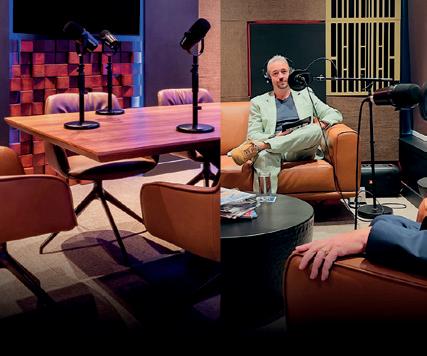


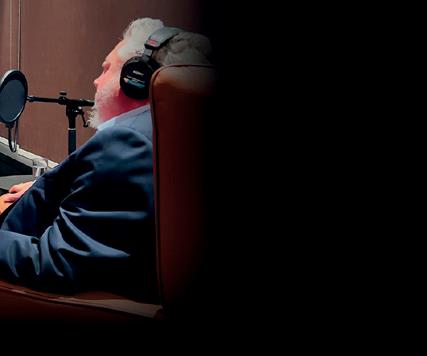
Calling all podcasters and content creators!
Whether you are looking to record, edit or manage your podcast, our fully equipped podcast and video recording studio has it all.




+971 4 427 3000 | podcast@motivate.ae BOOK YOUR STUDIO motivatemedia.com
Rotana and Chef’s Eye partnership results in 63 per cent reduction of food waste
IMPLEMENTED ACROSS the brand’s properties in the UAE at the end of 2023, Rotana’s partnership with intuitive food-waste measurement technology Chef’s Eye has resulted in a 22 per cent reduction in its overall production or trim waste, as well as a 15 per cent reduction in food waste from its bu et stations, and a 63 per cent reduction in food waste from its plated meals. First quarter results for 2024 indicate that Chef’s Eye has enabled Rotana to reduce its carbon emissions by 41,245.93kg (equivalent to charging over 2.7 million smartphones or powering 10 gasoline passenger vehicles for a full year). In addition, food waste has been reduced by an average of 25g per cover. With over 100 properties across the Middle East, Africa, Eastern Europe, and Türkiye (MENAT), these figures can make a significant dent in Rotana’s environmentally-focused e orts. According to Rotana, data indicates that an average hotel in the UAE produces one tonne of food waste per week. With the help of Chef’s Eye, Rotana is able to collect and analyse data that helps identify and action critical changes e ectively.







CATHAY PACIFIC SETS NEW SUSTAINABILITY TARGETS FOR 2025






AND BEYOND


CATHAY PACIFIC has released its 2030 Sustainability Report, in which it underscores its ongoing commitments and progress towards sustainability. Among its key highlights, the airline has committed to new near-term climate improvements. Building upon its commitment to achieving net-zero carbon emissions by 2050, Cathay now also hopes to improve its carbon intensity by 12 per cent more than its 2019 level by 2030. To achieve this, the airline plans to accelerate SAF use, modernise its eet, and drive operational improvements, the former of which remains its most important lever for both improving carbon intensity as well as achieving net-zero operations in the long run. In addition to driving further development of the SAF supply chain in the region and conducting its rst overseas SAF upli on commercial ights, Cathay has also expanded its Corporate SAF Programme by establishing partnerships with new corporate clients and a non-governmental organisation. e airline is also moving towards a more sustainable use of resources, having set a new target to decrease passenger-facing SUP items from an average of 7.7 pieces per passenger in 2019 to 1.5 pieces by 2025. Cathay also aims to reduce cabin waste by 30 per cent from the 2019 baseline by 2030. It plans to achieve these goals by incorporating circular economy principles into its product and service design by selecting more sustainable or recycled materials upstream, and channelling used items back for recycling or repurposing. “By embracing the collaborative ethos of ‘Greener Together’, we aim to lead by example and reach new heights in building a more sustainable future,” said Cathay Paci c’s CEO Ronald Lam.






















MAY 2024
12 SUSTAINABLE TRAVELLER

Cayan Group signs deal for second Hampton by Hilton at NEOM
CAYAN GROUP, a leading real estate investment and development company in the Middle East, has signed an agreement with Hilton to open a new 201key Hampton by Hilton property at NEOM Community. e new property will be the second Hampton by Hilton property there, as Cayan Group builds upon an existing partnership with NEOM. A signing ceremony took place at the International Hospitality Investment Forum (IHIF) in Berlin in the presence of Hilton’s president and CEO Chris Nassetta, and Cayan Group’s chairman, Ahmed Alhatti. With construction soon starting, the Hiltonmanaged hotel is expected to open at the beginning of 2025. e hotel’s exible design and construction will centre around sustainability while deploying energy e cient systems. As NEOM moves forward to meet its ambitious targets, developing liveability options is an important milestone to ful l the needs of visitors.

Etihad Rail signs waste management agreement with BEEAH Group
ETIHAD RAIL, the developer and operator of the UAE National Rail Network, has signed a first-of-its-kind agreement for waste management services with BEEAH Tandeef, a subsidiary of BEEAH Group (a leading provider of sustainability solutions in the Middle East). The agreement will ensure that various forms of waste at Etihad Rail’s sites are managed e ectively, safely, and in an environmentallyresponsible manner, as BEEAH Tandeef will provide waste management services for the entire Etihad Rail network, including regular waste collection, transportation, disposal, and recycling. The agreement will reinforce the company’s commitment to conserving natural resources, and supports Etihad Rail’s e orts to reduce waste and the release of harmful chemicals and toxins into the air, soil, and water, mitigating the adverse e ects on local ecosystems, flora, and fauna.
ENVI LODGES LAUNCHES LUXURY TENTED NATURE CAMP IN TANZANIA

LUXURY ECO-LODGE brand ENVI Lodges is expanding its footprint in Africa with the launch of ENVI Kili on the outskirts of Arausha in Tanzania. The 20-key property has a restaurant serving cuisine focusing on ingredients grown in the ENVI garden and surrounding farms; a wellness facility o ering alternative nature-based treatments; and a yoga deck; as well as ENVI’s signature barefoot luxury experiences, and a personal adventure concierge service.
ENVI Lodges’ second venture in East Africa, following a deal to manage the ENVI Paie ecolodge in Zanzibar last year, it was made possible through a partnership with Global Tourism Investments Inc and its whollyowned subsidiary Golf Safari Resorts & Spa.
DID YOU KNOW?
Etihad Rail routinely conducts environmental impact assessments, applying them at all stages, from planning to construction and operations, to contribute to the reduction of carbon dioxide emissions in the UAE’s road transport sector by 21 per cent annually by 2050.



MAY 2024
13


1 Atlanta tops world’s busiest airports in 2023
Hartsfield-Jackson Atlanta International has once again topped ACI World’s ranking of the world’s busiest airport in 2023, having welcomed more than 104 million passengers last year. For international passengers, Dubai International (DXB) airport made the ranking as the world’s busiest.

2 Heathrow Express launches onboard pizzeria Heathrow Express has unveiled what it is calling “the world’s first moving pizzeria” in partnership with PizzaExpress. The pizza firm took over one of the rail operator’s train carriages, renaming it The PizzaExpress, and the new service even includes a ‘push for more Dough Balls’ button.

3 Grand Hyatt opens its rst urban hotel in Spain
The Grand Hyatt Barcelona opened its doors in April, becoming the fifth Grand Hyatt hotel operating in Europe. Hyatt Hotels has accelerated the brand’s growth in Spain recently, and now o ers the fourth-largest hospitality portfolio in Spain by room count.

4 Radisson Collection adds second Rome property
Radisson Hotel Group has opened its fourth property in Rome, the second under its Radisson Collection brand in the Italian capital. The 84-room Radisson Collection Hotel, Roma Antica Antica is built around the restored Palazzo Lares Permarini, atop archaeological remains.


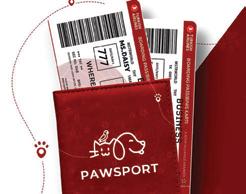
5 Turkish Airlines creates revolutionary pet passport
Turkish Airlines has o icially become the first airline in the world to create a dedicated pet passport. The “Pawsport” is designed to ensure pets’ comfort and well-being during air travel, as as a response to the growing demand for pet-friendly travel solutions among passengers.

6 Swissôtel launches in Georgia in Tbilisi Accor has opened Swissôtel Tbilisi, marking the premium debut in Georgia and the South Caucasus region. It was created by the renowned Sundukovy Sisters design and architecture studio, and features 130 rooms., three restaurants, and the Swissôtel signature Vitality Room.
1 14 UPFRONT GLOBAL NEWS MAY 2024


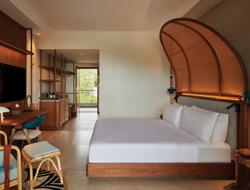
7 Hilton opens Canopy by Hilton Seychelles Hilton has made its debut in the Indian Ocean with Canopy by Hilton Seychelles south of Mahé.
The new 120-guestroom property is the brand’s first resort o ering in the world, located along Mahé’s Anse à la Mouche bay. It o ers three dining venues, three pools, and an airport transfer lounge.

8 Virgin Atlantic launches Bengaluru route and goes double daily on Mumbai
Virgin Atlantic is increasing its services to India, launching a new route to Bengaluru and confirming a second daily service to Mumbai from October 2024. Virgin celebrates its 40th anniversary in June, and next year will mark 25 years of its operations to India.

9 Radisson o ers bespoke amenities for Chinese guests at select EMEA properties
Aimed at encouraging Chinese travellers, the “Guan Xin” or Welcome China programme is an extension of the Radisson Hotel Group’s co-branding initiative with its owner Jin Jiang International, which launched in 2019 at the Radisson Blu Hotel, Frankfurt.
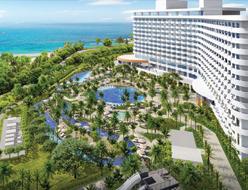
10 Accor to open 22 new hotels in Japan
Doubling its footprint in the country as it grows from 24 to 46 hotels overall, Accor has announced the opening of 22 new hotels and over 6,000 rooms in Japan. Comprising 12 Grand Mercure and 10 Mercure hotels, the hotels will range in locations from Hokkaido to Okinawa.
2 3 4 9 6 7 8 5 10 15 MAY 2024

CROWNING GLORY
IN DIRIYAH, A MODERN FUTURE ARISES UPON THE FOUNDATION OF A GREAT KINGDOM


Diriyah once stood as one of the most important cities in Arabia. A settlement with global signi cance. It was here, the home of the Al Saud family, where the rst great Saudi State was established and a kingdom was born. Its epic history and fate determined the course of peoples and empires far beyond Arabia – and its ancient roots and heritage are now being preserved and rediscovered in ways that will resonate across the world.
In 1446, Diriyah was established on the banks of the Wadi Hanifah and became the capital of the First Saudi State in 1727. Representing a turning point in the Arabian Peninsula’s history, it united most of the region under one state, ending fragmentation, rivalry, and insecurity.
Diriyah became a destination for trade, culture, knowledge, communication, and economic exchange. Diriyah was also a hub for trade and pilgrimage routes to di erent regions. Despite the complex desert environment, Diriyah became an oasis for a model society. Its peace and prosperity gave it a prominent political, economic, military, and religious place in the region, becoming a beacon of knowledge and education.
Company, stated that: “Success will be realised once Diriyah adds US$18.6 billion to the GDP, and creates 178,000 jobs.”
Since then, the Diriyah project has been busy, and the project is not only well on its way to realising those goals, it has even already made good on its promise to create a space that supports Saudi Arabia’s ascension to the global stage without ever losing sight of its cultural heritage.

Its roots and heritage are being rediscovered in ways that will resonate globally
e Diriyah project’s rst phase opened to the public in December 2022, welcoming guests to its At-Turaif District – a UNESCO World Heritage Site that encompasses the rst-ever capital of the Saudi Dynasty, which has been meticulously restored – along with its Bujairi Terrace, a 15,000 sqm premium dining destination boasting the nest international, regional, and local cuisine through more than 20 di erent restaurants and cafes, four of which are from Michelin-starred names.
A New Beginning
Diriyah’s rich past is full of heroic and memorable moments, which began from the migration of Mani’ Al-Muraydi in the 15th century to establish Diriyah, to the subsequent establishment of the First Saudi State in the beginning of the 18th century. As the cradle of the Saudi State, Diriyah is a beacon of the continuing legacy of the Royal Family (Al Saud), and its historic role in establishing stability and bringing prosperity with the active participation of citizens throughout the country – celebrating the achievements reached, from the time of Imam Mohammed bin Saud to the reign of King Salman bin Abdul Aziz today.
Business Traveller Middle East rst reported on the Diriyah project back in September 2022, when it was still in its early stages. At the time, Jerry Inzerillo, Group CEO at Diriyah



Now in its next phase, Diriyah is ful lling its commitment to foster a cultural renaissance. e historic city is now a vibrant hub that attracts visitors from around the globe not just for its incredible hospitality o erings and slice of history, but also for its rapidly emerging arts and cultural scene.
In December 2021, the Diriyah project hosted the very rst Saudi Ministry of Culture-led Diriyah Biennale, transforming the space through the creation of numerous art galleries and studios, and exhibition spaces. Its rst edition was a resounding success, attracting a large number of regional and international artists and visitors alike and being described as a seminal start to a new era of great art in the region. e biennale has returned again this year, with its second edition running from 20 Feb to 24 May, attracting talent from all over the world. From sculptures and paintings to interactive exhibitions and more, the event is a key highlight of this year’s cultural calendar both for the region and for art enthusiasts across the globe,




Diriyah, Saudi Arabia’s premier historical, cultural, and lifestyle destination, is a key component of Saudi Arabia’s Vision 2030. A short 15-minute drive from Riyadh’s city centre, this 14-square-kilometre development holds historical significance as the birthplace of the Kingdom of Saudi Arabia, dating back to 1727.

Its first major mixed-use commercial o ice and retail project, Zallal, is set to open in the first half of 2025 in the Bujairi District. Zallal's construction is now well underway and when completed, it will include two low-rise o ice buildings with a combined leasable area of approximately 6,000 sqm and 12 mixed retail and F&B outlets over an area of approximately 8,000 sqm. The project has already received very positive reactions from its prospective tenants, and advanced leasing negotiations are already well underway with several companies and organisations. Zallal is strategically located next to the popular Bujairi Terrace, and will benefit from proximity to a venue that already attracts thousands of visitors daily. The o ering is also near the recently completed Diriyah Art Futures, and soon-to-open Bab Samhan Hotel.






17 MAY 2024 COVER STORY
drawing in thousands of visitors while also generating significant revenue for local businesses.
But that’s only part of Diriyah’s cultural transformation. In December 2023, Diriyah, The City Of Earth, set the stage for the future with the inaugural Diriyah Company Bashayer Event. During two action-packed days, the company launched assets and unveiled new partnerships, paving the way for 2024 to be its most exciting year yet, and showcasing how Diriyah will become one of the world's greatest gathering places
Among the new projects that will be incorporating Diriyah’s distinct history-meets-modernity ethos – that preserves the past while looking to the future – are the jawdropping equestrian and golf facilities of the upcoming Royal Diriyah Equestrian and Polo Club, and Royal Diriyah Golf Club at Wadi Safar. The event saw the formal ground-breaking of the Royal Diriyah Equestian and Polo Club that will be home to the Diriyah Equestrian Festival – one of many new international events to be hosted in the area alongside the Formula E, world champion boxing matches, and a Diriyah Tennis Cup. The golf club is a 27-hole course being created by Greg Norman Course Design, that is intended to become one of the leading championship courses in the word, “on a par with Augusta and St Andrews,” according to Inzerillo. Golfing legend Greg Norman was present at the Bashayer Event, alongside VIP guests, to witness the grassing of the Driving Range and completion of the first nine holes of the Royal Diriyah Golf Club course that he designed.
Inaugurating the first of the city’s more than 41 hotels and forming a leading hospitality practice, the Bashayer Event also saw the ground-breaking of hotels with renowned partners Aman, Oberoi, and Six Senses. Ceremonial ground-breakings also took place for four additional luxury hotel offerings, including the launch of The Ritz-Carlton Diriyah, Address Diriyah, Capella Diriyah, and Four Seasons Hotel Diriyah.
Celebrating Diriyah’s heritage and role as a symbol of national pride and source of Saudi identity, Diriyah Art Futures – the kingdom’s first dedicated centre for digital arts – was showcased. Built in partnership with the Ministry of Culture, it will become a dynamic hub for creative exchange and production at the heart of Diriyah.
Royal Diriyah Opera House and The Arena Diriyah also used the Bashayer Event as the platform to announce a strategic partnership with world-renowned architectural firm Snøhetta to design the Royal Diriyah Opera House. Riyadh-based Syn Architects also contributed to the design, infusing the project with local expertise and a deep understanding of the region’s architectural heritage. A landmark collaboration, it underscores Diriyah’s commitment to fostering the highest standards of cultural and creative innovation, upholding the rich legacy of Najdi-style architecture and partnering with world-class experts to achieve the project’s ambitions.
The opera house’s design will create a seamless blend of heritage and modernity. Anchored on the city’s rich historical legacy, The Royal Diriyah Opera House will serve as a platform for a diverse programme of cultural performances, reinforcing Diriyah’s mission to facilitate cultural exchange and deepen community and artistic engagement and cooperation.

In December, Diriyah Company revealed what will be its most exciting year yet
Meanwhile, The Arena in Diriyah is designed for residents of the kingdom and visitors alike—and has been designed to embrace Nadji culture and its architectural heritage. It has been designed by awardwinning global architecture company HKS – the firm responsible for Copenhagen’s Royal Arena, Los Angeles’ SoFi Stadium, Minneapolis’s U.S. Bank Stadium, Texas’s AT&T Stadium, Saskatchewan’s Mosaic Stadium, and Sichuan’s Chengdu Phoenix Hill Sports Park.
The 20,000-capacity Arena’s design builds upon this legacy while setting the stage for a healthy and sustainable digitallyenabled future. The architecture features a composition of stone monoliths that evoke local geological formations and ancient Najdi forts and palaces as the Arena rises from this landscape, featuring a series of “digital waterfalls” comprised of a three-dimensional matrix of pixels cascading down the buildings surfaces and into the surrounding land. The multi-purpose Indoor Arena is suitable for concerts, basketball, acrobatic performances, and E-Sports events. It also features two Royal Suites, 27 VIP and VVIP suites, six GA & Premium Hospitality lounges, Retail, and numerous F&B spaces.
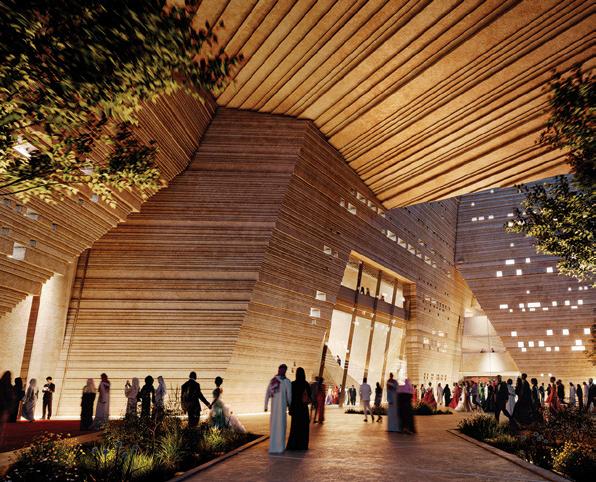
18 COVER STORY MAY 2024
BELOW: The Royal Diriyah Opera House, designed by a world-renowned team, will attract visitors from across the globe
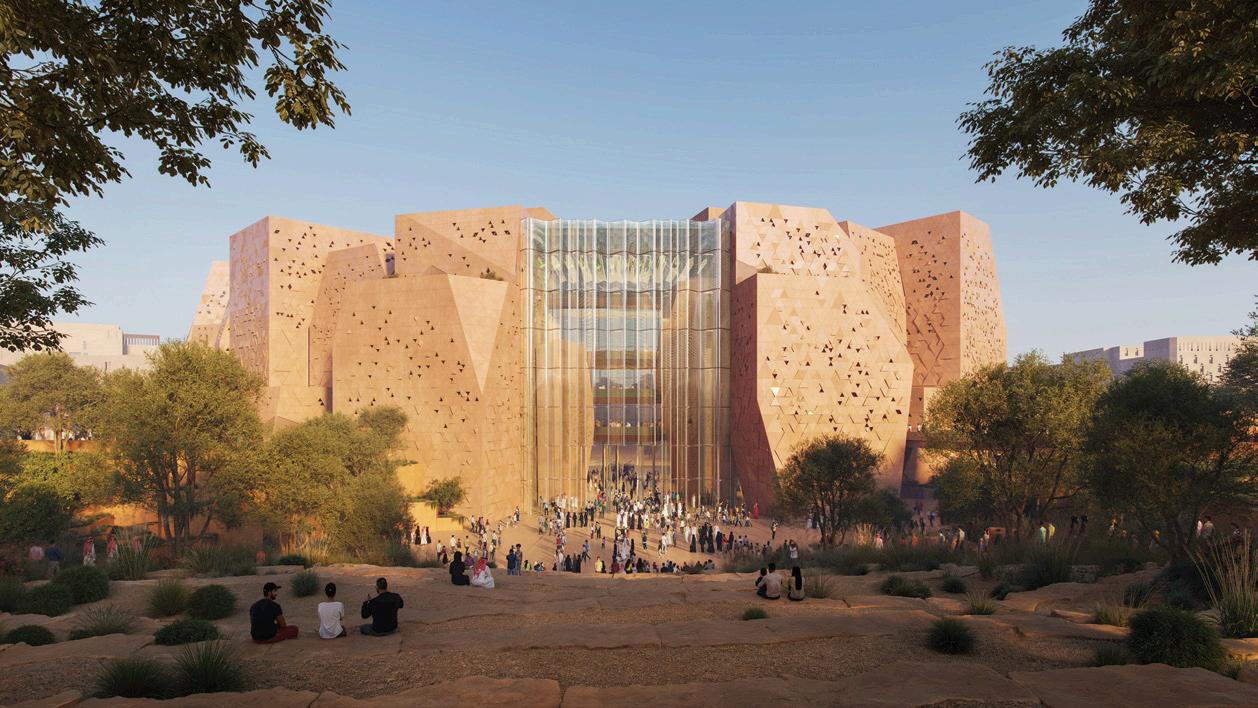
A Unique Destination
e Vision 2030 agenda is transforming Saudi Arabia as it unlocks its enormous potential, and its giga-projects are key to its success. As the kingdom’s economy expands, these new cities and destinations will form new centres of development and innovation, de ning the next chapter of its growth.
Diriyah is at the forefront of this national mission and holds a historic signi cance for the region comparable to that of Petra, Machu Picchu, or the Acropolis.
As the rst giga-project to open its doors to the public, Diriyah’s e orts are already yielding signi cant results. In just the rst six months of operation, it welcomed over a million visitors to the historic At-Turaif and the beautiful Bujairi Terrace. is early success is just a glimpse to the future and the grander developments yet to come. It is from the valley of Diriyah that the roots of the modern, dynamic, and in uential Kingdom of Saudi Arabia can be traced. Today, its redevelopment is an example of the progress made due to the Vision 2030 agenda.
A giga-project entirely rede nes an area. Building a city from the ground up takes a colossal amount of planning, skill, motivation, and talent. To do so in such a historically and nationally important place like Diriyah only adds to the complexity involved. As a leading symbol of the kingdom’s transformation, Diriyah stands as a tangible and inspiring testament to the vast potential being unleashed throughout the economy and among the population.
Projected to create 178,000 jobs by 2030 and contribute US$18.6 billion to the kingdom’s GDP, Diriyah’s economic impact is sizeable. Its development division, Diriyah Company, is wholly owned by the Public Investment Fund and is backed by a US$63.2 billion investment pipeline, reinforcing the government’s commitment to its success.
A
new gathering space for the world
Diriyah is creating and imagining a centre for cultural exchange that will welcome the world and appeal to the broadest spectrum of visitors. Spread across 14 square kilometres, it will be a hub for history, sports, cuisine, fashion, nature, and art enthusiasts, attracting travellers and residents passionate about immersing themselves in distinctive customs and traditions. e project is developing countless visitor experiences with museums, galleries, exhibitions, and installations that tell the story of Diriyah’s past and future.


45k
As a global gathering place, Diriyah is already emerging as an epicentre for events and cultural gatherings that unite visitors and residents in a shared love of connection and exchange. From the Diriyah Season – the annual event that brings Diriyah’s heritage to life through captivating events and experiences – to Saudi Arabia’s First Contemporary Art Biennale, e Saudi Design Festival, and Formula E, visitors have ocked here from all corners of the world. Diriyah is also a place for collaboration, growth, and innovation. From its role as the site of the virtual G20 presidency in 2020 to more recently hosting the UNESCO World Heritage Committee and MiSK Global Forum, Diriyah is a place for the world’s leaders to unite and chart a path toward a healthier and more prosperous future for us all.


1 78k
A community of 100,000 will also call Diriyah home by 2030. More than 300 luxury branded residences will o er residents the chance to live in a place that was the historic home of the rst Saudis. Immersed in the City of Earth’s authentic heritage and lifestyle, this component of Diriyah’s redevelopment is a further extension of the unique culture and community of the city and is a central part of the Diriyah vision to curate an unrivalled lifestyle o ering.
19 MAY 2024
ABOVE: Designed for residents of the kingdom and visitors alike, The Arena in Diriyah will have a total capacity of 20,000 people
The number of square metres the Royal Diriyah Opera House, to open by 2028, will cover
The number of jobs that the Diriyah project is projected to create for Saudi Arabia by 2030

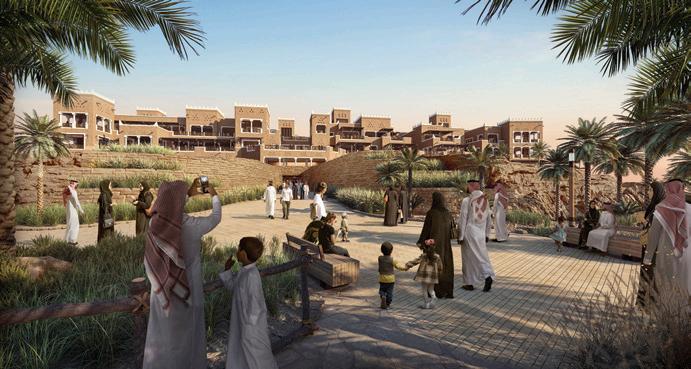
Truly a gathering place for the world, Diriyah is a place for all who value learning and community. By 2030, it is set to become a destination that captivates over 50 million visitors each year, becoming an irresistible landmark on the global travel map.
Diriyah has already started contributing significantly towards Saudi’s Vision 2030 initiative. Not only is it inspiring artists and creatives, it is also helping to diversify the economy, creating jobs, and attracting more foreign investments. As the project continues to unfold, it is expected to generate billions of dollars in revenue and create thousands of new career opportunities, particularly in the hospitality and tourism sectors. Already, Diriyah has attracted significant investment from both domestic and international partners. The Diriyah Company has secured partnerships with leading cultural institutions, architectural firms, and hospitality to bring its vision to life. The project has also received support from the private sector, with investments reaching US$6 billion by January 2024, ready to help expand the real estate, infrastructure, and technology that will support Diriyah’s growth.
In 2028, The King Salman Boulevard – Saudi Arabia's very own version of the Champs-Élysées (in the sense that it will be a lively, upscale shopping avenue that not only boasts the same vigour and sophistication as its French equivalent, but that will also be the exact same length and width as the famous Parisian destination) will also open right in the heart

Diriyah follows a “sustainabilityfirst” ethos, with native plant species planted, drought-resistant landscaping, various renewable energy sources, with these major efforts being globally recognised.
of Diriyah. The new world-class destination will be home to a number of dining outlets and attractions, as well as some of the world's biggest names in fashion and retail.
Diriyah follows an ethos of “thinking globally while acting locally,” which underpins its holistic and sustainable approach to redefining livability. Its goal of being a global smart city, where sustainability and technology go hand in hand, means the Diriyah project is always seeking new ways to lead by example. It is, by design, built on a “sustainability-first” ethos, aiming to redefine the norms of urban planning. Diriyah’s green spaces and public parks are all designed with environmental consciousness and a deep respect for its natural surroundings in mind.
Native plant species have been planted and droughtresistant landscaping techniques used to promote biodiversity and minimise water usage alike, while numerous buildings across Diriyah incorporate innovative structures and technology to help promote and sustain eco-friendly practices. The use of renewable energy sources to reduce reliance on fossil fuels is plentiful, from solar power to wind turbines, while efficient irrigation systems and greywater recycling will help to prioritise water conservation and mitigate the strain on local water resources.
In addition, the restoring and replanting of Wadi Hanifah – in which Diriyah Company nurtured more than 11,000 palm trees, planted 11,000 more indigenous trees and other vegetation – is creating a positive net climate impact. Diriyah aims to plant over 6.5 million plants, trees, and shrubs in the months and years ahead. The company has been rewarded for its efforts, having been internationally recognised with the first platinumlevel LEED for Cities and Communities in the Middle East. Diriyah is also enrolled in MOSTADAM, Saudi Arabia’s own sustainability certification programme.
But at Diriyah, with a pipeline of innovative and world -leading announcements to be revealed in its near future, it is clear that the immense potential of Diriyah and its rich legacy has only just begun to be unlocked.
“I am hugely proud of the work happening here,” said Inzerillo. “What has already been achieved, and the timeframe within which it has been achieved, is truly incredible. We are creating a living, breathing monument to the past that embraces the present and is also forwardlooking, and that encapsulates all that is best about Saudi Arabia, its past, and its future aspirations.”
Explaining that while the heart of Diriyah may be centuries-old, it has also seamlessly incorporated truly cutting-edge technology to create its groundbreaking future, Inzerillo also reminds us that The City of Earth has occupied a special place in the hearts and minds of Saudis for almost three hundred years.
“But we don’t only want you to hear about Diriyah from people like me – instead, we extend an invitation to the world to come and see it for themselves,” he said, continuing: “And I believe that Saudi Arabia is the most important story in global tourism today.”
20 COVER STORY MAY 2024
ABOVE: Wadi Hanifah BELOW: Zallal
DID YOU KNOW





Attractions
Activities

Dining
Health
Education
Entertainment
Real Estate



Hotels & Resorts
The






FOR ENQUIRIES: +971 4 427 3000 | sales@motivate.ae motivatemedia.com
OPPORTUNITIES AVAILABLE ON EMIRATES
NATIVE MARKETING
access to one of the largest, captivated
affluent audiences in the world, creating a unique opportunity to showcase your business.
‘Discover UAE’ channels on Emirates’ award-winning ice platform provide affordable
and
& Wellness
Accessible tourism: An ethical choice that’s also good for business
In today’s world, that increasingly sees the importance of inclusivity, accessibility is both a social responsibility and a wise business choice
Picture this scene: A tourist using a wheelchair arrives at a dive boat. Within an hour, she is 10m underwater, exploring a spectacular coral reef.
With webbed gloves serving as fins and assistance from an adaptive support diver, a person who has no use of her legs can scuba dive like anyone else.
More than one in six of us has a disability – that’s 1.3 billion people, or 16 per cent of all humanity. Yet historically, this huge share of the world’s population has been underserved or ignored by the tourism industry.
The rise of “accessible tourism”, which is already underway, will mark a new era in which people with disabilities and their families can enjoy the same travel and tourism opportunities as the rest of us.
Travel and tourism reflect the values of society as a whole, and with disability being an integral part of the human experience, we
must ensure that guests with disabilities are treated with dignity and fairness. This is a moral imperative.
Providing full access to people with disabilities also makes good business sense. The Valuable 500 cohort of global businesses estimates that people with disabilities represent an annual US$8 trillion of disposable income. That number swells to US$13 trillion when family members and friends are included.
In short, tourists with disabilities also represent a huge financial opportunity.
How, then, can tourism industry stakeholders ensure that their destinations fully welcome people with disabilities and benefit from the spending power of this underserved global community?
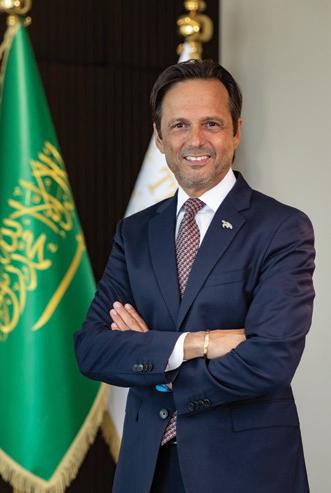
EMBEDDING ACCESSIBILITY IN FROM THE OUTSET
We must ensure that guests with disabilities are treated with dignity and fairness
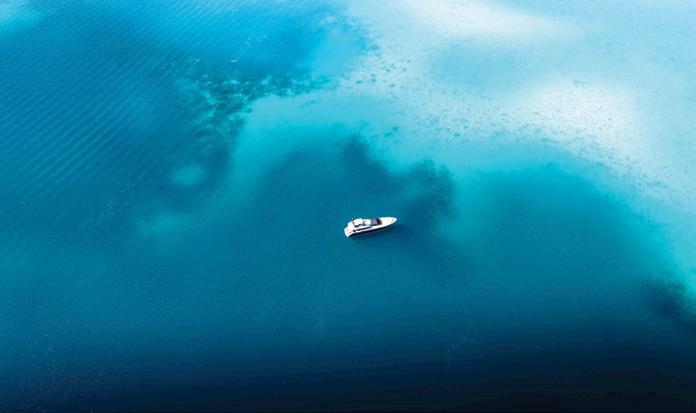
Accessibility can’t be an afterthought. Retrofitting existing facilities can be challenging and costly, though sometimes unavoidable, so a business should integrate accessibility from the beginning, in its master plan. Where possible, it’s also crucial to embrace the principles of accessible tourism when shaping the physical environment and to consider the customer experience from the start of each journey, especially with transportation. But embracing the principles of accessible tourism alone is not enough. To stand out from the competition, companies must also create unforgettable moments for visitors with disabilities and their families.
This can mean providing guests with adaptive equipment and partnering them with specially-trained instructors. Those who want to participate in water sports, for example, can now do so thanks to specialised gear such as adapted kayaks, sailboats, and stand-up paddle boards. Divers who can’t use their legs can wear neoprene gloves, webbed like duck’s feet, to propel themselves through the water. By investing in accessible experiences that soothe, excite, and inspire, tourism businesses can improve their ethical reputation as well as their bottom line. This is no time to make excuses. We have an occasion to do well by doing good, so let’s seize it.
MAY 2024
RED SEA GLOBAL
22 OPINION
JOHN PAGANO GROUP CEO OF RED SEA GLOBAL


THE RISING POTENTIAL OF THE UAE’S EXTENDED STAY MARKET














AWAY FROM HOME
The global extended stay hotel market is currently valued at US$54.5 billion, and is predicted to reach US$166.5 billion by 2032*. Once seen as just a temporary place to stay while in between certain phases of life, the extended-stays market – which includes hotel or serviced apartments and co-living situations that o er a blend of hotel amenities with home-like features such as kitchens, separate living and sleeping areas, laundry facilities, and more – has undergone a transformation in recent years. No longer just a place to stay while one

is moving to a new city or country (or in between home renovations), in today’s world, the serviced apartment has taken on a new lease of life. e shi has been bolstered by several factors, including the rise in remote and hybrid work, and the increasing amount of exibility and globalisation in the way we live, work, and travel.
Riyadh, London, and Singapore remain some of the world’s most popular locations for the extended stay market, but over the last year, the Middle East as a whole has witnessed an upsurge in demand. In Saudi Arabia, giga-projects including Diriyah, Neom, and Red
Sea include branded hotel residences as part of their recently-opened or upcoming o ering, such as the Aman Wadi Safar, Armani Hotel Diriyah, Apartments by Marriott Bonvoy Sindalah, e Chedi Trojena, and Four Seasons Resort and Residences AMAALA at Triple Bay, to name just some. e latter follows another successful residential project from Four Seasons in neighbouring Qatar, with the opening of Four Seasons e Pearl-Qatar at the end of 2023. e property – a 19-story vertical resort in a prime location – o ers 161 luxury seaside one-, two -, or three-bedroom apartments ranging from 105 to 280 sqm, and a whopping 60 per cent
WORDS YI-HWA HANNA
ABOVE AND BELOW: Baccarat Hotel & Residences 24

of its guests are long-staying visitors.
“Beyond providing exceptional experiences for short-term visitors, we’ve developed a distinctive rental programme catering to those relocating to Qatar for extended stays, as well as locals seeking a novel waterfront lifestyle,” said the property's general manager, Mehdi Zaanoun.
Meanwhile, in the UAE, new openings and developmental signings from Dubai and Abu Dhabi to Ras Al Khaimah reflect the increasing interest. In Ras Al Khaimah, Marjan Island is slated to be home to a new property with branded residences from the iconic Nobu Hotels brand, and a JW Marriott, as well as a new Address Residences. Last year, the InterContinental Residences Abu Dhabi opened in the capital, while Rove Hotels made its residential debut with Rove Home Aljada in Sharjah. In Dubai, a staggering amount of new luxury branded properties with residential offerings are set to open their doors in the next several years, with the long list of exciting names including Jumeirah Marsa Al Arab, Six Senses The Palm, Mama Shelter Dubai, Rixos Dubai Islands Hotel & Residences, Baccarat Hotel & Residences, InterContinental Residences Dubai Business Bay, Fairmont Dubai Skyline, Ciel Tower, Bulgari Hotels & Resorts’ Bulgari Lighthouse, and many more.
Long-standing serviced apartment brands are standing strong, with their
trusted reputations and seasoned know-how proving to be a boon amidst the heightened interest in the market. Vincent Miccolis, managing director of Middle East, Africa, Türkiye and India for The Ascott Limited – one of the world’s leading companies in serviced residences –reported a remarkable 40 per cent increase in long-stay bookings in 2023 across the brand’s portfolio in the Middle East, Africa, Türkiye, and Kazakhstan, compared to 2022.
“[In] 2024, we expect long-stay bookings to continue rising as we’ve already recorded a 28 per cent increase in long-term stays in Q1 2024 compared to Q1 2023. Most notably,

this year, we’ve observed a surge in long-term bookings from business travellers in our properties in Dubai, Riyadh, Al Khobar, Doha, Manama, and Nairobi. These are vital business hubs in the region for significant infrastructure projects and economic developments, and corporate workers are increasingly opting for extended stay accommodation. We’ve also witnessed an increase in long-term bookings from families seeking spacious accommodations in these popular destinations during medium to long-term holiday periods such as Eid Al-Fitr, Eid Al-Adha, and school breaks. The combination of the region’s growing business and leisure drivers has created demand for long-term stays amongst corporate travellers, leisure guests, and digital nomads,” Miccolis says, explaining that Ascott is well-placed to capitalise on this trend with its unique hotel-in-residence hybrid model, which combines many of the amenities and services offered by a hotel with the homely comforts and conveniences of a modern serviced apartment. Ascott achieved record success in terms of fee earnings and property openings in 2023, with nearly 9,600 units turning operational and 77 new properties across all brands also having been signed during the 2023 financial year.
 ABOVE: Apartments by Marriott Bonvoy
BELOW: Vincent Miccolis
ABOVE: Apartments by Marriott Bonvoy
BELOW: Vincent Miccolis
25 HOSPITALITY MAY 2024
BOTTOM: Apartment studio at Citadines Abha, Saudi Arabia

The UAE has topped rankings for the best places in the world for remote workers and digital nomads for the past few years consecutively. With the property boom in the Middle East’s real estate market having led to exceptionally high price points of late, a growing number of residents are also opting for hotel apartments rather than a traditional apartment rental, claiming that the former can offer them more convenience, less stress, and a strong sense of support and community. For many, the association of a trusted brand is another part of the appeal.
The rise of ‘bleisure’ has also seen numerous business travellers opt to extend their trips to incorporate some personal time, sometimes even bringing their loved ones along for the ride.
“The hotel apartment concept is particularly convenient for families with kids due to the inclusion of a kitchenette,” says Bruno Hivon, general manager of Staybridge Suites in Dubai’s Business Bay. Part of IHG Hotels & Resorts’ Suites collection, the property just opened this year. “Families traveling together can opt for the one-bedroom and two -bedroom units instead of interconnecting rooms, offering greater convenience and additional living space for comfort. Extended stays in hotel apartments are also ideal for individuals relocating into or out of Dubai, providing ample time to find


a suitable long-term accommodation, be it an apartment or villa, without the stress of making rushed decisions. Moreover, it’s an excellent option for individuals on short to medium-term assignments (one to six months or more) who prefer to travel light. The units are fully furnished and serviced, eliminating the need to sign leases or set up utilities like DEWA, making the experience much more convenient,” says Hivon.
Premier Inn – the UK’s largest hotel brand, which currently has seven locations in Dubai and two hotels in
Abu Dhabi – has also seen a recent uptick in interest. “Premier Inn Middle East has witnessed an increase in demand for long-stay accommodation in the market, likely influenced by Dubai’s rising rental prices. Our guests prioritise factors such as location, value for money, quality sleep, reliable internet, and good food and beverage options, all of which Premier Inn is renowned for,” says Eduard Jimenez, the brand’s regional commercial director.
“For many, our hotels serve as a temporary home upon arrival, offering flexibility and affordability without the commitment of a long-term lease or additional utility expenses. Through tailored offerings like monthly rates and F&B discounts, particularly during the summer months, Premier Inn caters to these needs, ensuring a seamless and comfortable experience for our guests,” Jimenez says.
With a 2024 Deloitte report on Middle East Real Estate Predictions noting a 1.4 per cent year-to-date increase in Dubai’s population, and the number of international tourist arrivals in the UAE forecast to increase by at least 17.3 million arrivals between 2024 and 2029, one thing is clear: Whether it’s from a serviced residences specialist, a luxury hotel brand, or a new player in the game, the extended stay market is one to keep an eye on in the coming years. Watch this space.
26 MAY 2024 HOSPITALITY *SOURCE: FUTURE MARKET INSIGHTS EXTENDED STAY HOTEL MARKET OUTLOOK 2023-2033
FROM TOP: The living room and a bedroom in Staybridge Suites; Bruno Hivon





























Raha Moharrak
Keynote speaker, graphic designer, and renowned alpinist
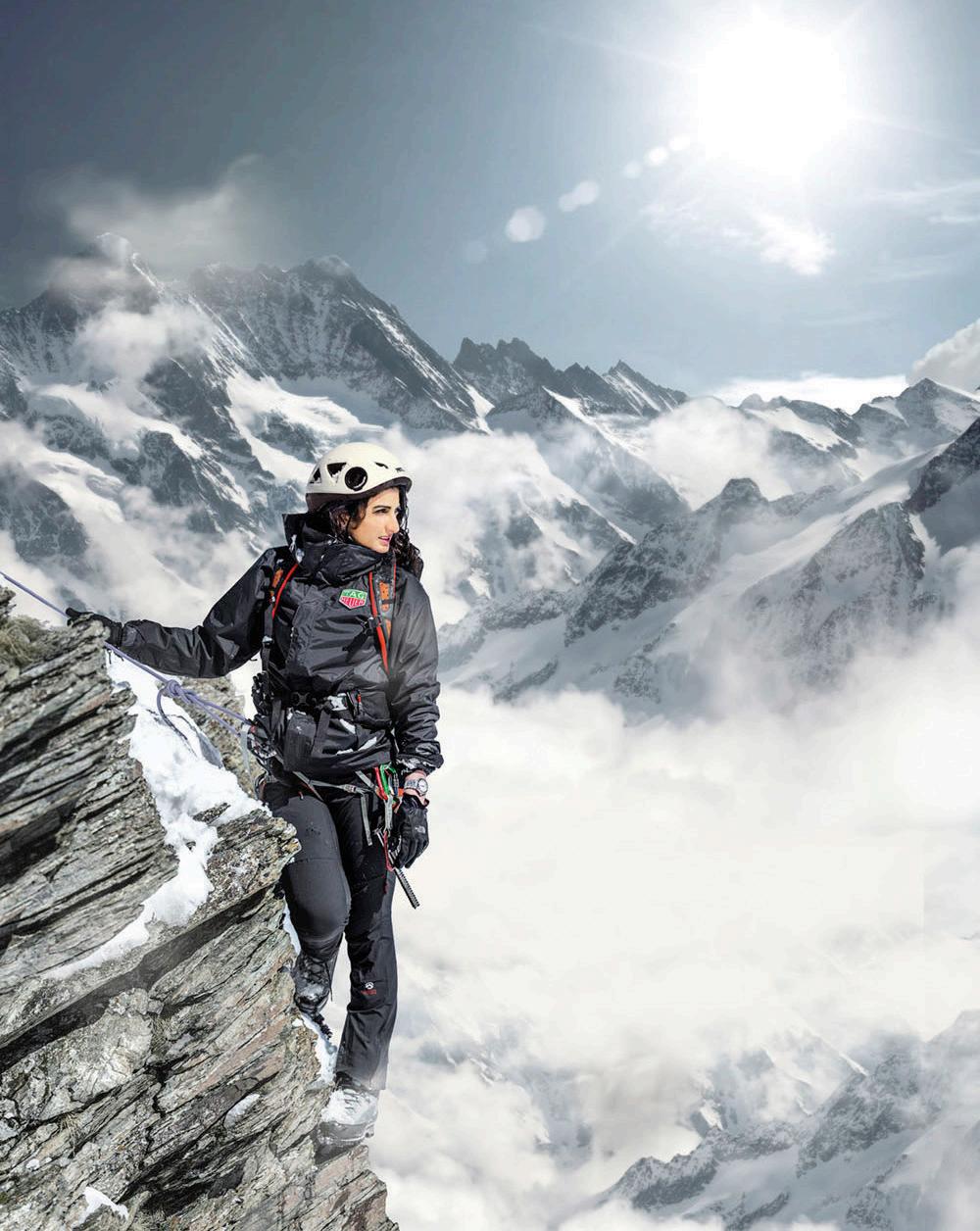
In 2013, you became the first Saudi and youngest Arab woman to have ever climbed Mount Everest. What motivated you? The desire to prove that boundaries are only in the mind, and to inspire other Arab women to dream big pushed me to encourage people to climb their own “Everest”, whatever it may be.
What was the best and worst part? The hardest part was battling the altitude, the elements and freezing temperatures – but the most amazing part was living my dream.
Which was the first mountain you ever climbed, and which others have you summited since then? My first mountain was Kilimanjaro. Since then, I’ve climbed the seven summits including Aconcagua, Vinson, Elbrus, and more.
Last year, you collaborated with adidas to take two other young women on that same Everest journey. What was the most powerful part of that for you? Witnessing their transformation, seeing them overcome challenges and embrace their strength, was incredibly empowering.
What is so special about mountain climbing? Mountain climbing challenges your limits, connects you with nature, and teaches
invaluable life lessons about perseverance and humility.
What is the biggest difference you’ve noticed in how the perception of Saudi Arabia, and Saudi people, has changed in the world in recent years? The shift in perception reflects the evolving understanding that diversity enriches our world, and that Saudi women are capable of extraordinary feats.
Why do you think this is? Increased exposure and dialogue foster understanding, breaking down stereotypes and fostering appreciation for diverse cultures.
What makes you proud to be a Saudi? The rich heritage, the resilience of its people, and the nation’s commitment to progress make me immensely proud.
Why do you think representation is important? Representation amplifies voices, dispels stereotypes, and fosters empathy, creating a more inclusive and understanding global community.
Saudi is currently realising an incredible vision for the future. What are you the most excited about in these years to come? I’m
INTERVIEW YI-HWA HANNA
excited to see the transformative impact of Vision 2030, especially in empowering women and diversifying the economy.
What’s the most important piece of advice you’d give to anyone wishing to climb a mountain? Respect the mountain, prepare diligently, and never underestimate the power of determination.
What are three things that you always pack in your suitcase? A camera for memories, a journal for reflections, and a good book or two for the downtime.
What are your top packing tips? Pack light, prioritise essentials, and invest in quality gear.
What is your earliest memory of a holiday as a child? Family gatherings filled with laughter, delicious food, and cherished moments.
What’s been your most memorable trip so far? Ah, that’s a tough one to pinpoint! While I’ve been fortunate to explore breathtaking destinations, what truly makes a trip memorable for me isn’t solely about the location. It’s the journey itself – the people I meet, the unexpected adventures, and the lessons learned along the way. Whether it’s navigating through cultural nuances in bustling cities or finding solace in the serenity of nature, each trip has left an indelible mark on my heart and mind. So, if I had to pick, I’d say every journey, with its unique blend of challenges and discoveries, holds its own place in my memory.
What is your go-to in-flight entertainment? Inspiring documentaries or mysteries.
How do you spend your air miles? I use them to explore new destinations or upgrade my travel experiences.
What’s a travel experience you’d rather forget? A challenging climb with unexpected weather conditions that tested my resilience and made me face my mortality a few times.
Ultimate bucket list destination? Japan! I love its history and Mount Fuji is the only mountain on my list that I’m dying to visit. If I can see the cherry blossoms as well, I would be over the moon.
COURTESY OF RAHA MOHARRAK 28 AIR MILES MAY 2024
THE
ELE TOR PITCH
Business Traveller Middle East gives Gregory Viaud, general manager of the Four Seasons Hotel Rabat at Kasr Al Bahr in Morocco, five minutes to pitch his property to prospective guests
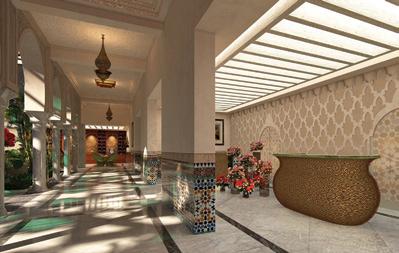
Four Seasons Hotel Rabat at Kasr Al Bahr is a brandnew opening and the third property within the Four Seasons Morocco collection, in the heart of Morocco’s royal capital. Being an international brand, Four Seasons brings a wealth of knowledge and expertise in hotels that surpass the expectations of guests in terms of luxury, service and accommodation.
I am personally very proud that we have kept so much of the architectural beauty of this historical landmark from the 18th century, which has been restored and reimagined as a luxurious oceanfront retreat. It was originally the 18th century palace that Sultan Moulay Slimane used as his summer residence, which was then transformed into a military hospital in 1912. Coupled with the curated services and bespoke experiences, every embellishment and detail reflects our dedication to luxury.
Guests will immediately feel relaxed as soon as they arrive at the former palace, with the spectacular gardens and water features creating a serene atmosphere – providing the perfect stepping stone to experience authentic local culture, enhanced by the heartfelt warmth of Four Seasons’ service.
The site has 11 buildings: five are newly built, three have been rebuilt to their original palatial splendour

following their use as the hospital, and three are original to the sultan era, which have been transformed into an incredible cigar bar, warcha lounge that will be a local workshop, a cultural centre, and the beautiful Sultan’s Riad.


Featuring 200 lavish rooms and suites, a selection of seven exquisite restaurants and lounges, an outdoor resort-style pool, an infinity-view pool, rejuvenating spa with a saltwater interior pool and Moroccan hammam, lush gardens, and expansive event spaces, this rich-heritage site offers unique and exclusive experiences for all discerning travellers. Guests have every possible amenity on site so those who wish for the ultimate relaxation can experience this all within our walls. There is no other hotel in Rabat that has taken luxury to the level we will be.
We want to position Rabat as a real culinary destination. The property boasts seven innovative food and drink concepts, including three signature restaurants led by the senior executive chef Sebastiano Spriveri, who has 30 years of experience with Four Seasons. Meanwhile, a stunning indoor saltwater pool is at the heart of
“We have kept so much of the beauty of this 18thcentury palace”
the hotel’s elegant spa complex, where wellness meets Moroccan authenticity, including a traditional Moroccan hammam, private treatment rooms, a full-service salon, and a 24-hour fitness centre with an outdoor terrace for yoga classes. The two outdoor pools are set amid the tranquil gardens that feature several breathtaking palm, olive, and citrus trees where guests will be enveloped in the scent of the famous Moroccan orange blossom.
Rabat is one of the country’s four Imperial cities. A true hidden gem, we are so excited to share this royal capital with the world so everyone can discover all of its history and culture while experiencing the worldclass hospitality that Four Seasons is renowned for. For me, it is the most beautiful city in Morocco – cultural, green, with beautiful lights and colours, and many famous landmarks. It has been recognised by UNESCO as a World Heritage Site and it is extremely easy to walk around while feeling as if you are away from the hustle and bustle of a big city. It is also a family-friendly destination where you can forget all your worries on the stunning promenade by the ocean.
Four Seasons Hotel Rabat at Kasr Al Bahr is an urban resort with all the facilities, that’s still close to the historical landmarks of the city. We aim to open in late summer 2024.
30 ELEVATOR PITCH MAY 2024

















FOR EVENT SPONSORSHIP, TABLE BOOKINGS AND GENERAL ENQUIRIES chaitali.khimji@motivate.ae | murali@motivate.ae WINNERS ANNOUNCED MAY 7, 2024 BusinessTraveller.com BusinessTravellerME BTMiddleEast #BTMEAwards SCAN TO VIEW REWARDING EXCELLENCE IN BUSINESS TRAVEL AND HOSPITALITY Presented by Vote processing partner In association with Sponsors Beverage partner
Disabled toilets used as storage cupboards, access ramps leading to steps, grab rails that can’t bear any weight – these are just some of the indignities faced by those who require accessible accommodation.
At its core, accessibility is a commitment to inclusivity, creating an environment where everyone feels welcomed, and where facilities and services can be used by all individuals.
It’s a sentiment that should be at the heart of hospitality, not to mention it’s enshrined by law – the UK Equality Act 2010 sets out obligations for hoteliers (and all businesses) to make reasonable adjustments to cater for disabled individuals, which includes the provision of accessible rooms and bathroom facilities.
And yet, nding appropriate accommodation can still be a huge challenge for large swathes of the population – 1.3 billion people are classi ed as disabled by the World Health Organization, with around 16 million people in the UK alone.
“ e problem is, if you’re disabled, it’s not one size ts all,” says Fiona Jarvis, CEO of Blue Badge Style, an organisation that promotes inclusion in hospitality.
“It’s no good hotels saying ‘we’re accessible’ or having the wheelchair symbol, because it doesn’t mean anything to anyone really,” she adds. “One person might be ambulant, ie, walking with sticks, and someone else might be in a wheelchair, or an electric wheelchair, which both have very di erent needs. I need to know the height of the toilet, where the ramp rails are around the toilet, where the grab rails are in the shower. When they say walk-in shower, or an accessible shower, I need to be sure there is no lip to get my wheelchair over.”
It’s an issue Jarvis has been battling for years. In 2016, she co-founded e Blue Badge Access Awards with Robin Sheppard, president of Bespoke Hotels, which is dedicated to highlighting the hotels, restaurants, bars and others in hospitality who



Equal access




The aviation industry is dealing with improving accessibility for all travellers. Here, we shine a spotlight on the hotels working to do the same




are getting it right. ankfully, things are getting better.
Sheppard says: “We’re thrilled with the response to our 2023 Awards. A er eight years of trying to persuade the hospitality industry to put “access” higher up their collective agenda, I am delighted to say that this year’s award ceremony is testament to the progress that has been made.” is year’s winners included the Kimpton Fitzroy in London, which won the category for Best Luxury Hotel. “ e Kimpton Fitzroy is a listed building and it has a beautiful Sesame li at the front entrance. e stairs disappear, a platform appears, you get li ed up, and

then the stairs come out again. So it keeps the historical value of the building but they have also approached accessibility in an elegant way, with no ugly, steep ramps to get round,” explains Jarvis. Others getting it right include the new Ra es London at the OWO,
32 ACCESSIBLE HOTELS MAY 2024 THIS
WORDS TAMSIN COCKS
SPREAD: People with accessibility needs will find thoughtful design and facilities at Hotel Brooklyn



I recently went to the US and it was a real nightmare planning a business trip
which has a total of four Sesame lifts in the property – something Jarvis describes as “unheard of”. She also highlights the Dorsett Hotel in Shepherd’s Bush for having 25 accessible rooms with integrated ramps on each floor.
But while some properties might be getting it right, lack of information about the facilities is a serious barrier in itself. Having detailed information is incredibly important, for those with accessibility needs to be able to plan their trip and ensure their specific requirements are met. “I recently went to the US and it
MAY 2024 KOH SZE KIAT/GETTY IMAGES; HENRY WOIDE 2020
was a real nightmare planning a business trip. Getting photos of hotel rooms takes a lot of effort because people are reluctant to let photos go of the hotel that aren’t approved by marketing,” says Jarvis.
ACCESS FOR ALL
Physical accessibility is perhaps the most visible aspect, but hotels should also be considering sensory accessibility – for instance braille signage, audio descriptions, or visual fire alarms for guests with hearing impairments. Creating quiet zones or designated areas for relaxation can benefit guests with sensory sensitivities or neurodiverse conditions, providing them with a space to unwind away from the hustle and bustle of the hotel environment.
“Cognitive issues are important in hotels,” agrees Jarvis. “Particularly if you have a brand style that maybe has crazy wallpaper everywhere –someone who is autistic or even has epilepsy might find that very difficult to deal with”.
One such group addressing neurodiversity needs is Malmaison & Hotel du Vin, owned by Frasers Hospitality, which has launched a partnership with The Brain Charity to foster a more inclusive society for the one in six people in the UK affected by a neurological condition, such as autism, ADHD, dyslexia, stroke, or dementia.
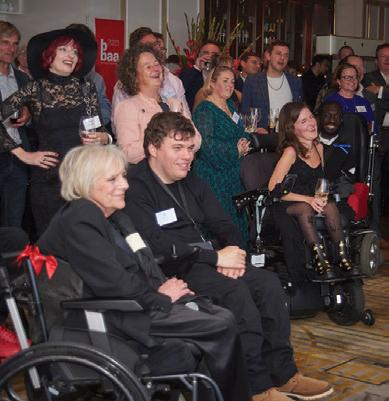

Scott Harper, COO for Malmaison & Hotel du Vin, said: “Together with The Brain Charity, we are committed to championing neurodiversity and raising awareness with our staff and customers to foster a more inclusive experience, not only in our properties, but to set a precedent for the hospitality industry as a whole.”
Martyn Ball, director of people and development at Frasers Hospitality, added: “Neurodiverse guests can face a range of challenges in a hotel environment, from sensory sensitivities to difficulties with communication and social interactions. As part of the partnership with The Brain Charity, our teams undergo dedicated neurodiversity training to better understand and support the needs of neurodiverse colleagues and
Investing in smart room technology can enhance hotel stays for all guests
guests. This training includes tips on adapting communication styles, to raising awareness of the diversity of neurodivergent conditions and how they present.”
In today’s digital age, offering technological accessibility is also becoming increasingly important. Hotels should ensure that websites and booking platforms are designed to be accessible to individuals using assistive technologies such as screen readers or speech recognition.
In-room technology should also be intuitive and user-friendly, with features like adjustable font sizes, closed-captioning options and
34 ACCESSIBLE HOTELS MAY 2024 NATHANIEL DAVIES; TOM MANNION 2018

voice-activated controls. Investing in smart room technology can enhance hotel stays for all guests. Features like remote-controlled lighting, temperature and entertainment systems can benefit guests with mobility impairments or other disabilities as well as non-disabled guests, allowing them to control their environment with ease.
THE PURPLE POUND
Aside from moral failings, hotels that fail to provide accessible facilities are missing out on a serious business opportunity. The “Purple Pound” –the spending power of the disabled community – is currently valued to be around £274 billion in the UK. This figure is only set to increase with ageing populations, and it’s also worth noting that not only do those with disabilities tend to travel in larger groups – meaning a bigger spend per stay – but they also show increased loyalty to properties that cater to their needs.
Jarvis recalls a time when she had booked an accessible room for a family get-together at Christmas. On arrival, the hotel informed her that the room she had booked had a flood and she had been moved to another accessible room.
Unfortunately the new room did not fit the specifications. The result? The whole family had to go home on Christmas day. “Because I couldn’t stay, they lost four rooms,” she adds – underlining the business case.
One property that is reaping the benefits of accommodating disabled travellers is Hotel Brooklyn based in Manchester (set to be rebranded as a voco hotel this summer). Making the disabled guest experience as independent and inclusive as possible was a key objective for the property.
CLOCKWISE FROM TOP LEFT: Sesame lift entrance and beautiful accessible rooms at Kimpton Fitzroy; Fiona Jarvis and others gather at the Blue Badge Access Awards
We have proven that beautifully designed accessible hotel rooms can be the most popular
To realise this vision, the group engaged inclusive design specialists, Motionspot, to design and supply 18 accessible suites and build attractive features throughout the communal areas, which include conference rooms, a restaurant, bar and mini cinema.
Features include ceiling track hoists subtly concealed in light fittings, removable matte-black grab rails and shower seats that can be removed when not required by
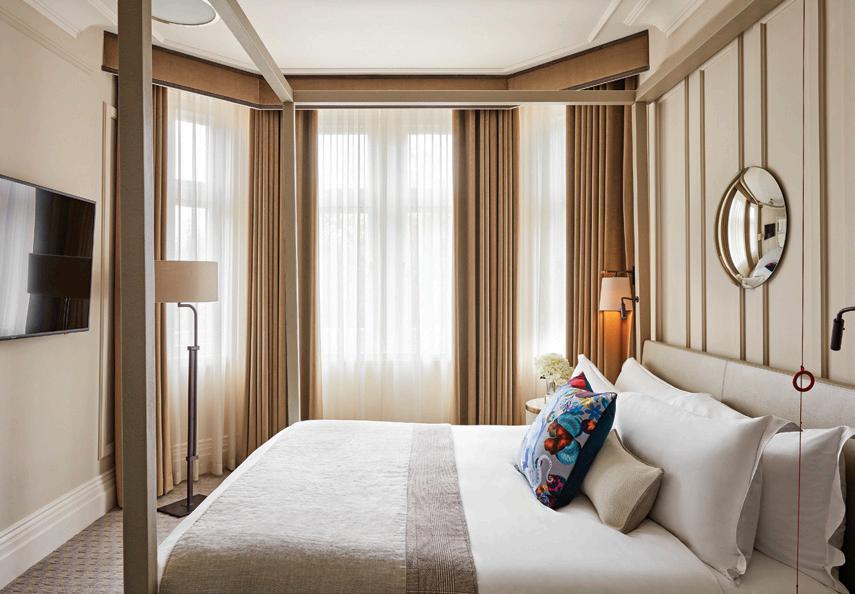
disabled guests, electric curtains that can be controlled from bedside panels, and interconnecting rooms for family or carer access.
According to the hotel, its investment into accessible facilities delivered additional revenue of £217,000 in 2022. While £132,000 of this came from accessible overnight accommodation bookings, a further £85,000 was created from accessible events bookings, from charity dinners to weddings.
Ed Warner, CEO and co-founder of Motionspot, said: “Too often, accessible rooms feature second-rate design and are less desirable, but at Hotel Brooklyn we have proven that the beautifully designed accessible rooms can be the most popular in the hotel. Making accommodation more accessible is not just the right thing to do, but it also makes good business sense.” In an era where diversity and inclusion are valued

more than ever, accessibility in hotels is not just a legal obligation but a moral imperative and a business opportunity. By prioritising accessibility in all its forms – physical, sensory and technological – hotels can create environments where every guest feels welcomed, valued, and able to fully participate in the hotel experience. In doing so, they not only meet the needs of diverse travellers, but also elevate the standard of hospitality for all.
35 MAY 2024
The inside scoop
Where will the travel capitals of the future be? We talk to Muzzammil
Ahussain, CEO of Almosafer,
Reports show that people are craving travel to more little-known locations. Why do you think this is?
With travel at its peak post-pandemic, there is a certain fatigue that has set in among intrepid travellers with regards to popular holiday destinations. People today crave the unknown, the thrill of exploring the less-travelled road, since it offers them a once-in-a lifetime opportunity to discover virgin territories. It is also, in many ways, less expensive to travel away from popular destinations that can get crowded during peak season. This trend also explains the renewed interest in Saudi Arabia, with tourists seeking cultural experiences provided by our UNESCO site Diriyah, AlUla, and Umluj.
Is this a regional or global trend?
Both. Internationally, we have seen more people eyeing luxury getaways and experiential tourism across the wider GCC, Europe, and Asia, with trending destinations including Turkey and Thailand, fuelled by easy visa accessibility. Saudi Arabia offers international as well as domestic travellers a chance to immerse themselves in authentic experiences. As per our domestic data trend revealed at the 2024 Saudi Tourism Forum, over 40 per cent of the total bookings on Almosafer are from the domestic market. Among the top growing destinations in the Kingdom, AlUla is the preferred luxury option; Jazan and Tabuk are winter favourites, and Abha is a popular destination for families to spend the summer break. Riyadh, Jeddah, Dammam, and Makkah and Madinah remain the most popular destinations in terms of room nights sold.
What makes the Middle East so appealing to global travellers now?
The Middle East has always had an aura of mystique for intrepid travellers across the years. Today it’s become a global hub for international travel, with the top three global
to find out
airlines headquartered out of the Middle East. It enjoys a geographical dividend, being centrally located in the global flight path and juxtaposed by huge demographic catchments on both sides. Global travellers are also attracted by the perfect balance of culture and modernity. With the opening up of Saudi Arabia, international tourists are making a beeline for the country, attracted by its rich cultural heritage and the development of experiential tourism.
What other factors matter to the average modern traveller?
The modern traveller is a conscious traveller. With greater awareness and interest in sustainable tourism, many are actively seeking to immerse themselves in authentic experiences, which is what many of Saudi Arabia’s homegrown tourist attractions like AlUla and the Red Sea offer. Almosafer’s data also shows that travellers are willing to spend money on luxurious accommodations.
How do the Middle Eastern consumer’s preferences differ from those elsewhere in the world?
The Middle East consumer is today spoilt for choice as far as travel is concerned. They are already used to a global standard of service in their countries, and our research has shown they don’t mind spending on luxurious stays even if they prefer budget flights to their destinations. They enjoy the best in hospitality and travel services, and they are not willing to compromise on these.
What are your predictions for the hottest travel spots of the future?
With governments worldwide focusing on tourism to fuel their economic growth, there is currently a spurt in budgetary allocation into the sector. As such, who is to say? Many of the historic as well as trending current travel destinations could be reinvigorated to meet the demands of the future travellers. On a
lighter note, space is the new frontier for those seeking an out-of-this-world experience. Speaking of futuristic travel, with its pristine beaches, majestic mountains and vast unexplored deserts, Neom is the next tech-luxury hospitality destination. With a key focus on sustainable tourism, there will also be a renewed interest in places that offer not just a spectacular experience, but also one that caters to the conscious traveller, with mindfulness and mutual respect of the biodiversity of nature. If other countries follow the example of Saudi, there is no reason why the hottest travel destinations of the future won’t emerge from one of the existing emerging markets be it Global South or New Europe.
What’s your favourite destination?
I truly enjoy travelling whether for work or with my family, and have been to over 40 countries so far, so picking one is really hard. Undoubtedly within Saudi Arabia, my absolute favourite spot to visit is Makkah. Saudi Arabia’s luxury tourism sector is booming and I look forward to visiting the Red Sea, where luxury, sustainability and innovation meet to offer a spectacular experience. In Europe, I really enjoy visiting London, especially during summer when it can get really warm here in the region.
What would you never travel without?
The Almosafer app for one! It’s part of my essential travel apps and helps to keep me updated on live flight status, which is crucial, living as we do at an age where time is of great premium. The nature of my job requires me to stay connected 24/7, so needless to say my laptop goes wherever I do. Comfortable loafers are another must, especially considering all the walking we need to do within airports as well as outside.
MUZZAMMIL AHUSSAIN CEO OF ALMOSAFER
 Almosafer is Saudi Arabia’s leading travel company. Its portfolio caters to every vertical across the travel and tourism ecosystem.
Almosafer is Saudi Arabia’s leading travel company. Its portfolio caters to every vertical across the travel and tourism ecosystem.
36 THE INTERVIEW MAY 2024



AFTERNOON
Just a short walk further down the boulevard, you’ll nd the Old Batumi Port. ere are plenty of bars and restaurants here from which to enjoy a bite with a seaside view, whether that’s before or a er you’ve had a chance to enjoy a tour in the Argo Cable Car. It will take you up to the top of Anuria Mountain, giving you spectacular views of the city and the sea from about 250m above sea level, with a one-way journey up taking about 15 minutes.
Batumi


Famous for its historical buildings and unique architecture that boasts an inherent love for art and design, the Black Sea resort and port city of Batumi, Georgia, is a popular spot for lovers of the seaside, and an up-and-coming regional MICE destination
MORNING
Start your day with a hearty breakfast at Ajarian House, a beautiful restaurant near the lush gardens surrounding Ardagani lake, that o ers a picturesque way to start your day. e restaurant serves traditional Ajarian food, which is slightly di erent from regular Georgian food. It’s a great way to settle into the culture of Batumi, which is the capital of the Autonomous Republic of Adjara – a region in the west of the country. Although it certainly doesn’t make for a light meal, an Adjarian Khachapuri is a must-try: like the regular khachapuri that can be found across the rest of Georgia, this is also a pillowy boat-shaped bread that’s stu ed with cheese, the Adjarian version adds a generous heaping of butter and an egg yolk in the middle, for a result that is immensely avourful and so moreish you’ll wipe your plate clean.
Next, walk o your meal with a stroll along Batumi Boulevard, with views of Batumi’s famous coastline, is sevenkilometre strip will not only wake you up with some fresh, salty sea air, but it’ll also give you a chance to check out some of the interesting artwork on display – the city is famous for its street art. Make your way from the Dancing Fountains to Europe Square, where you can see Batumi’s famous Ali & Nino statue. Also known as “ e Statue of
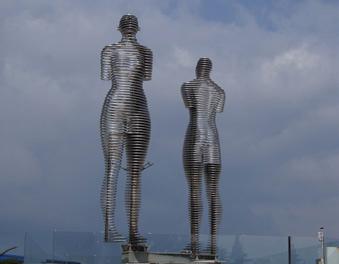
(pictured above), a 7-foot tall kinetic sculpture created by Georgian artist Tamara Kvesitadze that moves constantly in gradual motion, until the two gures depicted join together as one, before separating again, over the course of 10 minutes each time. It depicts a story written by an author writing under the pseudonym of Kurban Said, of star-crossed lovers Ali – a Muslim Azerbaijani boy of noble descent – and Nino – a Christian Georgian princess – who fell in love despite the societal constraints keeping them apart between 1918-1920, and were separated by war before spending eternity searching for each other. Other notable monuments include the nearby 130-metre high Alphabetic Tower, the Batumi Tower with its in-built ferris wheel, the 19th-century Batumi Lighthouse, and Chacha Tower.
If you’re feeling tired and want to relax, this is an ideal time to head down to the old city, where you can enjoy the shops, picking up a few souvenirs, from traditional handicra s to some famous Georgian wine, or local Imereti (also known as Imeruli) cheese.
If you still have the time and energy for a bit of adventure, however, two ideal spots for a mini-excursion include the Batumi Botanical Gardens – a 108-hectare area of land a 17-18km (or roughly 30-40 minute taxi ride) away from the Argo Cable Car that is not only one of the largest botanical gardens in the former Soviet Union, but also one of the most stunning – or one of the nearby vineyards, such as Beridze Wine Cellar in Makhinjauri, a 7.5km or roughly 15 minute taxi ride away.
EVENING
Wind down your evening by returning to the Old Town, where you can tuck into a last serving of delicious, authentic Georgian food at beloved restaurant Heart of Batumi. A er your meal, stroll to the nearby Batumi Piazza Square, where you can see its beautiful clock tower – which also houses a boutique hotel – and the many gorgeous decorative stained-glass windows and mosaics that surround it. Enjoy a nightcap at one of the restaurants in the open-air terrace are of the square, where you can watch locals enjoy whatever entertainment is being o ered that evening, from peaceful live music, to the opportunity to dance the night away.
 Love”
Love”
DMYTRO KOSMENKO/ADOBE STOCK; YI-HWA HANNA 37 DESTINATION MAY 2024
WORDS YI-HWA HANNA
flydubai flies a round-trip from Dubai to Batumi during the summer, from Dhs975
Beyond Convention
Expanding the horizons of a growing MICE market

In 2019, according to the Global Business Travel Association (GBTA), MICE (Meetings, Conferences, Incentives, and Exhibitions) travel contributed more than US$1.5 trillion annually to the global economy. The industry was on a steady upward trajectory, not only supporting hundreds of jobs through the actual events themselves, but also contributing large amounts to the host country’s GDP, and offering a major boost to the travel industry through airlines, hotels, and the various hospitality elements that would stand to gain from the foot traffic along the way. And then the COVID-19 pandemic hit.
The global travel and hospitality industry lost US$925 billion in 2020, yet despite the fact that business events – with MICE travel
as a key part of that – were forced to all but grind to a halt, people still hoped to be able to travel. And within a year after the effects of the pandemic started to wane, surveys already showed that people were increasingly willing to travel, especially for programmes that were “worth it”.
Although businesses across the world adapted to the rise of virtual meetings and remote work in the wake of the pandemic, the allure of face-to-face interactions remains unmatched. In 2024, thanks to this burgeoning demand for meetings in propria persona, and a renewed appreciation for in-person engagement, MICE travel has become an even more vital component of the global business landscape. From industry conferences to trade shows, corporate retreats, and everything in between, the demand for events that can offer
multiple networking opportunities while allowing attendees to close numerous deals under one roof has surged, fuelled by pent-up demand and the appeal of forging stronger and more meaningful new connections in an increasingly globalised world. Today, the MICE tourism market has bounced back with force, valued at $US42.8 billion in 2022, and with a 7 per cent compound annual growth rate predicted for the next decade. The market is currently estimated to be worth US$83.9 billion by 2032.
As the boundaries between work and leisure continue to blur with the rise of “bleisure” travel, business travellers are also increasingly extending their business trips to incorporate personal as well as professional gain. The modern business traveller inceasingly hopes to maximise their time
WORDS
.SHOCK/ADOBE STOCK
YI-HWA HANNA
MAY 2024
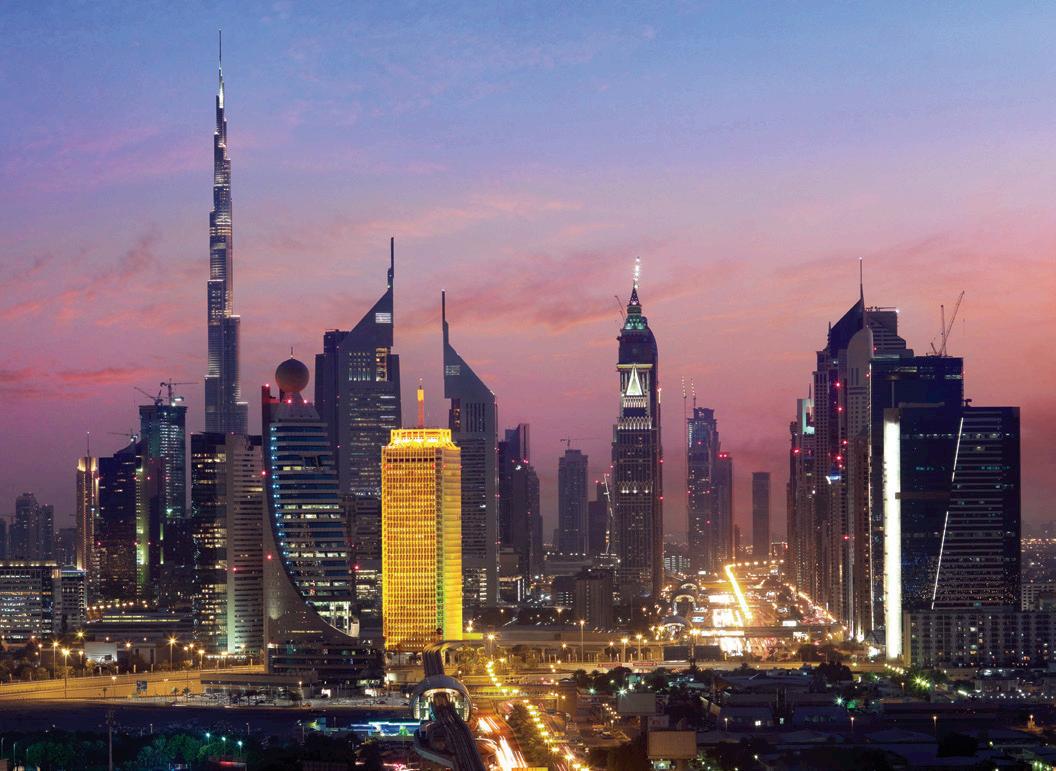
for business networking and striking deals, while simultaneously carving out chances to explore places beyond the convention halls – particularly those with an authentic cultural aspect, alongside a bit of recreation – and giving businesses in related industries new opportunities to showcase their unique o erings. e international meetings market is estimated to be worth US$2,330 billion by 2026, and countries from the UAE to Japan have been investing in new infrastructure to support this growth. Locations such as Las Vegas, London, Berlin, Vienna, Paris, Singapore, and São Paulo have historically been among the world’s best destinations for MICE travel, and with this resurgence, their appeal is still going strong. But there’s also a new crop of destinations rising in the ranks. Here, we explore some of the global locations proving to be a boon for this lucrative market, and vice versa.

Dubai, UAE
Established in 1979, the Dubai World Trade Centre (DWTC) celebrated its 45th anniversary this year. e building, commissioned by the late Sheikh Rashid bin Saeed Al Maktoum and designed by British architect John Harris – and inaugurated by Queen Elizabeth II – hosts the region’s leading MICE events around key sectors including travel and tourism, technology and innovation, healthcare, energy and sustainability, food and beverage, and hospitality. In 2022, it generated Dhs13 billion in economic output, of which Dhs7.4 billion was retained within the local economy, through 63 large-scale events. In 2023, it added 33 new events, hosted a total of 301 exhibitions and events, and welcomed 2.47 million visitors – and its portfolio only continues to grow from strength to strength.
Its 2024 calendar includes 70 shows during the rst half of the year alone, with a number of its events not only surpassing their pandemic recovery levels, but also breaking new records.
Among these events, the food, hotel, and catering sectors are among its top three, while the Arabian Travel Market – the leading global event for both the inbound and outbound travel industry in the Middle East – is experiencing a 29 per cent year-on-year growth. More than 40,000 people – including 30,000 visitors – attended last year’s event, and this year’s, held from 6 to 9 May, is expected to surpass these gures. DWTC was also named the World’s Best Convention Center at the 2023 World MICE Awards.
Meanwhile, the UAE’s capital is also up and coming, with Abu Dhabi recently having been named the Middle East’s leading destination for MICE events by the International Congress and Convention Association (ICCA).
DUBAI WORLD TRADE CENTRE
39 MAY 2024 DESTINATION

Doha, Qatar
In 2023, the National Museum of Qatar was named Best MICE Event Venue at the World MICE Awards. With the 2022 FIFA World Cup having shown how Qatar can handle world-class large-scale events, and an ever-growing list of venues with state-ofthe-art facilities, outstanding hotels, and a rich cultural o ering alongside that, Doha’s potential as a MICE destination is only starting to scratch the surface. Supported by an expansive destination list through its national airline, Qatar Airways – and the award-winning Hamad International airport, which has been recognised by the Airports Council International (ACI) as the second most-connected airport in the Middle East – Qatar’s capital and main nancial hub is set to become another rising star for MICE travel in the region and beyond.



Riyadh, Saudi Arabia
With its strategic location at the crossroads of Europe, Africa, and Asia, and as one of the Middle East’s most exciting new travel and tourism destinations of the future, Saudi Arabia is also one to watch for MICE travel. e kingdom’s MICE market was valued at US$2.33 billion in 2023, and is expected to reach US$4.84 billion by 2030, plus continue growing at a CAGR of 11 per cent by 2030. Supported by the country’s Vision 2030 initiative, governmental support to develop the industry, and major investments in its travel and tourism sector – including plenty of new infrastructure with cuttingedge technology and forward-thinking design – and the country’s considerable e orts in economic diversi cation, the kingdom is forecasted to attract countless more business travellers from the globe in the coming years. Amidst its impressive and speedy growth, it’s anticipated that Saudi Arabia’s MICE industry will o er multiple opportunities for revenue generation across the travel, tourism, hotels, and hospitality sectors, not to mention many new jobs.
BOULE1301/ADOBE STOCK; MAYA SIDDIQUI/GETTY IMAGES 40 DESTINATION MAY 2024

Madrid, Spain
Barcelona has traditionally been known as one of the world’s best destinations for business travellers, particularly those who are looking to easily slip in a bit of culture, sightseeing, and great food alongside their work trips – but in recent years, Madrid has also become a fantastic location for MICE travel in Spain. In 2021, it was named the World’s Leading Meetings and Conference Destination at the World Travel Awards, and in 2024, it was named Europe’s Leading Meetings and Conferences Destination at the European World Travel Awards for the seventh year in a row. Renowned for the quality and professionalism of the di erent sectors contributing to a great MICE experience, the city’s varied and expansive business environment is bolstered by an amazing selection of gastronomical options, and a wide and diverse range of cultural attractions that are easy to explore. ere are also an immense amount of event and exhibition spaces that can cater to a wide range of occasions at
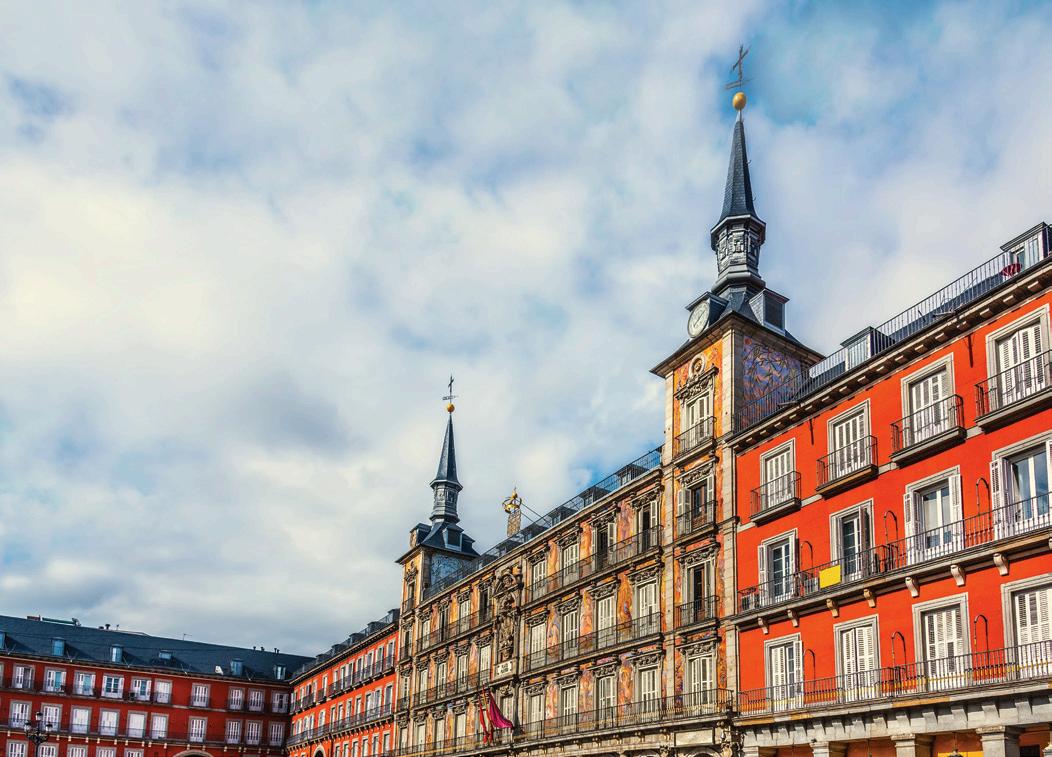

Tokyo, Japan
With a wide range of convention centres and exhibition halls, a highly-e cient metro system, two key airports, and a wide range of hotels for all styles and budgets – not to mention a large list of new hotel properties
di erent scopes, including the acclaimed IFEMA Madrid, which welcomes around 2.5 million visitors a year. Established in 1980, it boasts more than 230,000 sqm of combined exhibition space – split into 200,000 sqm of indoor space and 1 million sqm of outdoor space with 12 exhibition halls, two auditoriums, two congress centres, and 80+ meeting rooms – as well as 14,000 parking spaces and a connected metro station, all easily connected to both the city centre as well as the airport.
currently opening and set to open – Japan’s capital is a city built for MICE travel. From the 5,012-seat Tokyo International Forum – which is described as one of the world’s leading grand halls – and the 140 -tall octagonal Nippon Budokan (which can hold almost 14,500 people), to the Tokyo Big

Sight (which has a total exhibition area of 115,420 sqm), Frank Lloyd Wright-designed Jiyu Gakuen Myonichikinan, and many more, the events, exhibitions, conventions, and related industries are spoilt for choice in this bustling metropolis. e city is also developing a new Shinagawa Station, with a 25,000 sqm site that will house a large new international conference centre and a number of hotels and o ces, currently set to complete the bulk of its construction by 2027. While Japan has already historically been known as a popular destination for business travellers from Asian countries, thanks to a number of new initiatives aimed to strengthen its business and economic ties with the Middle East – and the UAE, Saudi Arabia, and Qatar in particular – the Land of the Rising Sun is certainly one to watch for new opportunities for business travel from the region.
GABRIELE MALTINTI, HIT1912/ADOBE STOCK 41 MAY 2024


Marrakech, Morocco
In 2023, a historic MICE event took place: the inaugural edition of GITEX Africa, which was the international debut of the globally-renowned tech show that began at the UAE’s Dubai World Trade Centre in 1981 – making it one of the world’s longestrunning tech exhibitions, as well as one of the largest. Its debut in Morocco was its rst foray into another continent, and the event was welcomed with such excitement that it sold out long before the show. Held in a purpose-built venue under the high patronage of His Majesty King Mohammed VI of the Kingdom of Morocco, organised by KAOUN International and hosted by the Digital Development Agency (ADD) – the public entity leading the Moroccan government’s digital transformation agenda under the authority of the Moroccan Ministry of Digital Transition and Administration Reform – the event welcomed more than 900 exhibitors,
startups, and visiting delegations from 95 countries, and provided a major boost to the local economy. is year, it will be back from the 29 to 31 May with an even larger o ering, and greater buzz around it.
Marrakech is considered a leading African city for business travel – and one that seems to also be proving popular with digitally-savvy visitors, a er also securing the top position in a 2024 online report that analysed Instagram posts tagged with the hashtag #businesstrip among African cities. e local hotels and hospitality industries are taking note.
“MICE tourism represents a lucrative part of the tourism mix across the globe – especially for a country like Morocco, which prizes both business innovation and advanced tourism strategies as part of its economic diversi cation e orts. is type of travel has only come into focus in recent years, enhancing cultural exchanges and highlighting the visibility of Marrakech as a destination thanks to large-scale
events such as ICOH and GITEX Africa. Interestingly, research suggests that twothirds of professionals may extend their business trips if permitted, thus stimulating the local economy far beyond a singular conference,” says Alain- omas Briere, g eneral manager at Mandarin Oriental, Marrakech. “In addition to MICE events, we have seen a huge increase in 'workcations' thanks to the rise of exible and remote jobs which allow digital nomads to work from anywhere. It’s therefore vital that hospitality providers invest in strong wi , cutting-edge equipment, and inviting workspaces in which professionals can execute their visions. At Mandarin Oriental, Marrakech, every detail is meticulously cra ed to provide an environment that epitomises professionalism and warmth. It’s about balancing business and leisure opportunities to ensure an exceptional stay, ultimately leading to returning visitors and loyal fans of the brand,” Briere adds.
CESARE PALMA/ADOBE STOCK 42 MAY 2024
ONE TO WATCH: Limassol, Cyprus
On 10 July last year, Limassol – the second-largest urban area in Cyprus after Nicosia – welcomed City of Dreams Mediterranean, Europe’s first fully integrated resort. The project – which had an investment of more than €600 million behind it – is a new major landmark for the region that will attract thousands of new travellers to the country through premium tourism ventures, worldclass entertainment o erings, and a major new international business hub that includes facilities for MICE tourism. The property, created by Melco Resorts & Entertainment, boasts 8,000 sqm of both indoor and outdoor event space, which is equally capable of hosting weddings as well as exhibitions and conferences for a global audience. And any visiting travellers won’t have to move far for accommodation and entertainment:

Cape Town, South Africa
While Kenya was named Africa’s Best MICE Destination in the 2022 World MICE Awards, for business travellers from the Middle East, South Africa still holds a unique and increasing appeal as a destination for MICE travel. In recent years, the relationship between South Africa and the Middle East –and the GCC in particular – has continued to grow, not just through the number of South Africans moving to work in the region as expatriates, but also through a growing economic focus. Imports and exports have been booming through increased trade that has been growing year-on-year since the early 1990s, in everything from food and beverage to gold, oil-related products, machinery, transportation, technology and electronics, and more. And e orts continue to increase bi-lateral trade between South Africa and countries such as the UAE. ere is also a strong cross-investment culture between the two countries – which are both major hubs that can connect business travellers to the rest of their respective regions – through FDI and real estate for both commercial
City of Dreams Mediterranean’s luxury hotel features 500 guest rooms and suites over 14 storeys – including the largest presidential

suite in Cyprus – that all o er private balconies and epic views of Akrotiri Salt Lake, Lady’s Mile Beach, and the Troodos Mountain Range. When one is looking for entertainment, guests can enjoy a swim in the island’s largest pool complex, a
family-friendly adventure park – that includes a zipline, trampoline zone, and waverider – or a turn in the 7,500 sqm casino, before refuelling with culinary delights from eight di erent restaurants and bars. Although the closest airport is in Larnaca – which is a 45-minute drive away – Limassol has enjoyed a significant amount of both local and foreign investment in recent years, allowing it to develop so rapidly and impressively to the point that it is now being dubbed by some as Europe’s next coveted riviera. With a number of new hotels, golf courses, and enticing real estate options – that are attracting high net wor th individuals from Europe as well as the Middle East – not to mention an increasing amount of direct flights to the country, the tourism scope of Limassol has been growing, and is only set to flourish.

residential property alike. Home to Africa’s leading convention centre, the Cape Town International Convention Centre, popular MICE destination Cape Town has previously been named the number one city in Africa for hosting international association meetings by the ICCA. e CTICC boasts a capacity of 121,000 square feet (including two auditoriums), is a stone’s
throw from a number of the city’s most enticing attractions, such as the Victoria & Alfred Waterfront, and has hosted more than 9,000 events in the last two decades –with almost 700 of them being international events. is number is only set to grow, with reports showing that the centre is already booked for at least 105 international conferences up until 2026.
VALENTINOS LOUCAIDES, OLAF HOLLAND/ADOBE STOCK 43 MAY 2024 DESTINATION
Great Escapes

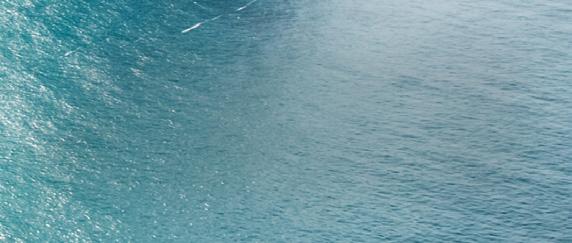
As figures show an overwhelming desire to switch off from the fast-paced modern attention economy, an increasing number of people are seeking more than just a “regular” break, but instead, a true escape during their time off. And the travel industry is taking note
WORDS YI-HWA HANNA

Endless emails. Packed schedules that leave some people so busy they need to choose between being able to do their own laundry, cook their own dinner, or get to the gym – but rarely all three. e pingping-ping of endless noti cations from our numerous devices, apps, and communication platforms. Ads popping up everywhere we go, from
our computers and televisions to the electronic billboards on our drives, and pretty much anywhere there’s a screen – even in the elevators of apartment buildings. In a fast-paced modern world where it can o en feel like we are bombarded by information le , right, and centre – and statistics repeatedly showing that burnout is on the rise across the world – it’s little wonder that when there is the
opportunity to take a little time o , an increasing amount of people are seeking not just the ability to enjoy a bit of a holiday, but one that also o ers them the chance to escape from the cacophony of their everyday life. When it comes to escapist breaks, for many, the old idea of a few cocktails by the pool just isn’t going to cut it – instead, many people are seeking newer and more radical
MAY 2024
ways to switch off from the “grind” completely, be that travel to an asyet-undiscovered location that can offer them a brand-new perspective, wellness-infused options that will send them home feeling truly restored (and maybe even improved), or travel experiences so immersive that they are powerful enough to help shake off the doldrums of everyday life.
In a 2023 report from ABTA – a trade association for UK travel agents, tour operators, and the wider travel industry – escapism travel was listed as one of the biggest travel trends for the year 2023, and in 2024, the desire for a “getaway to get away” shows no signs of stopping. In further research from ABTA on consumer sentiments, 93 per cent of those surveyed felt that a holiday could improve their wellbeing and mental health, of which 65 per cent felt that the reason for that was a holiday’s ability to give them an escape from the stress and pressure of everyday life. In a poll by YouGov that looked at 13,000+ consumers in eight key markets across the globe, 61 per cent of those in France, 59 per cent those in the UK, and 56 per cent of those in Australia cited that their
greatest motivation for travel was the need to escape from their routine and everyday or home life. And the desire to go “off-grid” isn’t limited to the UK or even Europe – the YouGov survey showed that at least 43 per cent of consumers in markets such as India and Indonesia felt the same. Meanwhile, in 2023, data from Booking.com showing that at least 55 per cent of travellers across the globe were reported to be seeking vacations where they could be offline, unreachable, or otherwise incommunicado to take a break from their everyday reality. Whether the appeal is in a hiking trip, a yoga retreat, or a more radical form of “switch-off” holiday, it appears that selective unplugging is a key underlying factor in the appeal of escapism travel. Defined as being only partially connected or altogether disconnected from information and communication technologies during travel, a 2022 study on Tourism Management published on Elsevier found that technology was regarded as a, if not the, key medium for people to be able to switch between the status of being able to travel for a restoring escape, versus daily life.
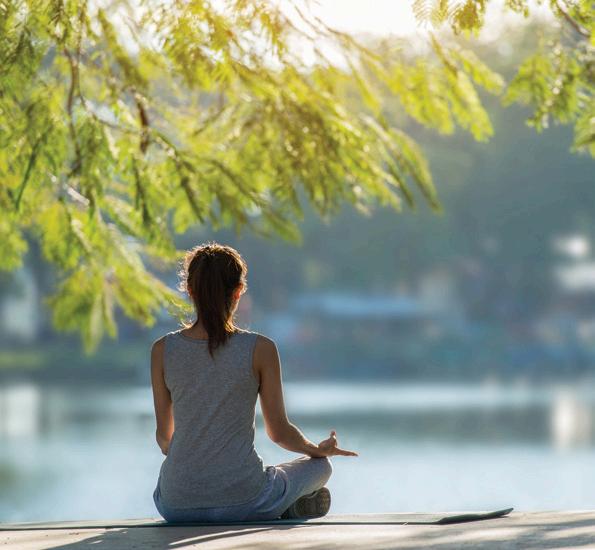

Escapism travel: an antidote to burnout?
It’s little wonder, given how much the lines between home and working life have been blurred thanks to the advent of technology – an issue that has been exacerbated by the long-term changes towards our collective approach to work since the COVID-19 pandemic. A report from Indeed found that 52 per cent of all workers are feeling burned out – a 9 per cent increase from the pre-pandemic era that is being, in large part, attributed to the rise in remote working. Indeed’s study found that 61 per cent of remote workers find it more difficult to unplug from work during their personal time or non-working hours – and this growing lack of boundaries appears to be leading to rising levels of burnout among workers across the globe.
According to a study by Asana, a web and mobile work management platform based in the US, burnout –defined as a state of mental, physical, and emotional exhaustion caused by excessive and prolonged stress, overwhelm, and an inability to meet constant or unending demands –makes workers 36 per cent more likely to have lower morale, 30 per cent more likely to feel less engaged, 27 per cent more likely to make mistakes, 25 per cent more likely to miscommunicate, and 25 per cent more likely to leave a company. In 2022, a survey of 15,000 workers across 15,000 countries conducted by McKinsey Health
ABOVE: Reports show that 52 per cent of workers feel burned out or exhausted
BOTTOM LEFT: Immersive yoga retreats are a popular form of escapism travel
OPPOSITE PAGE: Hilking vacations in as-yet-unexplored destinations are growing in appeal
4.6 TRILLION US$
The value that the global adventure tourism market is predicted to reach by 2032
61%
The number of remote workers who find it more difficult to unplug from work during their personal time or nonworking hours
ANDRIY, STOKKETE, SUNTI/ADOBE STOCK 45 TRAVEL TRENDS MAY 2024

QUICK TIPS FOR A “DAILY ESCAPE”
Can’t get away, but still need a break from the everyday grind? Commit to regularly putting your phone away for a specific timeframe that you put into your calendar and treat like a serious appointment. Then use this time for some intentional embodied presence: that is to say, doing an activity through which you can feel self-aware, and fully in tune with yourself both physically and emotionally – wherein your workload is placed into a temporary mental box of sorts.
found that a quarter of the employees surveyed had experienced symptoms of burnout. Research from Deloitte and Workplace Intelligence, across four different countries, found that 43 per cent of workers regularly feel exhausted, 42 percent feel constantly stressed, 35 per cent feel overwhelmed, and 23 per cent feel depressed. The Asana study found that among 10,000 workers across seven countries, 70 per cent had experienced burnout in the last year – findings that were similar to further research from Deloitte, which reported that 77 per cent of workers have experienced or are currently experiencing burnout at their current job. Among these figures, women were more likely to have reported burnout than men. And yet 40 per cent of people feel that burnout is an unfortunate albeit inevitable part of achieving success. So what’s the cure?
Getaways to get away
Numerous tourism operators and travel companies have published reports showing that from 2023, an increasing number of customers have been opting for all-inclusive vacations – and Statista reports that the Package Holidays market worldwide is expected to grow by 3.03 per cent from 2024 to 2028, to be valued at US$340.30 billion by 2028. Allinclusive holidays can offer customers the chance to enjoy a break without having to worry about taking out their wallets and calculating or paying for individual moments, or thinking about anything but the enjoyment that is present or ahead of them. With numerous studies having shown that the practice of meditation
and mindfulness can help people switch off, well-being focused escapes continue their steady growth in appeal, with the global wellness retreat market predicted to grow at a CAGR of 7.4 per cent until it reaches a staggering US$363.9 billion by 2032. From long-standing hotel resort brands to online operators such as BookRetreats offering new packages through which clients can unplug, de-stress, recharge, and restore themselves to vitality, people are increasingly travelling for retreats centered around meditation, yoga, fitness, personal development, adventure, hiking, or some combination of all of them and more. These trips can last from just a few days to a week, two weeks, or more,
FROM TOP LEFT: Scheduling time away from screens can help place less pressure on holidays; Whitewater rafting is an immersive switch-off experience; Hiking can be restorative
While a single vacation may not provide a permanent fix, it seems that taking regular breaks – the kind that allow people to truly switch off from their responsibilities – is one solution. Yet despite a desire to disconnect, many people find it difficult to do so alone. A 2023 report by Priority Pass – the world’s largest independent airport lounge access programme –that surveyed 8,500 people across 11 countries found that one in three people across the world experience “the fear of switching off”. Among them, UAE residents were stated to find it exceptionally difficult to draw a line between work and vacation, with 49 per cent struggling to switch off the demands of daily life while they are on holiday, 57 per cent unable to stop checking their work-related emails, and 58 per cent finding themselves unable to put their phones away at all. As many continue to succumb to the temptation of staying plugged in no matter where they go, increasing numbers are turning to their travel operators, hotels, or tour companies to help free them of this pressure, through curated escapism-focused packages that can help take the decision off their hands.


46
TRENDS MAY 2024
TRAVEL
all with the intention to offer people the chance to rejuvenate their mind, body, and soul in beautiful surrounds, with their needs catered to through delicious food and great service, and the chance to head home not only feeling relaxed, but having grown.
The YouGov study found that two in five global consumers wish to seek out new travel destinations. Alongside this burgeoning desire to discover the undiscovered, adventure travel is on the rise According to Allied Market Research, the global adventure tourism market is predicted to reach a value of US$4.6 trillion by 2032 with a compound annual growth rate (CAGR) of 28.7 per cent. Adventure doesn’t necessarily have to mean pulling out the hiking gear and hitting the mountains, either: it could be anything that gives the traveller a true sense of adventure, from scenic long train journeys that transport them to another
time and place, to hot air ballooning, river rafting, and ski vacations complete with a cozy luxury chalet.
The latter is important: by offering the same level of comfort and safety available in any other travel experience, the scope of modern adventure travellers is widening. Luxury travel company Black Tomato is one company that has seized the opportunity around this niche through a service called Get Lost. Inviting customers to go “on a daring journey across a thrilling and remote wilderness”, it promises that “You’ll find your way home – but you’ll also find yourself.” Its Get Lost packages, which start from £10,000 and can go up to £150,000, involve customers filling out an enquiry form that matches them to a Get Lost expert to “determine how lost you want to be”, with the only input the traveller has being choosing the type
of environment they want to get lost in, if they wish. The website asks clients to “commit to taking a trip to Get Lost, without knowing where you’re going or what you’ll need,” assuring them that “Black Tomato will take care of the rest. All you’ll know is to show up at the airport and find out what’s next.” The packages offers customers the chance to feel genuinely lost – and all of the rich experiences that can come with that – but with all of the support, gear, comfort, trust, and safety of knowing that they are in good hands, with a luxurious ending and sense of achievement awaiting them at the end.
By offering more comfort, the scope of the modern adventure traveller is widening

PROSTOCK-STUDIO, PARILOV, BGSTOCK72/ADOBE STOCK 47

The power of nature and quietude The ability to immerse oneself in something truly experiential is at the heart of the appeal of escapism travel. While as-yet-unexplored travel destinations do give many the sense of disconnection they are seeking –in many cases this is literal, with the location of some camping trips and hiking trails making it impossible for them to get online – for stressed and exhausted travellers seeking quality rest, “hibernation holidays”, or those offering some form of quietude, may hold more allure than off-the-beatenpath destinations. Silent retreats, for instance – once a vestige of the spiritual or wellness community often linked to yoga communties in East and South Asia – have now begun popping up across the world, from the US to Europe and the Middle East.
On the more extreme end of the spectrum, US company Dark Retreats Oregon – founded in 2003 – now offers their signature five-day “Dark Retreat” year-round as a “great space for self-care”
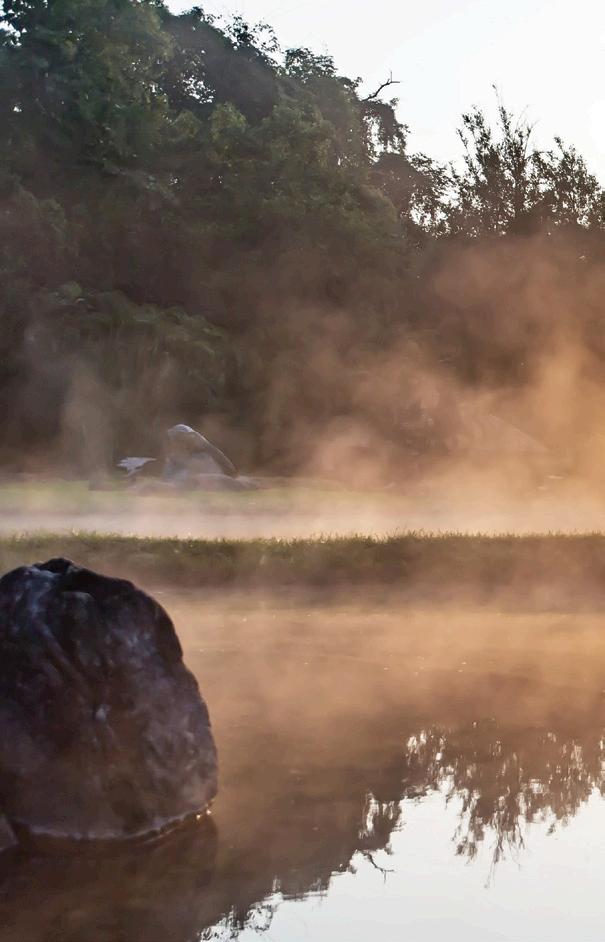
and “uninterrupted self-exploration”. During previous years, they only had them during the wintertime, and they were primarily seen as novelty experiences for inspiring “uninhibited creativity”. Now, they attract repeat visitors. Their retreats invite guests to spend their stay in partial or total darkness, free of artificial light sources, with the option to carry out the duration of their trip in silence as well. The benefits cited include “profound rest and nervous system reset”, “silent and digital detox”, and “expanding energetic capacity” alongside the chance to enhance one’s knowledge of self and personal introspection, as well as spiritual growth. Guests are sent a list of instructions for “darkness prepping” before arrival, upon which they can select a “landing opportunity” that allows them to familiarise themselves with the space as they acclimatise before plunging themselves into darkness. Once the retreat is over, guests can be led to an on-resort location of their choice, guided by staff while they wear a
blindfold, where they will “break light”. For those seeking similar benefits without having to delve in quite as deeply, astrotourism – travel that allows people to spend time gazing at the stars, or in pursuit of specific astrological phenomena – is another option. In 2021, the Qatar National Tourism Board capitalised on this desire for serenity and reconnecting with nature through a partnership with Gulf Adventures, that invited astronomy enthusiasts to join them through curated star-gazing experiences at historic and cultural sites. In Saudi Arabia, where there are plenty of locations with no light pollution that allow travellers to see the stars with the naked eye, the King Salman bin Abdulaziz Royal Reserve Development Authority held its inaugural astrotourism event in winter 2022 at Al Tubayq, a natural reserve in the north-west of the kingdom, near the border with Jordan, with more such experiences to come. AlUla, with its low light
48 MAY 2024
TRENDS
CLOCKWISE FROM ABOVE: Hot air balloon trips can give customers a new perspective; Silent retreats hold growing appeal; Astro-tourism is a new form of escapism travel
TRAVEL
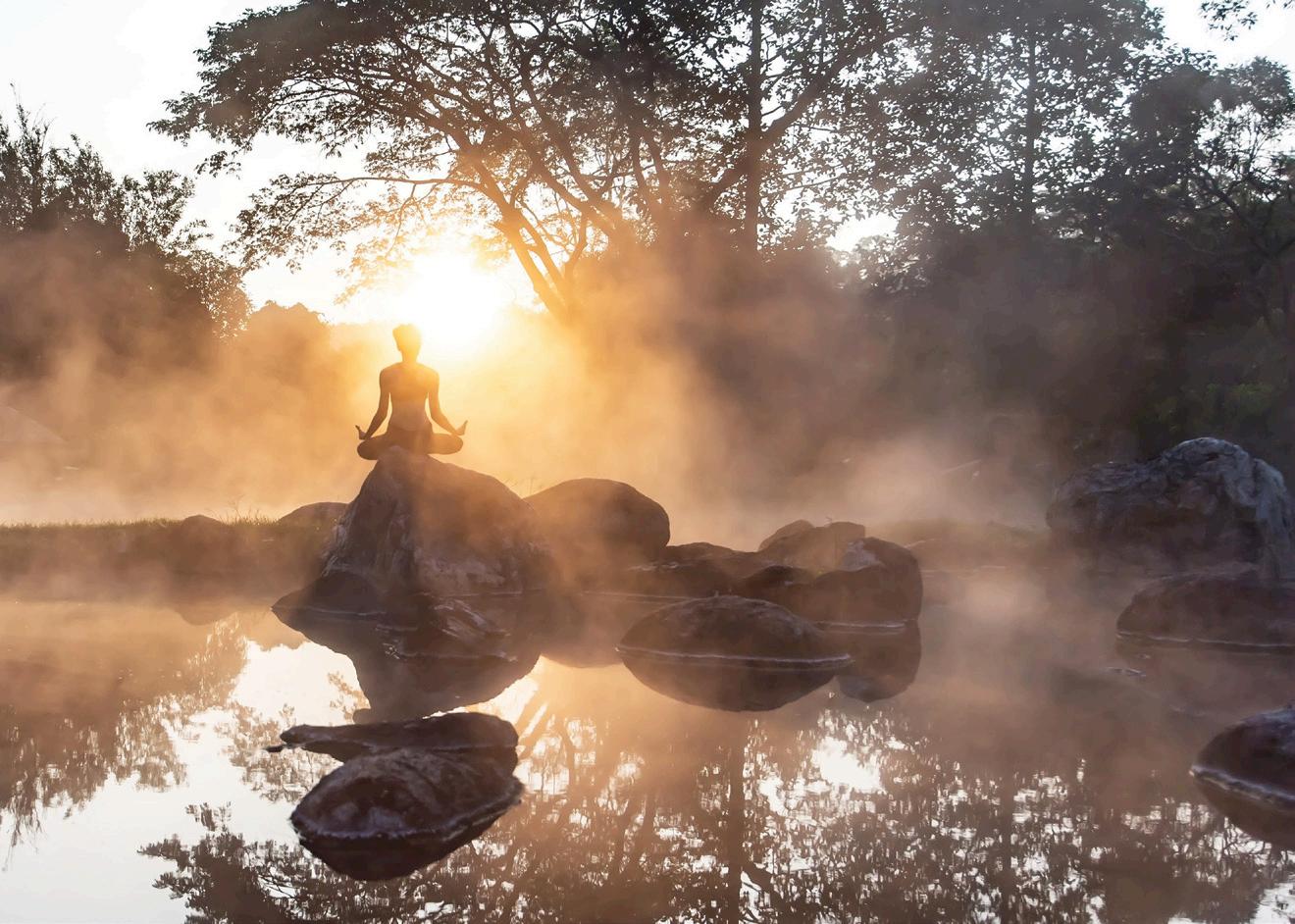

pollution and serene desert landscape, is also often cited as a prime location for astrotourism in the kingdom.
Across a number of studies explored and published in the National Library of Medicine, spending time in nature, or “naturebased” interventions, were found to have a profound impact on improving
mental and physical health. These psycho-somatic benefits can also be found in other forms of escapist travel that reconnect people with nature. Fans of the ocean or the underwater world can find a similar sense of escape through live-aboard boat trips that offer packages centered around diving, surfing, and more,
for instance. Meanwhile, those who love greenery can indulge in a spot of forest bathing – a wellness practice that originated in Japan in 1982, and involves spending time in lush green surrounds, often barefoot for “grounding” – through dedicated, specialised retreats, or via individual visits to one of many natural or botanical parks around the world. Not sure where to find one? The website quietparks.org is dedicated to listing these spaces for intrepid, solitude-seeking nature-lovers.
Whatever your chosen “cure” for the noise of normal life, the appeal of escapism travel as the antithesis to the hustle and bustle is one that is only set to grow. The ability to truly escape from our daily lives through immersive and experiential travel appears to increasingly be the ultimate luxury in this day and age – and it’s one that can offer a whole new world of potential for travel, tourism, and hospitality companies who are ready to jump on the trend.
SIX60SIX, TONJUNG, ASTROSYSTEM/ADOBE STOCK MAY 2024
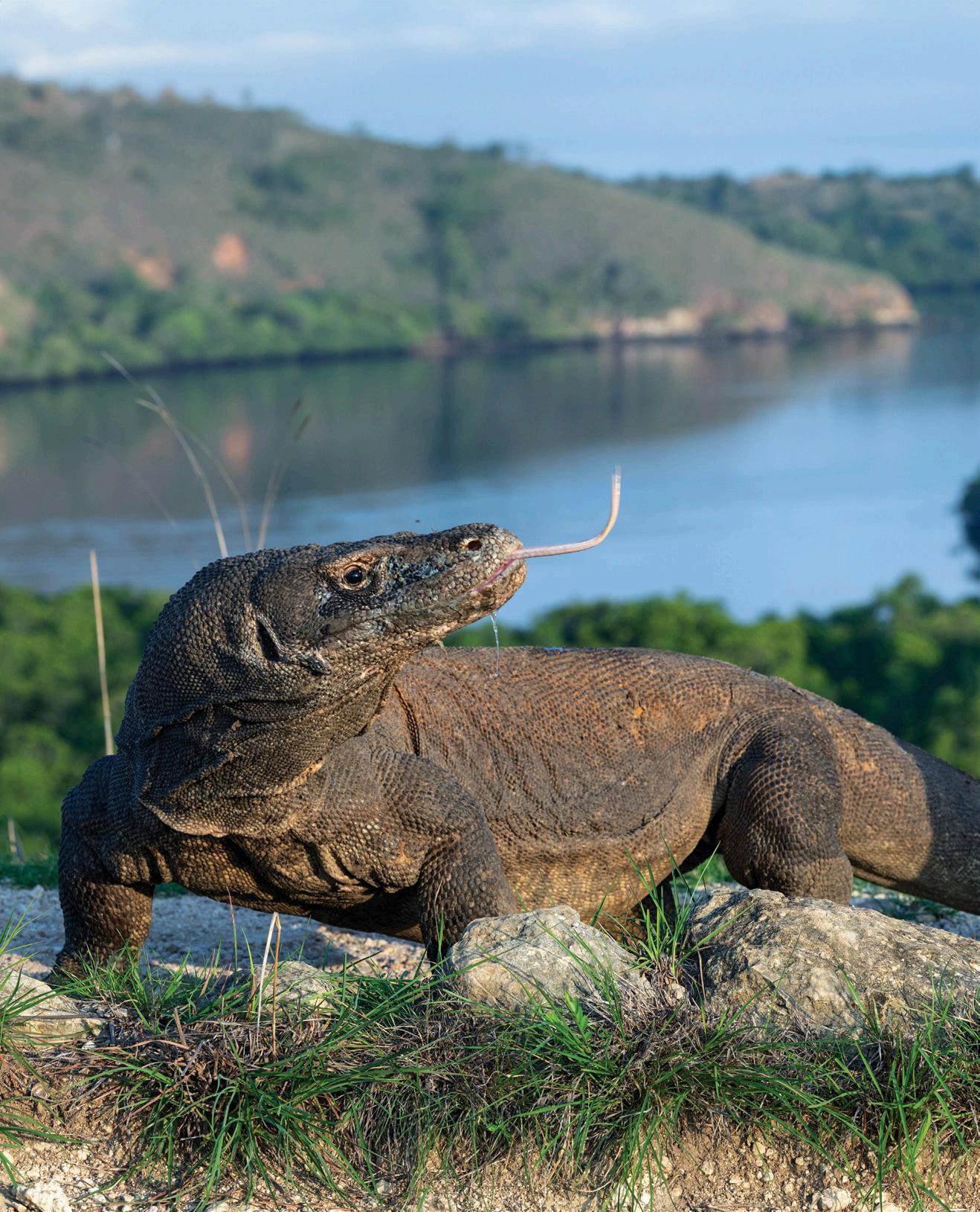
THE DRAGON DEEP BLUE SEA AND THE



Flores and Komodo National Park, in the heart of the Indonesia archipelago, are a nature-lover’s paradise filled with giant lizards, adventure, and stunning marine life

WORDS ZANA AZEREDO
50

The habitat of 2,500 Komodo dragons, it boasts unparalleled biodiversity

Komodo National Park, a jewel nestled within Indonesia’s vast archipelago, is a sanctuary where wilderness meets the treasures of the sea. This UNESCO World Heritage site, once a haven for divers and young intrepid travellers, has evolved to become a welcoming paradise for families and luxury-seekers alike, offering an array of experiences that cater to every type of adventurer.
Spanning across the islands of Komodo, Padar, Rinca, and an additional 26 smaller islets, all in close proximity to the larger island of Flores, the park is celebrated as a marine sanctuary. It boasts an unparalleled level of biodiversity and is the habitat of approximately 2,500 Komodo dragons, the largest living lizards on Earth.
Established in 1980 to protect the iconic Komodo dragon, the national park has since become a celebrated part of the Coral Triangle, offering snorkelers and divers alike the chance to explore its underwater marvels, including unmatchable coral forests.
Labuan Bajo: The Gateway to Wonder
Labuan Bajo, a small town nestled on the western coast of Flores island, serves as the gateway to Komodo National Park. The town’s transformation into a bustling tourist destination is evident from the moment visitors arrive at its quaint airport, greeted by the sight of a gigantic Komodo dragon sculpture hanging from the ceiling in hues of pink and purple.
The drive from the airport to Labuan Bajo’s town centre takes less than five minutes and the town’s main street, Jl. Soekarno Hatta, offers an eclectic mix of dining and lodging options. Diving tour shops, restaurants, hotels, bars, and ice cream parlours hang side out by side in the one-way street. From the small off-the-street Japanese den with plastic plates and amateur drawings on the walls, to the Italian breakfast restaurant with views of the harbour, there is something for everybody. Yet it’s in the evening that the street truly bursts into life, buzzing with energy as day-trippers, divers, and snorkelers return, seeking to unwind with a delicious meal and a refreshing evening beverage.
TOP: Padar island in Komodo National Park in Flores Island, Indonesia
OPPOSITE PAGE: Portrait of the Komodo dragon on Komodo Island
USO/GETTY IMAGES; SKAZZJYADOBE STOCK 51 MAY 2024 DESTINATION

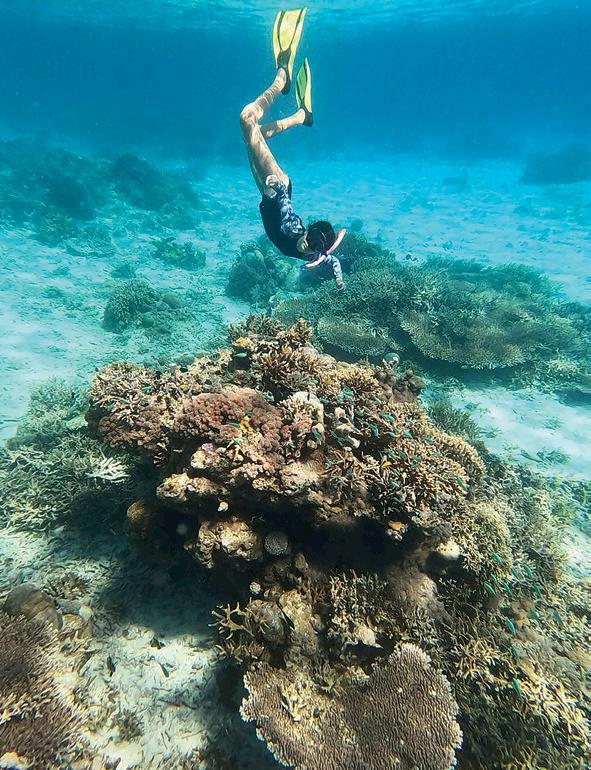
A Marine Paradise Unveiled
Experiencing the unspoiled marine life of Komodo National Park is an adventure that truly unfolds from the deck of a boat. Numerous tour operators based in Labuan Bajo offer day trips that include diving, snorkeling, and terrestrial exploration. Yet for those seeking the quintessence of marine exploration, embarking on a journey aboard a shared divers’ liveaboard, a private yacht, or a traditional wooden Phinisi boat offers an unparalleled experience. Whether opting for a three-, five-, or ten-day voyage, these vessels provide the unique opportunity to reach the reefs at the break of dawn. This timing is ideal, as the morning sunlight pierces the water at just the right angle to reveal the world’s most vibrant coral forests in all their splendour.
A jump in the water can easily include swimming with dolphins, manta rays, and sea turtles. While
fish are abundant, spotting large marine life is not the ultimate goal here. Instead, it’s far more likely for one to be mesmerised by the different colours and textures of the coral carpet under the sea, resplendent with one of the largest collections of nudibranchs, colourful in various shades of orange, purple, and blue. While diving is a highly coveted activity here, the shallow reefs coupled with crystal-clear visibility ensure that snorkeling offers an equally gratifying, if not superior, means of immersing oneself in the underwater wonders.
A day in the ocean might also provide visitors with contact with the local islanders. Approaching in their small canoes, these residents offer unique mementos, such as mother-ofpearl jewellery and intricately-carved wooden replicas of Komodo dragons, allowing guests to take a piece of their memorable experience home.
Realm of the Dragons
At the heart of Komodo National Park's allure is the Komodo dragons, Earth’s largest living lizards that roam freely across some of the islands. These colossal reptiles can grow up to three metres in length and weigh as much as 70 kilograms, yet despite their venomous nature, incidents of aggression are rare.
A visit to Loh Buaya Komodo National Park in Rinca Island provides an unparalleled opportunity to observe these majestic creatures in their natural environment, offering a glimpse into a prehistoric world that has remained largely unchanged for millions of years. Knowledgeable local guides lead small groups of three to 10 visitors, beginning the journey on hundreds of metres of suspended platforms with technical posters and explanatory boards along the way. The path continues to an observatory gazebo, offering chances to encounter the dragons up close along the way. The tour ends at the small yet informative museum showcasing the park’s fauna and flora.
The Loh Buaya visitor centre welcomes guests daily from 6.00 to 18.00, ensuring ample opportunity for exploration and discovery within this ancient natural world.

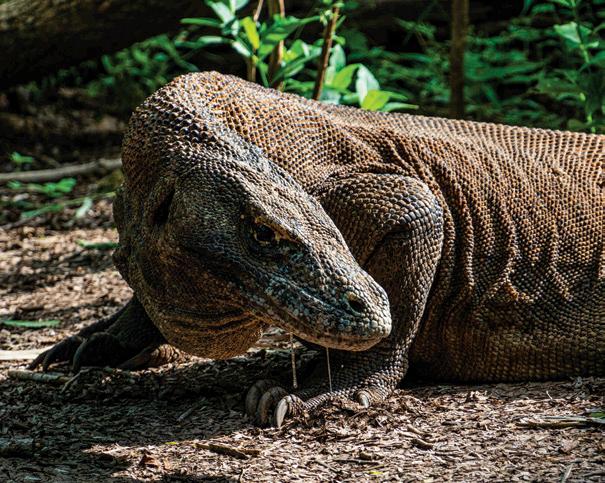 ABOVE AND LEFT: White and red coral at Pink Sand Beach; diving at Komodo National Park
ABOVE AND LEFT: White and red coral at Pink Sand Beach; diving at Komodo National Park
ZANA AZEREDO; SIMONA/ADOBE STOCK 52
MAY 2024
BELOW: Portrait of a Komodo dragon
DESTINATION

An Island of Experiences


If you’re in pursuit of breathtaking panoramic vistas, the prime spot for a hike and sunset viewing is Lawa Darat Gili Island. Fondly referred to as Deer Island due to the numerous wild deer residing there — most of which remain indifferent to human presence — it promises an unforgettable experience. The hike to the observation plateau can take anywhere from 30 to 90 minutes, depending on one’s fitness level. The trails are welcoming and accessible, making it a family-friendly adventure suitable even for young children. The islands of the national park are of volcanic origin and the terrain is generally rugged with the climate being one of the driest in Indonesia. For this trek, wearing closed shoes is strongly advised for the utmost comfort and safety.
Another sunset experience unfolds at Bat Island, Pulau Koabe. The silhouettes of dark mountains against the twilight horizon create the perfect backdrop for a breathtaking natural spectacle. Here, thousands of bats, known as Kalong, emerge from the tree canopy of Pulau Koabe, soaring towards Flores Island for their nightly forage. These fruit-eating bats traverse the salmon and ash-blue skies at varying altitudes, offering a mesmerising view. Boats strategically position themselves between the islands, allowing tourists to witness this extraordinary migration for

[It's] a glimpse into a prehistoric world that has remained largely unchanged for millions of years
45 minutes before returning to port.
For those in search of a romantic backdrop, a picnic on the Pink Sand Beach, nestled on the southwest side of Padar Island, presents an idyllic choice. For centuries, the red and white corals surrounding the island have washed ashore, resulting in a stunning stretch of fine pink sand that spans a few hundred metres and is often secluded. It’s advisable to bring along a glass of your preferred beverage, mosquito repellent, and sunscreen for an unforgettable experience.
Choosing Your Sanctuary Accommodations in Labuan Bajo range from the charming comfort of two - and three-star hotels to the lavish
indulgence of the AYANA Komodo Waecicu Beach resort, which offers spectacular views and unmatched service just beyond the city centre. Four more five-star resorts are slated to open later in 2024 on the northwest side of Flores, introducing a wealth of new options for discerning tourists. For adventurers eager to delve deeper into the aquatic wonders, the Splendour yacht offers a cozy and exclusive venue for marine explorations. This yacht, styled after the 1920s yet constructed in 2018, measures 65 feet in length and boasts three double cabins, providing both elegance and comfort. Numerous brokers in Jakarta and Labuan Bajo facilitate the chartering of this and many other yachts.
Sustaining Nature’s Bounty
As the park’s popularity has surged, the commitment to safeguarding its pristine beauty and ecological health has grown stronger. Through targeted conservation efforts, the park continues to be a sanctuary for a diverse array of land and sea creatures, adeptly balancing the demands of tourism with the crucial need for environmental preservation. The variation in national park fees, ranging from US$13 to 250 per person per day during recent years, reflects an effort to both raise funds for conservation and to regulate the influx of visitors, ensuring the park’s sustainability for future generations.
TANARCH, ODUA IMAGES/ADOBE STOCK; ZANA AZEREDO 53 MAY 2024
CLOCKWISE FROM TOP LEFT: Komodo National Park; A spread of Indonesian food; AYANA Komodo Waecicu Beach resort, Labuan Bajo




















Fluid 18K yellow gold diamond and aquamarine earrings Dhs59,310 FERNANDO JORGE , modaoperandi.com






Lydia one-sleeve cape-e ect cady maxi dress Dhs2,960 SOLACE LONDON, net-a-porter.com















14-karat gold multistone necklace Dhs63,605 JACQUIE AICHE , net-a-porter.com






Cleo crystalembellished satin pumps Dhs6,300 RENE CAOVILLA , renecaovilla.com
















Regal Statement











































Refined yet restrained. Dictate new rules for opulence with a lavish finish from exquisite ensembles to luxe accessories
COMPILED CAMILLE MACAWILI

Corvus 0.1 chainembellished velvet shoulder bag Dhs3,300 NEOUS, neous.co.uk



Velvet sandals Dhs3,512 TOM FORD, mrporter.com




Maestro 2.0 Ultra-Thin Automatic 39mm watch Dhs132,855 GERALD CHARLES, mrporter.com




























Jacquard suit jacket Dhs6,382 GIORGIO ARMANI, mytheresa.com















MAY 2024
54 LIFESTYLE































1. Armani Eau de Cedre Eau de Toilette, 100ml Dhs610 ARMANI BEAUTY, armani.com; 2. Aqua Vitae Cologne Forte Eau de Parfum, 200ml Dhs1,755 MAISON FRANCIS KURKDJIAN, franciskurkdjian.com; 3. Millesime Aventus Eau de Parfum, 100ml Dhs1,616 CREED, creedfragrance.com ; 4. For Him Vetiver Musc Eau de Toilette, 100ml Dhs470 NARCISO RODRIGUEZ, narcisorodriguez.com; 5. Vetyverio Eau de Toilette, 50ml Dhs472 DIPTYQUE , diptyqueparis.com; 6. H24 Eau de Parfum, 50ml Dhs452 HERMÈS, hermes.com; 7. Bitter Peach Eau de Parfum, 50ml Dhs1,455 TOM FORD BEAUTY, tomfordbeauty.com
MAY 2024 Feeling Fresh
COMPILED AMY SESSIONS 1. 2. 4. 7. 5. 6. 3.
Post-flight scents for a summer of ease
55 LIFESTYLE
Choose from our extensive range of authentic Thesiger photographs.
PERFECT DECORATIONS
FOR HOTELS, OFFICES AND HOMES.





Framed or unframed prints available exclusively from The Arabian Gallery


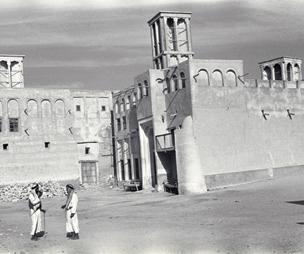


eport Tried, Tested, Tasted. TRIED AND TESTED FLIGHT TRIED AND TESTED HOTELS SMART TRAVELLER Japan Airlines Boeing 787-9 Dreamliner (business class) Doha-Tokyo Villa Fontaine Grand Haneda Airport voco The Palm, Dubai Four Seasons The Pearl- Qatar Our guide to... British Airways’ £7 billion transformation 58 60 61 62 64
the
Japan Airlines Boeing 787-9 Dreamliner (business class)
DOHA-TOKYO

BACKGROUND Japan Airlines’ inaugural flight from Doha’s Hamad International airport to Tokyo’s Haneda airport launched in April 2024. Run as a codeshare with fellow oneworld alliance member Qatar Airways, the new daily service was created to cater to the increased demand for business and leisure travel from Doha to Asia, o ering the region’s passengers another excellent option to easily connect with the rest of Asia, while also enabling customers from Asia and beyond to seamlessly connect to Africa, Europe, and South America.
The first Japanese airline to operate a nonstop service to and from the Middle East, the flight has a two-seat configuration, with economy and business class seats available.
FIRST IMPRESSIONS If you are flying directly from Qatar, the flight is at an ideal timing for a business traveller looking to carry on with work during the the daytime on the way there. Although it has an early start, you’re able to either work, keep yourself entertained, or sleep on the flight to Japan and arrive just in time for a good night’s sleep, before taking on the town the
next day. If you are flying from another GCC country, flying to Doha with fellow oneworld alliance member Qatar Airways means you can check your bags all the way through to your final destination as well. If you don’t opt to (or have the trip time to be able to) spend the night in Doha the evening before (which will require leaving the airport and coming back), there are incredible lounge facilities and plenty of options to keep yourself fed, watered, and entertained (or even sleep) at the award-winning Hamad International airport, especially if you take advantage of the access to the lounge.
I was welcomed with a steam-pack sheet mask and HERALBONY amenity kit
THE LOUNGE This flight gains you access to Al Mourjan Business Lounge South, which is a seven to 10 minute walk from the gate. One of the largest airport lounges in the world, it has a water feature; areas for quiet, napping, and families; workstations; meeting rooms, a games room and nursery; showers;
FLIGHT
DURATION
9 hours 5 minutes
CONFIGURATION 1-2-1
SEAT WIDTH AND PITCH
20in/51cm & 27.5in/70cm
SEAT RECLINE
Fully-flat
BED WIDTH AND LENGTH
20.9in/53cm (or 728.7inch/3cm with armrest stowed) & 778.9in/198cm
PRICE
Internet rates for a round-trip Doha-Tokyo flight in May start from €6,047 (QR 23,452)
CONTACT
jal.co.jp/jp/en
and dining. It’s worth a visit, not only because it’s stunning and serene, but also as there is less seating available outside of this flight’s gate.
BOARDING Gate entry began eight minutes after the ticket-stated time, and I was in within four minutes. Boarding announcements began 23 minutes later, with Group One (including Diamond and oneworld members) and Two (including business class) going on 12 minutes later, after which I was at my seat in three minutes.
THE SEAT Business class is the highest cabin class on this flight. There are 44 fully-flat JAL SKY SUITE III seats laid out in a reverse herringbone pattern. All of them have direct aisle access, and a privacy divider, while window seats have a little more table space than centre seats. Seats come with a large but flat pillow and good duvet, and optional Airweave mattresses. I can see how it might feel a little cramped for larger passengers, but the massage function in the back rest adds comfort. Entertainment is on a 23-inch monitor controlled by a liquid-crystal touch panel that can be a little fiddly at times, but is straightforward to use, alongside SONY noise-cancelling headphones. While there isn’t an enormous array of channels to choose from, there is a decent selection of not only new and classic films international and Japanese films, games, music, and more. A large tray table unfolds from the front panel, and seats have a USB port and AC power outlet. Wifi is chargeable at US$10.15 for an hour, US$14.40 for three hours, or US$18.80 for the whole flight, and getting online required me to jump on through their browser shortcut link (explained on

MAY 2024
58 TRIED & TESTED FLIGHT

the seat-back guide), but once online, the connectivity was reliable and quick, and the tray table comfortably large for a laptop.
THE FLIGHT I was welcomed with a steam-pack sheet mask and amenity kit designed by Japanese artist-led startup HERALBONY. Each kit contains a toothbrush and paste, ear plugs, a USB charger, eye mask (which could feel a little tight for people with a big head), pocket tissue, and a mobile phone stand. Miller Harris face mist and hand lotion is available in the bathrooms.

Around 30 minutes in, shortly after I’m given a warm towel and the choice of champagne or orange juice, I’m o ered “relaxing wear” in the form of a sweater-feel tunic from Japanese towel brand UCHINO.
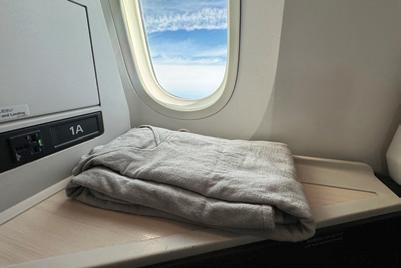

FOOD AND DRINK Food is the star on this flight, as with many JAL flights due to its curation by award-winning chefs, and unique approach that transforms the food and beverage o ering from a way to simply feed and hydrate yourself, to something to actually look forward to. You can choose from a Japanese “Washoku” menu or one featuring international cuisine. I went for the former since that’s the speciality. It started with a selection of Irodori Gozen – small cold plates – that included deep-tried tofu with Japanese sauce and salmon roe, Japanese vegetable omelette, green soybeans with cucumber and King crab, seared tuna with wasabi flavoured bean puree, and an amuse bouche. The main hot course was salmon teriyaki with simmered vegetables, steamed rice, miso soup, and Japanese pickles, followed by a silky pumpkin cheese mousse for dessert. The food was delicious and beautifully-presented, and wouldn’t have been out of place in an on-ground restaurant. They also o er an “order anytime” à la carte menu until two hours before landing, with salads and soups, three sandwich options, a light meal
curry), assorted cheeses, fresh fruits, chocolate, and ice cream, as well as their signature special Tonkatsu-flavoured miso ramen noodle bowl. The latter was tasty and comforting, with wonderfully chewy, bouncy noodles I looked forward to having again on the return flight.
The food, with on-demand options curated by awardwinning chefs, is the star
ARRIVAL The landing was slightly bumpy as we touched down, but the pilots handled it smoothly, and I made it to the arrival gate ahead of schedule. To speed up time in the immigration queue – which can get busy due to Japan’s resurgence of international tourists – it is recommended to fill out a disembarkation and customs declaration form online first through the Visit Japan Web app, but if you forget, the airline sta will provide this in-flight. Once past the immigration queue, bag retrieval was quick, and the airport has multiple connection options, from taxis and private cars to the metro system, including direct access to the very well-connected Tokyo Monorail and Keikyu Line.
VERDICT A wonderful way to transform the long journey from Doha to Tokyo into a comfortable one that allows for sleep, and a chance to sample Japan’s famous cuisine and hospitality before even arriving.
Yi-Hwa Hanna
MAY 2024
59 TRIED & TESTED FLIGHT
Villa Fontaine Grand Haneda Airport
BACKGROUND This is the newest hotel to have opened in Tokyo’s Haneda airport. It’s an ideal spot for busy business travellers to base themselves out of during short visits to Tokyo, as well as for passengers looking for a nearby place to rest after a long flight before they move on elsewhere.
WHERE IS IT? Connected directly to Tokyo’s Haneda airport, you can walk here from Terminal 3. It can be a little confusing to find at first, but once you know where it is, it’s a quick and short fully-indoors walk away. To get there, simply head to the metro and train station area that’s past Arrivals – it’s directly connected to the Tokyo Monorail and Keikyu lines – and through the concourse for the Haneda Airport Garden. You’ll find it there up a set of escalators, with the Hotel Villa Fontaine Premier Haneda Airport nearby.
WHAT’S IT LIKE? With 1,717 rooms, this is the largest airport hotel in all of Japan. Although it may not be the most luxurious hotel, it is clean and comfortable, with everything designed for convenience. Check in is self-served through machines that can have you to your room in minutes, though sta is available to help if needed.
ROOMS I stayed in a standard Double, but other options include Triple, Universal, and Lady’s and Japanese Family styles. Mine was snug but not too small, with a good
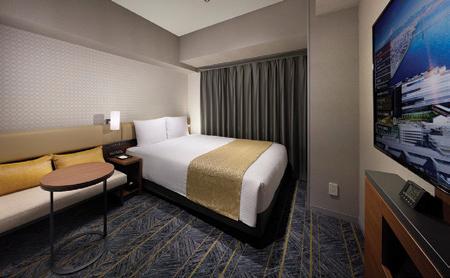
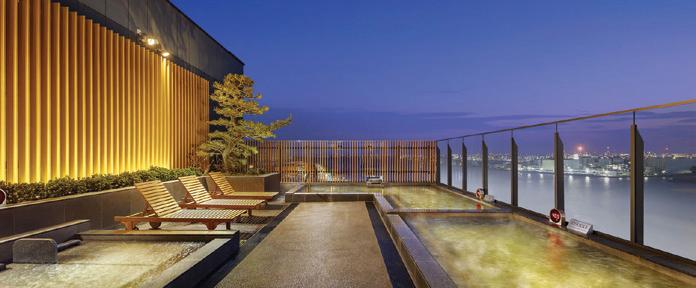
The 24/7 onsen is a unique and restoring experience for guests and
non-guests alike
strong shower (and bathtub), Japanesestyle toilet with a heated seat function, a small sofa and table area, large TV, and multiple amenities including toiletries, a hairdryer, kettle, mineral water, slippers, an international outlet, and even pyjamas and a USB charger with multiple types of heads. If you need more, there are freeto-take drip co ee bags, toothbrush kits, extra towels, shaving kits, and more at the reception floor. The custom-made Simmons beds are comfortable, and I slept quite well.
FOOD AND DRINK The hotel has four dining outlets, including an all-day dining venue, bar and lounge, one serving Japanese cuisine (with individual seats for solo travellers) and a Japanese izakaya with panoramic views of Mount Fuji. There are also nearby restaurants in the connected Haneda Airport Garden, not to mention a 24/7 Lawson “konbini” (convenience store).
LEISURE The hotel has its own spa and onsen (hot springs bathing facilities), Izumi Tenku no Yu, that is open 24 hours a day (except between 10.30 and 12.30 due to
cleaning), and it would be tragic to come here and not try it. A single entry costs ¥2,000 for hotel guests and ¥4800 for non-guests. Pictures inside the onsen – which is fully separated into men’s and women’s sections on di erent floors – are strictly forbidden, especially since use of the onsen requires full nudity. While this might be daunting for the unfamiliar, this is a typical part of the traditional onsen experience, which boasts many health benefits. Toiletries, towels, robes, and lockers are available, with various baths of 34 to 46 degrees Celsius o ered in both indoor and outdoor sections. The latter even has views of airplanes and Mount Fuji on unclouded nights.
MEETINGS There are 10 meeting rooms on-site, all on the same floor, as well as a large hall that can fit up to 1,000 people in it.
VERIDICT An ultra-convenient place for a night’s rest between Tokyo and your next destination. Even if you don’t stay there, it’s worth going to use the onsen alone, especially if you have a long time between your hotel’s checkout and a late flight.
Yi-Hwa Hanna
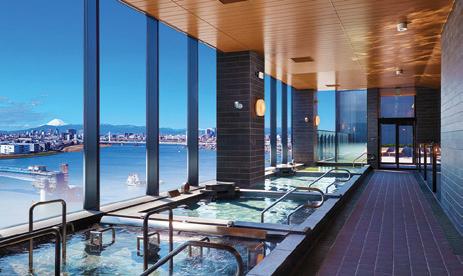
FOR A convenient stop before or after a long flight to/from Tokyo Haneda airport DON’T MISS The 24/7 onsen spa
rates start from around
for a Moderate Queen (without breakfast) for May
MAY 2024
BEST
PRICE
US$155
CONTACT +81
Room
3-6863-8430; hvf.jp/eng
TRIED & TESTED HOTEL 60
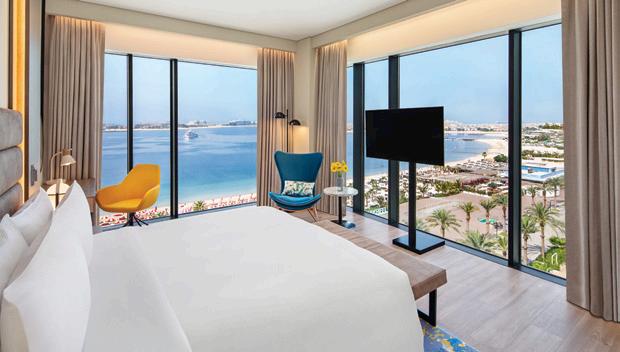
voco Dubai The Palm
BACKGROUND A gem nestled in Dubai’s Palm Jumeirah, voco The Palm blends modern design with a relaxed beach vibe. Under the umbrella of the IHG brand, the boutique-style hotel is ideal for business travellers visiting Dubai Media City, with direct beach access to unwind after a busy day.
WHERE IS IT? Situated along the picturesque 1.6km Palm West Beach promenade, the hotel o ers guests sweeping sea views that include the Dubai Eye ferris wheel, city skyline, and powdery beach. It has a prime location that provides easy access to the trendy Palm West Beach strip.
WHAT’S IT LIKE? Stepping into voco
The Palm, guests are greeted with a sleek and upbeat interior adorned with bird motifs and an airy lobby with high ceilings. While checking in, you will be o ered homemade granola and fruit-infused water. The seamless transition from the lobby to the main restaurant, Maison Mathis, leads directly to the beachside promenade, setting the tone for a delightful stay.
ROOMS There are 471 rooms, and half of them o er an urban jungle vibe facing the backside of the hotel, overlooking a street and surrounding hotels. On the other side, rooms o er beautiful sea views, ensuring a peaceful retreat. However, it’s worth noting that the proximity of some rooms to nearby popular restaurants and beach clubs can get loud at night, particularly during peak
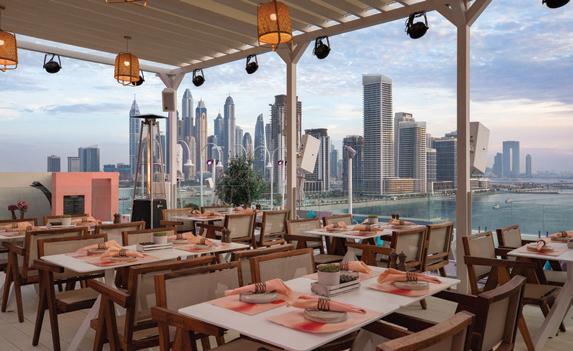
hours. While this may be a consideration for light sleepers, the hotel’s attentive sta are readily available to address any concerns and ensure a comfortable stay (including ear plugs and extra pillows!). From twin beds to king-size indulgence, the rooms o er comfort and style, with paintings decorating the walls signed by local artist Al Sayed. Among the highlights of voco The Palm’s accommodation o erings are the corner room suites. These expansive suites are larger than some New York City apartments, with separate living
The newly-opened roo op restaurant, Frenia, o ers poolside panoramic views
areas, two bathrooms, and a main bedroom with ensuite facilities (including a bathtub ideal for a long soak with bath salts after a long day). The pièce de résistance of these suites is the floor-to-ceiling glass walls that o er uninterrupted views of the sea, creating an illusion of floating atop tranquil waters. Wifi connects automatically, there’s a kettle with a generous array of tea, a
BEST FOR
Those who like understated seaside luxury
DON’T MISS
Sundowners at Frenia by the rooftop pool
PRICE
Rooms start at Dhs 1,350 for a Sea View room
CONTACT
voco The Palm, Palm West Beach Promenade; Dubai, UAE; +971-4-2495555; ihg.com/voco/hotels
shower with excellent water pressure, eco-friendly amenities and more delicious homemade granola in jars to take home.
FOOD AND DRINK The new rooftop restaurant, Frenia – which soft-opened in December, serving Mediterranean fare and creative cocktails – o ers poolside panoramic views of Dubai’s skyline, complemented by crowd favourites such as patatas bravas and flank steak, best savoured against the backdrop of a mesmerising sunset. Meanwhile, Maison Mathis continues to delight diners with its delectable array of fresh mussels and a diverse menu featuring everything from gourmet burgers to baked sea bass. Breakfast at Maison Mathis is a treat, with flu y sourdough bread baked in-house daily and an extensive spread of juices, made-to-order omelettes, and Arabic specialties including ‘foul medammes.’
BUSINESS There is a dedicated meeting room space on the first floor, providing ample seating and abundant natural light to encourage productivity.
LEISURE While Maison Mathis and Frenia present enticing options, guests seeking adventure can explore the nearby promenade, where popular hot spots like Koko Bay and Senor Pico await with their seats on the sand. Take advantage of the 24-hour fitness centre, go for a walk along the 1.6km promenade to clear your mind, or have a refreshing dip in the sea.
VERDICT For business travellers who are seeking a blend of luxury, convenience, and contemporary charm, voco The Palm emerges as a standout choice. With its prime location, impeccable amenities, and culinary delights, it promises a perfect stay that seamlessly combines work and leisure. Sara Hamdan
MAY 2024
TRIED & TESTED HOTEL 61
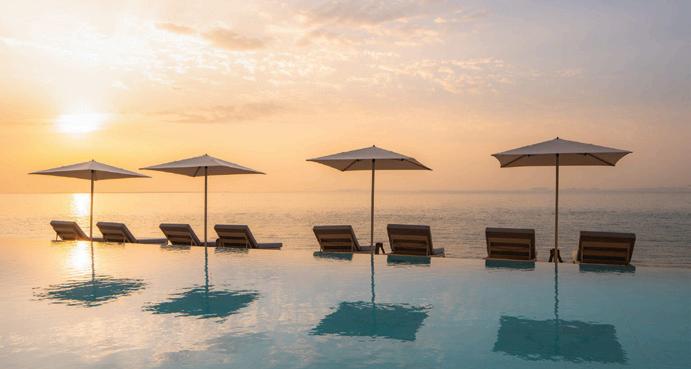
Four Seasons
The Pearl-Qatar
BACKGROUND Opened in late summer 2023, Four Seasons Resort and Residences
The Pearl-Qatar is the second Four Seasons property in the Qatari capital, after Four Seasons Doha back in 2005. It is one of a growing number of properties from the brand that caters to both hotel as well as residential and long-stay guests.
WHAT’S IT LIKE? Contemporary yet timeless, grand yet never ostentatious, and a true escape with all of the comforts of home, the property is the definition of understated luxury for those in the know. The sta are exceptionally warm, welcoming you as though you’re an old friend from the moment you step into the doors. They are always present to help with whatever you need, without ever being too in-your-face, and service, from the check-in to meals and finding your way to the secret gems in its wealth of facilities, is outstanding all around. The colour palette is luxurious yet relaxing, with cream, gold, and brown accents with some pastels. The high-ceilinged lobby is wide, airy, and full of light, a true hub that connects you to the pool, restaurants, rooms, and the rest of the property.
It is one of a growing number of Four Seasons catering to hotel and long-stay guests
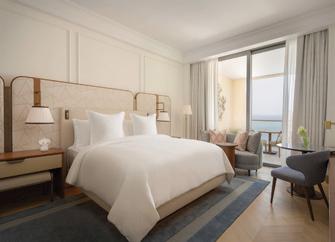


WHERE IS IT? Located on The Pearl, an artificial island that has fast become one of Doha’s most enviable beachfronts. The hotel has its own private beach, and is a hop and a skip away from Doha’s luxury Place Vendôme mall and culture-rich Souq Waqif, while being just a 25-35 minute drive from Hamad International airport.
BEST FOR Outstanding comfort
DON’T MISS
The private beach
PRICE
Internet prices for a One-Bedroom City View Apartment in May start at Dhs2,775
CONTACT
Porto Arabia Drive 127, The Pearl-Qatar, Doha; +974 4144 3000; fourseasons.com/ thepearlqatar
ROOMS There are 161 one-, two-, or three-bedroom apartments, each with a large living area, outdoor terrace, and fully-equipped kitchen and ensuite laundry. The finishings are sumptuous yet tasteful, with bedding that dreams are made of. The apartments, with homey touches such as collectorworthy books and bespoke finishings by Wimberly Interiors, Miele kitchen applicances, Diptyque products in the bathroom, and a Dyson hairdryer elevate the everyday into the extraordinary.
FOOD AND DRINK Meals are a tempting a air at all-day dining restaurant Spuntino Italian, which has an art deco-vibe indoor area and an outdoor section that will tempt you to stay for hours longer than planned as you wile away the hours over excellent food and the sea breeze. The dining o erings are curated by multi-award-winning Joël Robuchon, and all can be rented for private use. You can opt for teatime in the Duchess tea lounge, tuck into a steak at their Chicagostyle steakhouse, or grab a cocktail while you watch the sunset with a view of the Doha skyline from the Loulou Plage sea-view bar.
BUSINESS The Pearl Lounge is a dreamy spot for board meetings or private celebrations, with sophisticated art-infused interiors and a generous outdoor terrace.
LEISURE The property has one of the best-equipped gyms we’ve ever seen, with every type of machine or equipment you could wish for (including a boxing bag). The outdoor pool and beach are a relaxing haven, or if you prefer a late-night swim post-treatment in the lush spa, the indoor pool is a sanctuary complete with beds.
VERDICT A magnificent home-awayfrom-home that’s such a comfortable and restorative break from the hustle and bustle of everyday life that you’ll want to stay forever, or at least for a very long time. And if you wish to, you can. Yi-Hwa Hanna
MAY 2024
TRIED & TESTED HOTEL 62










Discover more mmgsocial.com






British Airways’


























64 MAY 2024 SMART TRAVELLER
£7 billion transformation Our guide to…
British Airways has revealed various initiatives as part of its £7 billion transformation plan over the next two years, including route resumptions, free onboard messaging for Executive Club members, and new short-haul seats.
The initiatives were unveiled at a British Airways showcase event held in London on 4 March, and attended by the carrier’s chairman and CEO Sean Doyle.
In a fireside chat, he commented: “I’ve been running British Airways for three years and the rebuild hasn’t been without its challenges. That’s obvious not just for everyone at British Airways but across the industry. But we are making great progress at fixing the basics… It’s not just chat, it’s backed up by a very, very significant financial commitment.”
He outlined the five focuses for the investment as: driving operational resilience, investing in IT estate, improving the digital experience, improving the colleague experience, and embedding sustainability at the heart of the business.
ROUTE RESUMPTIONS
London-Bangkok
A three-times-weekly service between Gatwick and Bangkok will begin on 28 October and will be operated by a three-class Boeing 777-200ER aircraft, configured with 32 Club, 48 World Traveller Plus and 252 World Traveller seats.
Return fares start from £699 in economy, £1,297 in premium economy, and £3,257 in business. Flight times are as follows:
■ BA2231 departs LGW at 2100, arrives BKK at 1555 the following day
■ BA2230 departs BKK at 2255, arrives LGW at 0530 the following day
London-Kuala Lumpur
Daily flights from London Heathrow to Kuala Lumpur will restart from 10 November. These flights will be operated by a four-class Boeing 787-9 aircraft configured with eight First, 42 Club, 39 World Traveller Plus and 127 World Traveller seats. Return fares start from £620 in economy, £1,338 in premium economy, £3,200 in business, and £4,000 in first class.
Flight timings are as follows:
■ BA33 departs LHR at 2045, arrives KUL at 1730 the following day
■ BA34 departs KUL at 2320, arrives LHR at 0535 the following day
FURTHER LAUNCHES
Additionally, the airline will return to Abu Dhabi on 20 April and add Izmir in Türkiye to its network on 18 May.
CABIN UPGRADES
British Airways also unveiled the look of new short-haul Euro Traveller and Club Europe seats on the next generation of the carrier’s A320neo and A321neos.
The seats are the same design in both cabins, though those in Club Europe (business class) feature a bespoke leather tray in the empty seat between the aisle and window seat and will be fitted with USB-A and USB-C (60W) backrest-mounted charging ports –these will be 15W in Euro Traveller (economy class). The redesigned cabins will be fitted with extra-large bins for overhead luggage.
The seats have been designed in England and manufactured in Northern Ireland, and feature Scottish leather.
In further cabin news, BA revealed that it will introduce a new First suite at the end of 2025 as part of its A380 aircraft refurbishment, but remained tight-lipped about the design.
FREE MESSAGING
Customers can also look forward to enhanced connectivity in the air. Members of British Airways’ Executive Club will be rewarded with free messaging on the likes of WhatsApp, iMessage, Facebook Messenger, and Teams Chat onboard, regardless of the cabin they are travelling in.
The service has been available on all wifi-connected aircraft for the full duration of the flight on a single device since two weeks of the rollout date on 3 April.
Executive Club members can access this service by logging into their account and non-members can sign up onboard or before they travel to secure free messaging.
As it stands, wifi is available on all of the airline’s Gatwick fleet and more than 80 per cent of its Heathrow fleet. The carrier
says that this will roll out to 100 per cent of the fleet by the end of 2025.
LOUNGE UPGRADES
The airline also announced that it is set to open a new lounge in Dubai in the first half of 2025, which will replace the existing lounge facility at the airport and be located in a larger space. The lounge will be the first to feature the carrier’s new global lounge design concept, and will be followed by the Miami lounge in 2025. Both will be designed by global architecture, design, and planning firm Gensler.
Additional lounge refreshes are set to be unveiled in Lagos and Seattle. These updates follow lounge refurbishments at Heathrow Terminals 5 and 3 and Edinburgh airport.
NEW WEBSITE AND APP
The airline plans to launch a new website and mobile app o ering “deeper personalisation”, with initial changes rolling out by the end of the year.
The new ba.com browser is currently in BETA testing and will o er passengers the opportunity to make changes to their journey online rather than having to call a customer care centre.
BA said it will be able to text hotel and food vouchers to customers if their flight is delayed or cancelled, so that they don’t have to find accommodation themselves.
Colm Lacy, British Airways’ chief commercial o icer, commented: “One of the key focuses that we’re looking at is not just the ability to rebook on our own flights, but actually if your flight has been cancelled, then we’ll have the ability for you to book online on other carriers. That is a game-changer for us.”
The airline is also committing approximately £750 million to the company’s IT infrastructure.
ARTIFICIAL INTELLIGENCE
The airline is also investing £100 million in machine learning, automation, and artificial intelligence across its operation for services such as booking and baggage handling as well as speeding up departures and responding to disruption. British Airways is also using new tools to help predict delays and analyse real-time weather.
ELENA ABRAZHEVICH/GETTY IMAGES
65 MAY 2024
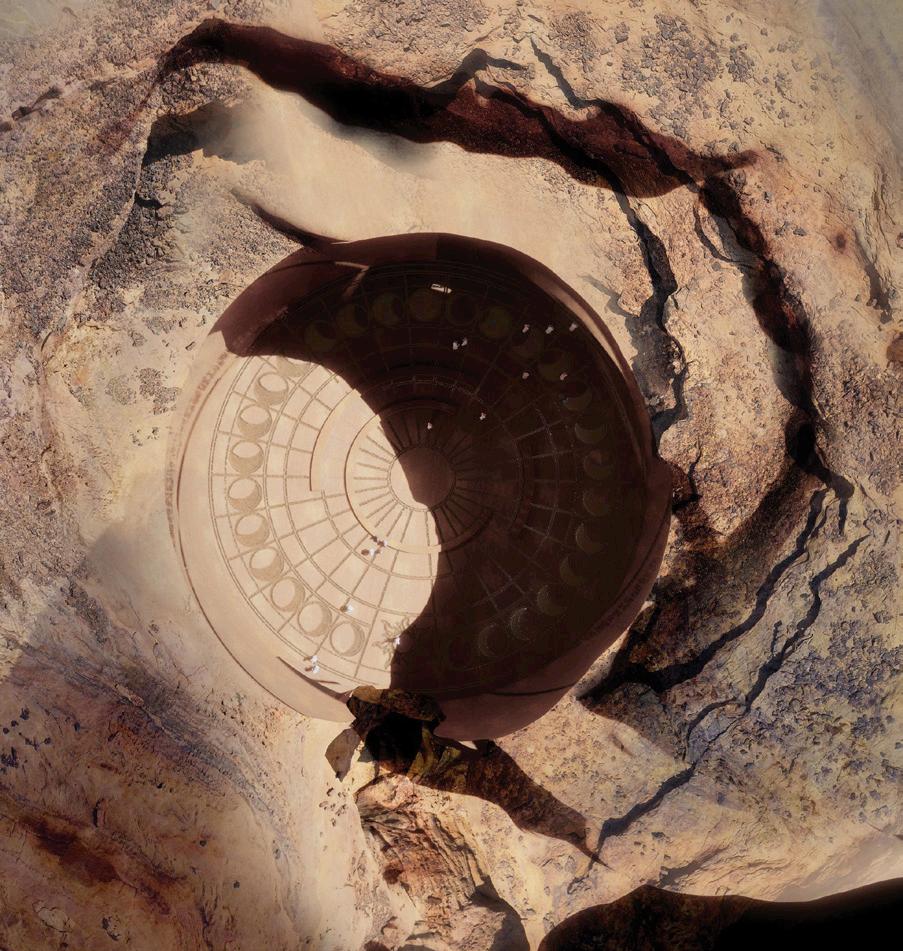
Shooting for the moon
The inaugural excavation for Sharaan – a groundbreaking upcoming resort in Saudi Arabia’s AlUla – took place in March, marking a significant milestone for The Royal Commission for AlUla. Designed by renowned French architect Jean Nouvel along with the expertise of French engineering company Bouygues S.A., Sharaan will offer a unique experience that contributes to AlUla’s journey development into a premier destination for sustainable luxury tourism. The resort is nestled into the rock at Sharaan Nature Reserve, blending in harmoniously with its surrounding ancient geological wonders. It will feature 38 custom suites carved into the sandstone mountains, along with comprehensive wellness facilities, familyfriendly amenities, diverse dining options, and unique panoramic views. It isn’t just the location that’s unique – it’s also the method behind its build: RCU and its contractor partners have developed construction techniques that combine the ancient Nabataean practice of creating spaces within rock together with modern engineering methods, to create habitable spaces that honour the past while aligning with modern-day expectations – one of which involves excavated spaces that exist on top of each other. RCU aims to have 5,000 hotel rooms in AlUla by 2030 and 8,500 by 2035, and Sharaan is a flagship project that demonstrates the commitment to safeguard the area’s natural beauty and historical importance, while transforming it into a leading global destination for sustainable luxury tourism, and the world’s largest Living Museum.
MAY 2024 ATELIERS JEAN NOUVEL
66 POSTCARD


INSIGHT REPORT
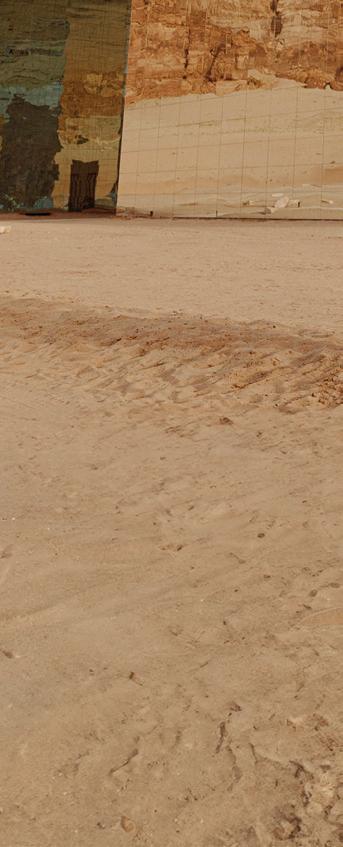


CHARTING NEW HORIZONS BY PIONEERING THE MIDDLE EAST’S TOURISM REVOLUTION
The travel capitals of the future




Government Trends 2024
Explore the eight trends propelling the government of the future



 Hassan Malik
Lead Partner, Tourism Sector, Deloitte ME
Hassan Malik
Lead Partner, Tourism Sector, Deloitte ME
In recent years, the Middle East has emerged as a powerhouse in the global tourism arena.
As the region experiences exponential growth, fuelled by a combination of strategic investments underlined by visionary leadership – and a rich cultural heritage that holds great appeal as one of the last major truly as-yet-undiscovered regions of the world for keen travellers from across the globe – it stands at the forefront of the travel industry, poised to redefine the future of tourism on a global scale.
At the heart of this transformation is Saudi Arabia, a nation on the cusp of becoming the world’s leading tourism destination. With ambitious initiatives such as Vision 2030 driving sustainable development, diversification, and truly inspired innovation that is accelerating growth at a dazzling rate, the kingdom
There has never been a more exciting time to be in the industry. Together, we can chart a course towards a future where travel transcends boundaries.
is laying the groundwork for a vibrant and inclusive tourism ecosystem that truly unlocks its immense potential while catering to the diverse interests of travellers from around the world.
In preparation for this new influx of interest in the region, the Middle East’s aviation industry is playing a pivotal role as it witnesses unprecedented growth supported by major investments in fleet expansion, infrastructure development, and cutting-edge technologies. As the region’s airlines and airports look to the future by embracing innovation, travellers can expect a more seamless and personalised experience that transcends borders and elevates their journey to new heights of comfort, convenience, and global connectivity.
Now, more than ever before, we are entering the era of personalised travel. Customisation is the key to unlocking unforgettable experiences that resonate deeply with travellers seeking something more profound. From bespoke itineraries tailored to individual preferences, to immersive cultural encounters that foster a sense of belonging and connection, the future of travel is all about creating meaningful moments that leave a lasting impression. Enhancing our ability to make experiential travel more immersive than it ever has been before, innovative technologies are reshaping the industry landscape by offering travellers unprecedented access to new destinations and experiences. From artificial intelligence-enhanced virtual reality tours that transport passengers to distant shores, to blockchainenabled booking platforms that ensure security and transparency, and augmented reality that can tease and tempt visitors from every corner of the globe, to data and insights that can help businesses be more strategic than ever before in targeted campaigns that maximise their ROI, technology is truly driving a paradigm shift in how we explore the world.
ere has never been a more exciting time to be in the industry. With these in-depth insights on industry trends and best practices, to analyses of market dynamics and consumer behaviours with actionable strategies to take note of, we’re here to help you stay ahead in this ever-changing dynamic landscape. Join us as we embark on this new journey of discovery, inspiration, and transformation. Together, we can chart a course towards a future where travel transcends boundaries, fosters connections, and enriches lives, with the Middle East’s boundless possibilities at the heart of it all.
BUSINESS TRAVELLER MIDDLE EAST INSIGHT REPORT 2024 3 FOREWORD

Business Traveller Middle East is jointly published by Motivate Media Group and Panacea Media Ltd
MOTIVATE MEDIA GROUP
Editor-in-Chief Obaid Humaid Al Tayer
Managing Partner and Group Editor Ian Fairservice



Editor Yi-Hwa Hanna
Art Director Clarkwin Cruz
Editorial Co-ordinator Londresa Flores
Contributors Hassan Malik, Saudamini Dubey, Salimah Esmail, AbdulMouhsen Almadani, Aurelie Fondecave, Cedric Dallemagne
General Manager – Production S Sunil Kumar
Production Manager Binu Purandaran
Production Supervisor Venita Pinto
Chief Commercial Officer Anthony Milne
Group Sales Manager Chaitali Khimji
Senior Sales Manager Murali Narayanan
PANACEA MEDIA LTD
Managing Director Julian Gregory


Associate Publisher Middle East Rania Apthorpe

HEAD OFFICE: Media One Tower, Dubai Media City, PO Box 2331, Dubai, UAE; Tel: +971 4 427 3000; Fax: +971 4 428 2266; E-mail: btme@motivate.ae



DUBAI MEDIA CITY: SD 2-94, 2nd Floor, Building 2, Dubai, UAE; Tel: +971 4 390 3550; Fax +971 4 390 4845
ABU DHABI: PO Box 43072, Abu Dhabi, UAE; Tel: +971 2 677 2005; Fax: +971 2 657 3401; Email: motivate-adh@motivate.ae
SAUDI ARABIA: Regus Offices No. 455 - 456, 4th Floor, Hamad Tower, King Fahad Road, Al Olaya, Riyadh, KSA Tel: +966 11 834 3595 / +966 11 834 3596 Email: motivate@motivate.ae
LONDON: Motivate Publishing Ltd, Acre House, 11/15 William Road, London, NW1 3ER, UK; E-mail: motivateuk@motivate.ae


Panacea Media Ltd
41-43 Maddox Street, London, W1S 2PD; Tel: +44(0)20 7821 2700; businesstraveller.com
Panacea Publishing Asia Ltd #2408 24/F Dominion Centre, 43-59 Queen’s Road East, Wanchai, Hong Kong; Tel: +852 2594 9300; Fax: +852 25196846
BUSINESS TRAVELLER MIDDLE EAST INSIGHT REPORT 2024 4 CONTENTS 6 Shaping the Future of Tourism Personalisation in Tourism: Elevating Experiences and Maximising ROI 10 Upward Bound: The Seven Pillars of the Aviation Boom 12 Saudi Arabia: A Leading Tourism Destination 14
SAUDI TOURISM AUTHORITY HIN255/ADOBE STOCK TIERNEY/ADOBE STOCK VEGEFOX.COM/ADOBE STOCK
11.1 TRILLION US$
Total contribution of travel and tourism to global economy projected for 2024
90 BILLION DHS
Amount that Abu Dhabi aims to contribute to the UAE GDP annually by 2030
US$ 800 billion
US$ 31 billion US$ 15 billion US$ 60 billion US$ 17.5 billion US$ 10 billion
10 billion
430 MILLION
Number of travel and tourism jobs worldwide forecast for 2033
100 MILLION
Number of tourists Saudi Arabia welcomed in 2023, exceeding its target 7 years early
90 MILLION
Number of international arrivals welcomed by the Middle East and North Africa (MENA) region per year – this is 6% of the world’s total arrivals
17.15 MILLION
Number of international visitors to Dubai in 2023 – a new record
10.3%
Percentage of global workforce employed in the travel and tourism industry
19.7%
Global surge in travel demand
1 in 10
Number of jobs generated by the travel and tourism industry worldwide
AT A GLANCE BUSINESS TRAVELLER MIDDLE EAST INSIGHT REPORT 2024 5
in its tourism sector in
alone Egypt’s tourism revenue in 2023 – a new record
investments in major projects to enhance its tourism sector The amount Oman is investing in its tourism industry
amount Kuwait has approved for tourism projects
in its tourism sector
US$
Abu Dhabi’s investment in tourism infrastructure Bahrain’s investments
2023
Qatar’s
The
Saudi Arabia’s investments

Shaping the Future of TOURISM
Embracing cutting-edge technology and societal shifts for a new wave of immersive travel
By Saudamini Dubey and Salimah Esmail
The tourism industry is an ever-evolving one, shaped by emerging trends and technology. With the pandemic having accelerated significant changes that are shifting the industry towards an uncharted new course, hyper-personalisation, collaboration with ecosystem partners, sustainability, and workforce upskilling are becoming key focuses. The demand for multisensory tourism experiences is also on the rise, and organisations are using digital, innovation, and emerging tech to augment these experiences.
Immersive reality – defined by Saudamini Dubey, Deloitte Middle East’s emerging tech and innovation lead partner as “a confluence of technologies that enable the creation of immersive and seamless experiences that integrate our physical and virtual worlds” – is the latest technological development revolutionising how people experience and interact with destinations. In the tourism sector, immersive
BUSINESS TRAVELLER MIDDLE EAST INSIGHT REPORT 2024 6
VEGEFOX.COM/ADOBE STOCK
reality allows users to explore and experience destinations in new and exciting ways. ese experiences include virtual tours of landmarks, augmented reality guides for city exploration, and the creation of digital twins to create personal and immersive experiences for customers.
e emergence and rising adoption of immersive reality in the Middle East and globally is a prime example of how the tourism industry is focusing on innovative ways to provide travellers with new, more personal and meaningful experiences.
The rise of experiential and immersive tourism in the Middle East
As the Middle East looks to diversify its economy, tourism is well-positioned to be a key driver. e UAE’s tourism sector is expected to contribute 12.4 per cent to GDP in 2027, while Saudi Arabia aims to contribute 10 per cent of its overall GDP through its tourism sector, as outlined in its Vision 2030 plan. UNWTO stated that “Saudi Arabia’s achievement of welcoming over 100 million tourists in 2023 is a beacon of what is possible through collaboration, innovation, and a clear vision for the future.”

Immersive reality that integrates our physical and virtual worlds is the latest technological development revolutionising how people experience and interact with destinations.”
INTERNATIONAL TOURIST ARRIVALS:
Percentage of 2019 levels recovered in Q1 2023 (%)













Saudamini Dubey is the emerging tech and innovation lead partner at Deloitte Middle East
























As more companies and potential travellers turn to virtual solutions, the global virtual tourism market is expected to reach $6.5 billion by 2030, according to a report by Allied Market Research. A Deloitte article titled “ e Metaverse and its potential for MENA” stated that the metaverse [and immersive technologies] could contribute up to $38 billion to the Saudi Economy and $16.7 billion to the UAE Economy by 2035 – and with its potential to not only enhance the customer experience but also promote destinations to a global audience, immersive reality is set to play a significant role in shaping the future of the Middle East’s tourism industry.
e Middle East is a region at the forefront of innovation, and immersive reality will be no exception. With its stunning landscapes and rich cultural heritage, the region is uniquely positioned to benefit from these technologies and emerge as a leading destination for experiential and immersive tourism.
BUSINESS TRAVELLER MIDDLE EAST INSIGHT REPORT 2024 7
100 90 10 88 12 86 14 80 20 54 46 AFRICA EUROPE MIDDLE EAST AMERICAS WORLD ASIA PACIFIC
Recovered Pending SUTLAFK/ADOBE STOCK
INTEGRATING IMMERSIVE REALITY INTO A BUSINESS STRATEGY
As stakeholders embark on their immersive reality journeys, it is vital to prioritise the creation of experiences that are hyper-personalised, multi-sensory, and built on trust through responsible practices. The following guiding principles should also be taken into consideration for tourism organisations:
• Immersive reality is about enhancing user-centric experiences with technology as an enabler, while being mindful of health and well-being.
• Responsible immersive experiences are built on a foundation of trust, where cybersecurity and safety, digital identity, digital payments, governance, and regulation are fundamental pillars.
• Collaboration and orchestration are critical to implementing immersive and spatial technologies in tourism and bringing engaging experiences to life.
• A human-centered design approach should be taken into consideration when creating digitally inclusive, immersive experiences.
• Continuous learning and experimentation in an immersive lab environment are essential for staying ahead in the constantly evolving field of immersive technologies.
• Localising content and being culturally sensitive are crucial factors in driving adoption and fueling growth in the digital economy.
• Designing immersive experiences with sustainability and responsibility in mind is essential for a responsible immersive reality journey.


The Business Impact
Immersive reality is a powerful tool for creating exceptional experiences that can differentiate one from the competition. In today’s highly competitive tourism industry, organisations must constantly innovate and find new ways to attract and retain customers, train employees, and improve collaboration and decision-making. Embracing these technologies is certainly one way to do so in the tourism industry, with their significant potential to promote destinations to a global audience and provide travellers with more captivating multisensory and multi-use personalised experiences. Singapore, for example, has developed a virtual Changi Airport on Roblox to allow users to experience a virtual representation of popular airport features, such as the indoor waterfall. By offering virtual tours
Immersive reality is a powerful tool for creating exceptional experiences that can differentiate one from the competition
BUSINESS TRAVELLER MIDDLE EAST INSIGHT REPORT 2024 8
Salimah Esmail is a digital transformation and innovation offering lead at Deloitte Middle East
KEGFIRE/ADOBE STOCK
and new experiences, tourism organisations can differentiate themselves from competitors, generate interest in the destination, and ultimately increase revenue and profitability.
Integrating immersive reality into an organisation’s overall business strategy can engage customers in more meaningful ways, by allowing them to explore destinations and attractions in ways that were previously impossible. One prime example is UNWTO and NEOM’s “Tourism Experiences of the Future” challenge to source new ideas and disruptive business models, catering for the growing demand of these experiences.
Immersive reality can also help organisations optimise their operations and improve efficiency, leading to significant cost savings. By streamlining processes and reducing the need for physical infrastructure, businesses can lower their overheads, while still delivering exceptional experiences to customers. Egypt’s launch of a 3D VR programme to promote medical tourism did this in exceptional fashion.
In sports tourism, meanwhile, the integration of immersive experiences can generate new revenue streams and enhance fan engagement, leading to increased exposure and awareness. The NBA, for instance, is using VR to allow fans to enjoy basketball games from the comfort of their own home, while using AR apps to increase fan experience and engagement. By adopting immersive reality strategies, sports organisations can create unique and memorable experiences that differentiate themselves from competitors and attract a wider audience. These experiences also provide valuable data insights into fan behaviour and preferences, which can inform marketing and promotional campaigns. They can also create opportunities for collaboration and partnerships between sports organisations and local businesses, generating new revenue streams for both parties.
Cultural tourism has become increasingly popular across the globe in recent years, and the adoption of immersive reality can further support its growth and development. Paris’s Musée d’Orsay uses VR

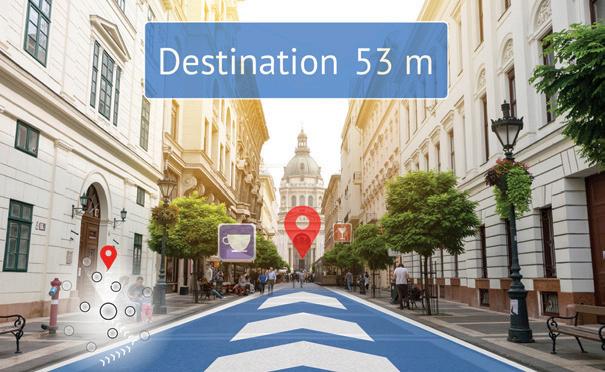
technology to provide an experience for visitors to immerse themselves into the everyday life of the Impressionism era, while Saudi Arabia recently launched the world’s first national “metaverse platform” to showcase its many cultural attractions to visitors both in the kingdom and globally. Cultural tourism can not only foster greater understanding and appreciation of different cultures, promote intercultural dialogue, and preserve cultural heritage for future generations, but by promoting a region’s cultural heritage through immersive experiences, businesses can also attract more visitors and create new job opportunities. This can contribute to the socio-economic development of local communities, improve the quality of life for residents, and drive economic growth and prosperity in the region.
The Middle East’s innovative adoption of immersive reality technologies has the potential to redefine the tourism industry. Tourism organisations in the region have the opportunity to define a new era of excellence in terms of sustainable growth, responsible practices, and unforgettable experiences. By doing so, the region will be poised to captivate and inspire modern travellers for years to come, cementing its position as a top-tier destination and a global trendsetter.
BUSINESS TRAVELLER MIDDLE EAST INSIGHT REPORT 2024 9
VEGEFOX.COM, ZAPP2PHOTO/ADOBE STOCK
Personalisation in Tourism Elevating Experiences and Maximising ROI

In a world craving deeper connections, the future of travel is personal
By AbdulMouhsen Almadani
In today’s dynamic tourism landscape, personalisation has emerged as a cornerstone strategy for enriching travel experiences and fostering lasting connections with visitors. With the advent of digital technologies and an increasingly diverse range of traveller preferences, the tourism industry has recognised the need to move beyond one-size-fits-all approaches and embrace personalised offerings. Here, we explore the profound impact of personalisation in tourism, emphasising its role in enhancing customer experiences and maximising return on investment (ROI) for businesses.

 AbdulMouhsen Almadani is director of customer and marketing for Deloitte Digital
AbdulMouhsen Almadani is director of customer and marketing for Deloitte Digital
ENHANCING CUSTOMER EXPERIENCE
Personalisation serves as the bedrock for crafting exceptional travel experiences that deeply resonate with each visitor. By leveraging advanced data analytics and insights, tourism businesses can decode travellers’ preferences and behaviours to tailor every facet of the journey. From individual recommendations to curated itineraries and bespoke activities, personalisation adds layers of depth and meaning that foster emotional connections between visitors and destinations.
Consider a scenario where a family of adventure enthusiasts plans a trip to a mountainous region. Through personalised recommendations driven by data analytics, they can receive tailored itineraries suggesting adrenaline-pumping activities like zip-lining, rock climbing, and whitewater rafting. This personalised approach not only meets their interests but also creates anticipation and excitement, setting the stage for an unforgettable adventure.
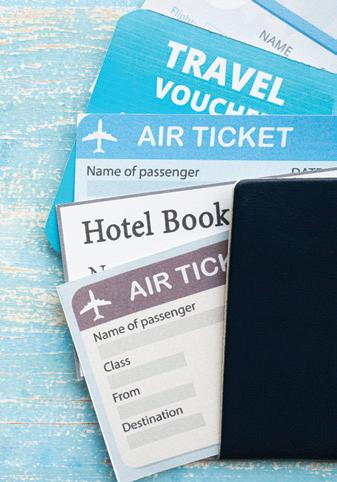
BUSINESS TRAVELLER MIDDLE EAST INSIGHT REPORT 2024 10
THINK B, TATOMM/ADOBE STOCK
MAXIMISING THE ROI OF PERSONALISATION
Investments in personalisation yield significant returns for tourism businesses, both in terms of customer satisfaction and financial performance. By delivering tailored experiences, businesses enhance loyalty, increase customer lifetime value, and drive revenue growth. Personalisation allows businesses to anticipate and fulfill the individual needs and desires of travellers, thereby fostering stronger connections and encouraging repeat visits.
One key aspect of maximising ROI is through targeted marketing and upselling. Personalised campaigns, informed by data analytics, allow businesses to reach the right audience with the right message at the right time. For example, hotels can send tailored offers to previous guests based on their preferences, increasing the likelihood of conversion and maximising revenue potential. Similarly, tour operators can leverage customer insights to recommend add-on activities or upgrades, increasing the average transaction value and once again increasing ROI.

Personalisation also enhances cross-selling opportunities by recommending relevant products and services throughout the travel journey. For instance, a tour operator may suggest complementary experiences, dining options, or accommodations based on travellers’ interests and preferences, thereby increasing the overall spend per customer.

TACKLING CHALLENGES IN PERSONALISATION
While its benefits are evident, implementing personalised experiences in tourism can pose several challenges that businesses must navigate effectively, such as:
1 Data Privacy and Security Concerns
Personalisation relies heavily on the collection and analysis of customer data. However, with increasing concerns about data privacy and security, tourism businesses must adhere to stringent regulations and ethical standards for collecting, storing, and using customer data. Failure to do so can erode trust and result in reputational damage.
2 Data Integration Complexity
Tourism businesses often operate with
fragmented data sources, including booking systems, customer relationship management (CRM) platforms, and third-party data sources. Consolidating and analysing data from disparate sources can be complex and time-consuming, requiring investment in robust data management systems and analytics tools to streamline operations.
3 Customer Insights Accuracy
Effective personalisation relies on accurate insights into customer preferences and behaviours. Obtaining and maintaining these insights requires ongoing investment in market research and data analytics capabilities. However, inaccuracies or outdated information can lead to misaligned recommendations and diminished customer experiences.
4 Resource Allocation
Implementing personalised experiences demands significant resources, including technology infrastructure, skilled personnel, and ongoing maintenance costs. Businesses must carefully allocate resources to maximise the ROI of personalisation initiatives. Moreover, the costs associated with acquiring and managing customer data can be substantial, requiring businesses to strike a balance between investment and returns.
5 Organisational Alignment:
Achieving seamless personalisation across various touchpoints requires alignment across departments and stakeholders within the organisation. This necessitates clear communication, collaboration, and alignment of goals and objectives. However, organisational silos, conflicting priorities, and resistance to change can hinder efforts to implement tailored experiences effectively.
Despite its potential challenges, the advantages and rewards that can be reaped from exploring greater personalisation in tourism are too great to be ignored. In a world where customers increasingly seek to spend with brands they connect with, customisation isn’t only seriously competing with the generic, it’s transcending it – and business that are not only seeking to stay on the forefront, but also hoping to secure a future in which they’re not left behind would be wise to take note.
BUSINESS TRAVELLER MIDDLE EAST INSIGHT REPORT 2024 11
MEGO-STUDIO, TIERNEY/ADOBE STOCK


UPWARD BOUND

Soaring towards success – the seven architectural pillars of the Middle East aviation boom
By Aurelie Fondecave
In the wake of global transformations and economic diversification efforts, the Middle East is increasingly emerging as a vibrant hub for aviation innovation and expansion. Fuelled by targeted investments and forward-thinking initiatives, the region is exhibiting undeniable potential to become a global aviation powerhouse. Here, we dissect the seven architectural pillars shaping the Middle East’s aviation boom.
1
Diversification of Economies
Middle Eastern nations are pivoting away from oil dependency by investing strategically in tourism development, with aviation as a linchpin of their transformation agenda. In Saudi Arabia, for instance – where the government and its sovereign wealth fund, the PIF, are increasingly supporting the development of related infrastructure and assets – the kingdom’s aviation strategy aims to reach 330 million people by 2030, as well as 4.5 million tonnes of cargo – a noticeable growth compared to 100 million PAX in 2019, and 88 million tonnes of cargo in 2022. Recognising the potential of aviation to drive

economic diversification, countries in the region have been ramping up infrastructure and fostering air connectivity to attract more global travellers and boost trade.
2 Regional Fleet Expansion and Industry Dynamism

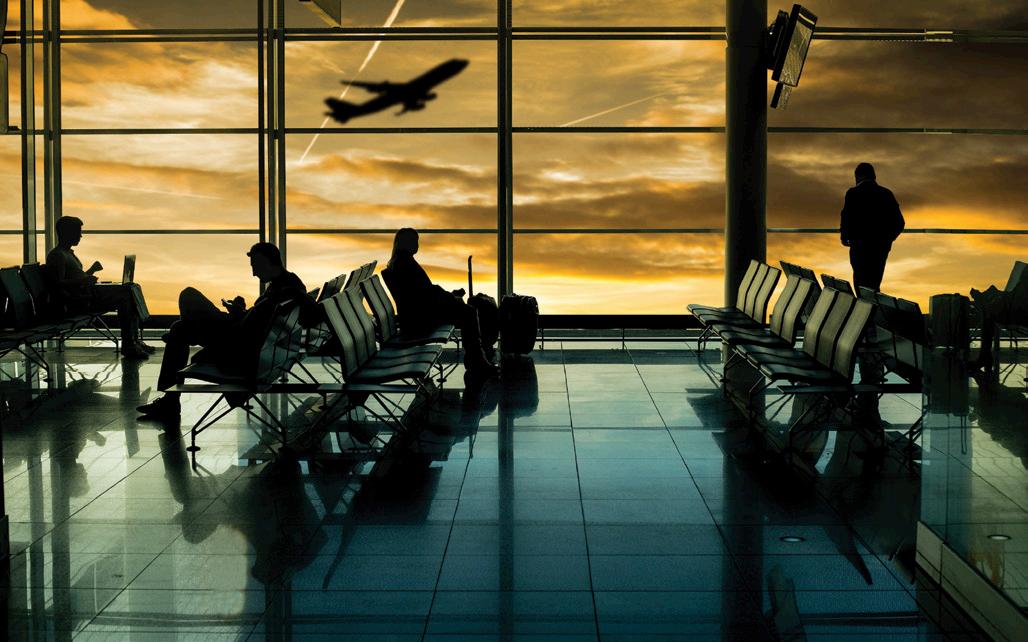
e Middle East’s aviation market has been experiencing a significant resurgence post-COVID, evident in the robust fleet expansion plans of national carriers. With projected fleet growth rates surpassing the global average at an annual rate of 4.2 per cent for the decade 2024-2034 – a significant measure compared to Africa at 2.3 per cent, Latin America at 1.9 per cent, North America at1.8 per cent, and Western Europe at 1 per cent – regional airlines are cementing their positions as major global players, backed by strong financial performance and ambitious growth strategies. Emirates continues to excel on a global scale, while Qatar Airways and Etihad Airways are majorly expanding their networks in a major way: the former has extended its network to over 170 destinations, while the latter projects an increase to 18 million passengers by 2025, surpassing pre-pandemic levels.
3 Investment in Infrastructure
Heavy investments in airport infrastructure underscore the region’s commitment to accommodate burgeoning passenger traffic and sustain growth. Mega-projects like Saudi Arabia’s King Salman

Aurelie Fondecave is a strategy and aviation expert at Deloitte Middle East
BUSINESS TRAVELLER MIDDLE EAST INSIGHT REPORT 2024 12
HIN255/ADOBE STOCK
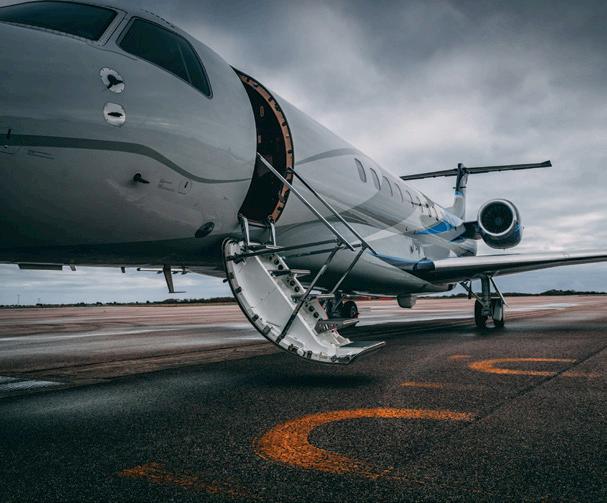
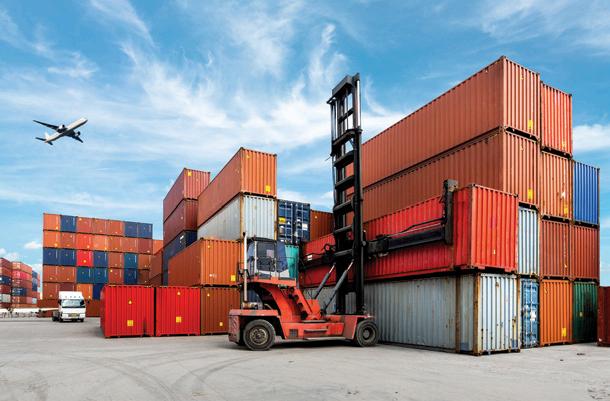
International airport and the expansion of Dubai’s Al-Maktoum International airport highlight the scale of investment (at around US$30 billion each), with the Middle East set to handle over a billion passengers annually by 2040 – a significant increase from 2019’s 405 million. The region, with over 110 airports that will soon also include the world’s first LEED Goldaccredited passenger terminal building, at Kuwait International airport, is among the fastest-growing aviation markets in the world.
The region is exhibiting undeniable potential to become a powerhouse in global aviation.
4
Growth of Low-Cost Carriers (LCCs)
The Middle East is witnessing a proliferation of low-cost carriers, capitalising on the region’s strategic location and growing demand for affordable air travel. Dubai and Abu Dhabi saw their LCCs’ market share jump to over 25 per cent from 2019 to 2022, with established players like flydubai joined by newcomers such as Wizz Air, signaling a paradigm shift in regional aviation dynamics and fostering increased connectivity within the Middle East and beyond.
5 Air Cargo Hub
Leveraging strategic locations and multimodal capabilities, Middle Eastern airports are emerging as vital hubs for air freight operations. Dubai International and Hamad International, among others, serve as pivotal logistics centres, facilitating seamless trade connections between markets across continents. Ambitions in the aviation sector are complemented by strategic investments in maritime capabilities and in logistic zones to solidify the Middle East’s position as a future logistics leader.
Aftermarket Services
6
The region is eyeing the lucrative MRO (Maintenance, Repair, and Overhaul) market, with ambitious projects aimed at enhancing regional capabilities. Initiatives like the MRO Village by Saudia Aerospace Engineering Industries exemplify the region’s aspiration to compete on a global scale, establishing a robust MRO footprint alongside aviation powerhouses like Dubai and Qatar. Emirates and Etihad are not lagging behind: Emirates has recently announced investing $950 million to build a new engineering facility at Dubai World Central (DWC), while Etihad Airways Engineering is set to expand its Abu Dhabi hangar’s capacity.
7 Focus on Sustainability
With growing environmental concerns, sustainability has taken centre stage in Middle Eastern aviation. From the design of green airport infrastructure to the adoption of renewable energy sources, the region is making strides towards greener aviation practices. Ambitious projects like King Salman International Airport’s pursuit of LEED Platinum certification underscore the commitment to environmentally conscious development.
The Middle East’s aviation sector is experiencing a profound transformation driven by strategic investments and technological innovation, with a steadfast commitment to sustainability. As the region continues to soar to new heights, these seven architectural pillars will serve as guiding beacons, shaping the trajectory of Middle Eastern aviation for years to come.
BUSINESS TRAVELLER MIDDLE EAST INSIGHT REPORT 2024 13
JAMES HEMING, PAKORN/ADOBE STOCK
A LEADING TOURISM DESTINATION SAUDI ARABIA
Breaking the 100 million visitors’ mark, making history, and charting a successful course towards 2030 and beyond
By Cedric Dallemagne

 Cedric Dallemagne is strategy director at Deloitte Middle East
Cedric Dallemagne is strategy director at Deloitte Middle East
In February 2024, His Excellency the Minister of Tourism Ahmed bin Aqeel Al-Khateeb officially confirmed that the Kingdom of Saudi Arabia had broken the 100 million visitors mark in 2023, thereby also achieving the kingdom’s national target seven years ahead of its ambitious national strategy. As such, Saudi Arabia is increasing its target for 2030 to 150 million visitors, investing US$800 billion to support the sector, enabling new destinations, offerings, and experiences.
The cornerstone of the strategy hinges on the growth in international travels largely coming from mid-haul ranges. In 2023, inbound visits reached 27.4 million, a 65 per cent year over year growth according to the Ministry of Tourism’s February announcement.
Healthy domestic travel
Saudi Arabia is on an historical trajectory, setting itself solidly among the present and future leaders in the global tourism race. This new history has actually been in the making for several years, and focusing only on inbound visitors does not provide the full picture.
Saudi Arabia has increased its domestic tourism since 2015, in terms of visitors, at a compounded annual
growth rate of 7 per cent, and its inbound tourism by 5.4 per cent. Both figures are staggering. Domestic travel during the COVID-19 pandemic from 2019 to 2020 only saw a 11 per cent year-over-year decline, and has increased at a 23.5 per cent annual growth rate since. While the domestic travel increase this year was only 2 per cent compared to 2022, signaling a potential maturing of the domestic tourism segment, this spectacular rise is still an important part of the tourism growth story in the country.
With a population of 32 million inhabitants, the domestic overnight visitors represent a 2.42 ratio to the total population – a ratio similar to leading global tourism countries like Spain at 3.08 and France at 2.96, indicating the strength of the local tourism consumption. With more destinations to be activated in the foreseeable future, the domestic demand should continue to show a lot of strength. Up until 2022 (2023 spending statistics are not yet published at this time), we can also see that the amount spent by domestic visitors has increased faster (with 12 per cent CAGR) than inbound spend (at 2.5 per cent), though inbound contribution per visit remains over four times that of domestic visitors.
BUSINESS TRAVELLER MIDDLE EAST INSIGHT REPORT 2024 14
SELIMBT/ADOBE STOCK; SAUDI TOURISM AUTHORITY

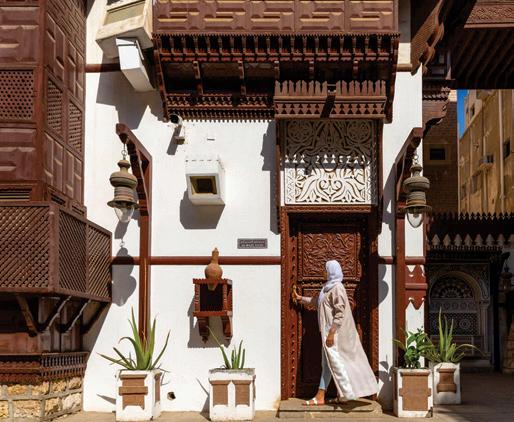
Attention on inbound visitors
Inbound visits are still of critical importance to the kingdom, especially considering that the country aims to welcome 70 million foreign visitors by 2030 – which is four times the number of visitors it hosted in 2023.
To this end, the kingdom is sparing no expenses, investing US$800 billion to activate new destinations by building a variety of mega-projects, airports, marinas, ski resorts, and more, as well as launching programmes throughout Saudi Arabia to avoid the existing concentration in the capital, the holy sites, Jeddah, and a few other large cities.
The Saudi government is working tirelessly to accelerate the kingdom’s development and readiness both in terms of assets and legislations. With over 1,800km of pristine coast along the Red Sea, in 2022, Saudi Arabia launched a new authority to help regulate maritime and coastal tourism activities to sustainably enable the practice of activities for visitors and residents along the Red Sea. The Saudi Red Sea authority has been actively working on sustainability since its inception, collaborating with leading experts in environmental conservation and circular economy. And the Authority’s efforts are paying off, having already been recognised on 4 March this year by receiving the Game-Changer in Sustainable Tourism Award 2024.
Saudi Arabia understands that aside from the novelty, having only normalised visitors visas in 2019 – and continuing to ease the access to the kingdom ever since – it needs to provide reasons for the world to choose it as a tourism destination. To this end, beyond infrastructure investments to create state-ofthe-art facilities, Saudi Arabia’s strategy also largely hinges on hosting more and more global sports, cultural events, and professional shows.
From major sporting events – such as football (including the 2034 FIFA World Cup) and motor sports to boxing, winter sports, and video games –to cultural events such as the Expo 2030, LEAP, and more, Saudi Arabia has prepared itself to be able to handle a large capacity of guests – and has been putting in the work to draw in the calibre of talent and entertainment that will attract visitors to them from across the globe.
One historical driver for inbound visits to the kingdom has been religious pilgrimages. These accounted for 60.6 per cent of the inbound visits and nearly 72.5 per cent of the inbound spend in 2018, but have been decreasing ever so slightly since, to represent only 36.1 per cent of visits and 40.9 per cent of spend in 2022, based on the Ministry’s tourism dashboard.
For Saudi Arabia, as the custodian of the two holy mosques, pilgrimages to the holy sites remain of critical importance, far beyond tourism considerations. Despite the recent decline, new hotels continue to emerge in the two holy cities, as illustrated by the opening in Madinah of the Dubaibased luxury hotel chain Jumeirah Group’s first property in Saudi Arabia in February 2024, or the Public Investment Fund (PIF) creating a dedicated development company, Rua Al Madinah, aiming at enhancing the hospitality offering in the holy city.
MAJOR EVENTS THAT HAVE TAKEN PLACE, OR WILL TAKE PLACE, IN SAUDI ARABIA
Sports Events
FOOTBALL
• FIFA World Cup, in Winter 2034
MOTOR SPORTS
• Jeddah Grand Prix, since 2021
• Dakar Rally, since 2020
• Formula-E championship with the Diriyah E-Prix, since 2018
• E1 Series speed boat racing, since February 2024
• America’s Cup Preliminary Regatta, in Winter 2023
BOXING
• Pro Fighters League (PFL) MENA, in April 2024
• One-off fights, including Francis Ngannou vs. Tyson Fury, Anthony Joshua vs. Oleksandr Usyk, and Jake Paul vs. Tommy Fury
WINTER SPORTS
• Winter Asia Games in Trojena, in 2029
VIDEO GAMES
• Gamers8 (to become Esports World Cup in 2024)
• New World Gaming Summit, in May 2024
Cultural Events
• World Expo, from Winter 2030
• Saudi Seasons, since 2023
• LEAP, since 2022
BUSINESS TRAVELLER MIDDLE EAST INSIGHT REPORT 2024 15
Importance of Visiting Friends and Relatives (VFR)
The second largest inbound visitor contribution to growth in 2022 came from the VFR segment, representing 30.8 per cent of all inbound visits. The importance of the VFR segment may help explain another staggering tourism figure from Saudi Arabia, which is that the average length of stay of visitors which is now close to 16.3 days – which is almost twice longer than the average stay in Spain in 2022, at 8.5 days.
The importance of VFR may also explain the growing importance of private accommodations and apartments, representing 51.9 per cent of the accommodation chosen by inbound tourists in 2022.
Saudi Arabia is expecting to increase its room capacity by 250,000 rooms by 2030.
In share of inbound spend, apartments reached 31 per cent in 2022, translating in a 11.9 per cent compounded annual growth spend since 2015. The share of private accommodations for domestic visits has also been growing representing 36 per cent of total accommodations. Apartments still represent 33 per cent of total accommodations for domestic travel, but have seen their share of accommodation go down by close to 20 per cent since 2015.
Promising yet challenging situations for hotels
With 40 per cent of total spend, hotels remain the largest share of inbound accommodation, but the amount spent on hotels by inbound visitors in 2022 was only half of the amount spent in 2019. Still, hotels have benefited from the growth in domestic travel and represented 29 per cent of domestic visits for total accommodations in 2022. The hotel spend for domestic travel grew the fastest amongst all accommodation

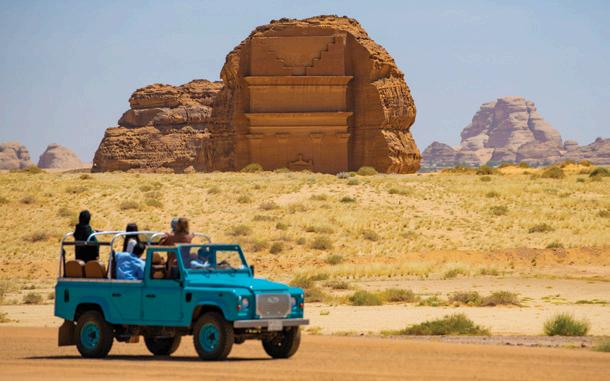
categories at a 17.9 per cent compounded annual growth rate since 2015. Despite the growth in domestic travel, hotels in 2022 had not yet fully recovered their recent pick performance of 2019.
In fiscal year 2023, the hotel industry continued its progression improving its average occupancy by 8 per cent, its average daily rate (ADR) by 16 per cent and revenue per available room (RevPAR) by 26 per cent according to STR Global. According to His Excellency the Minister of Tourism, Ahmed Al-Khateeb, Saudi Arabia counted roughly 280,000 hotel rooms in 2023, and is expecting to increase its room capacity by an incremental 250,000 rooms by 2030. It is therefore not surprising to see so many new hotel announcements and partnerships with major hotels brands set to launch in the kingdom.
BUSINESS TRAVELLER MIDDLE EAST INSIGHT REPORT 2024 16
SAUDI TOURISM AUTHORITY
Still, the industry will continue watching the evolution of the demand for hotels relative to other forms of accommodations. In 2023, Riyadh and Jeddah hotels showed healthy ADR and occupancy rates relative to other regional capitals and even internationals cities, likely comforting investors and hotel brands in the soundness of the kingdom’s hotel market.
Hotels in the kingdom will continue to be key for the success of the Saudi tourism industry. Saudi Arabia's ambition is to attract 70 million international visitors by 2030. To this end, the kingdom can capitalise on the novelty factor and major events, but it will also need to provide global standard services – and the assurance of such services through the reputation of global hotel brands – to last. It is, therefore, not surprising that most global hotel chains plan to enter or further expand their footprint in Saudi Arabia.
Labour challenges
Although global hotel brands with loyalty programmes, rigorous brand standards, and often beautiful and unique assets will surely continue to grow the number of visitors to the kingdom, the path to success will not be without hurdles. In a very competitive global tourism sector, guests will expect the same level of service in Saudi Arabia as they would in any other city around the world, especially as ADR mirrors longer-established premium and leading tourism destinations. Yet the race for talent in the hospitality industry on the heels of the COVID-19 crisis continues, with many key geographies reporting millions of job shortages.
In Europe for instance, Effat and Hotrec Hospitality Europe announced in their joint declaration from March 2024 that “on average the sector is currently missing between 10 per cent to 20 per cent of the workforce in the EU compared to 2019”, when the sector currently employs around 10 million hospitality professionals in the EU.
Over in Asia, The Hotel Association of India reported in March 2023 that despite recent efforts to reduce its manpower shortages, the industry still experienced a 60 per cent shortage partially driven by high attrition rates, poor skills and a negative perception from young professionals about the industry.
Meanwhile, in America, according to a press release from the American Hotel and Lodging Association in February 2024, 82 per cent of hotels surveyed in the US reported having increased wages, yet 72 per cent were still unable to fill in opened positions.
Through its Vision 2030 strategy, Saudi Arabia has set an ambition to create 1.6 million jobs in tourism. Many of the jobs in the sector have traditionally been low-skill jobs, yet the kingdom is keen to see the job creations benefit its citizens. Young Saudis are attracted by the growth in the sector, but are not eager to fill entry positions, despite often lacking the necessary skills expected by hotel chains. Roles in the sector are still stigmatised by a perception of low

social status. As a result, Saudi Arabia is suffering from a shortage in technically qualified labour, particularly in critical functions such as culinary, kitchen, F&B, or sales.
The country has long offset labour shortages in entry positions with expatriate workers coming from countries like Pakistan, India, the Philippines, Egypt, Bangladesh, and Nepal. The trend is unlikely to go away short term. Yet Saudization targets are putting pressure on hoteliers to actively pursue the employment of Saudi nationals, proving difficult at times while forcing hotel brands, hospitality asset owners, and operators to carefully design their human resource strategies. Given the global shortages in manpower and skills, the kingdom will likely need to not only focus on attracting visitors but also global talent able to deliver the expected standards of quality from a tourist population with nearly endless destinations to choose from.
To achieve the 150 million visits by 2030, Saudi Arabia now counts, in part, on the rising middle classes of China and India. To capitalise on these nations' fast-growing middle class, the country will need to adapt its offering to their preferences. Saudi Arabia has, for example, added standard Chinese as a third language in its schools following the visit of the Crown Prince Mohammed bin Salman to Beijing
BUSINESS TRAVELLER MIDDLE EAST INSIGHT REPORT 2024 17
SAUDI TOURISM AUTHORITY
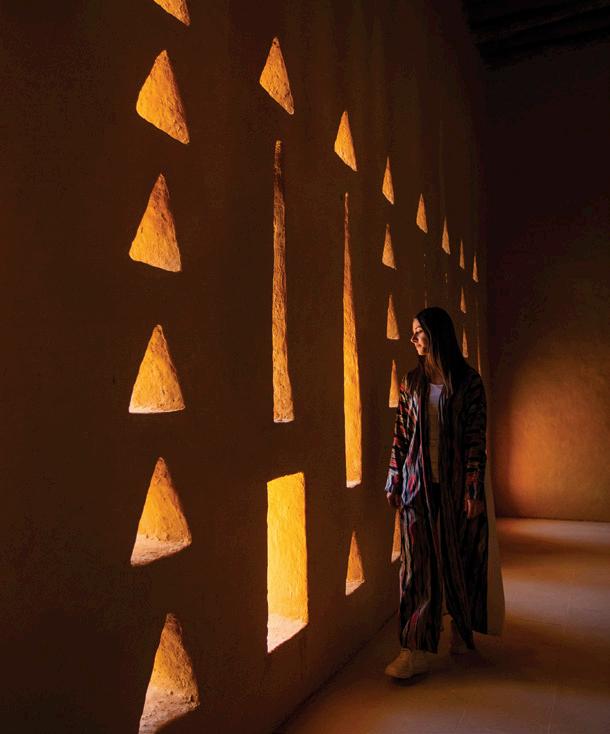

in 2019. e decision has been intended to bring the two trading nations closer. Her Royal Highness, the Vice-Minister of Tourism Princess Haifa Al Saud, also mentioned that the ministry was working to bring tour guides speaking Mandarin to the kingdom, to welcome Chinese tourists.
Catering to Chinese visitors may further complicate staffing considerations for hoteliers in Saudi Arabia, as
their staff currently primarily communicate in Arabic and English, and cater to more Western standards of hospitality. Saudi Arabia will not be the only nation trying to court Chinese visitors, which will also likely result in an intense competition to attract talent that is able to cater to Chinese customers.
Given the strength of the domestic travel, and otherwise diverse visitors to the Saudi Arabia, and a growing expectation for personalised treatment by guests, hospitality companies will have to not only rethink their staffing priorities but also carefully design visitors journeys, and diligently execute on them.
Air connectivity
Beyond hotels, airports will play another critical role in the country’s tourism success. Saudi Arabia needs to minimise frictions for potential travellers, and its eVisa was developed to that end.
e second hurdle is now its direct connectivity. It is therefore not surprising that Saudi Arabia is heavily investing in building new airports to enable its prioritised new destinations (such as Neom and AlUla), and increasing the capacity and modernising airports in cities like Riyadh. King Salman International Airport in Riyadh’s transformation will quadruple its capacity to reach 120 million passengers by 2030. e airport currently serves 94 destinations, compared to 258 destinations for Dubai International airport. e capacity increase should address the gap.
Such a transformation of its air connectivity also implies that Saudi Arabia will likely want to compete as a major hub, similarly to the UAE or Qatar. It will be interesting to follow how each nation’s strategy pans out, as their neighbours also invest in increasing their capacity. Dubai is investing to transform its second airport to be able to welcome 260 million annual passengers, which is twice the current capacity of the two existing main airports serving Dubai – Dubai international airport’s annual capacity is 92.5 million passengers, while Abu Dhabi’s Zayed International airport’s annual capacity is 45 million passengers.
e journey for Saudi Arabia to become a key tourism player globally is well underway, and the country is moving quickly to continue to break records. e kingdom can count on the strength of its domestic tourism, historical religious pull, and high VFR segment; yet the most exciting story for Saudi Arabia is currently around its overall transformation and efforts to attract international visitors.
As a relatively new destination with unique and pristine landscapes, brand new hotels, airports, and exciting worldly events, the country will capture the world’s imagination and drive the desire to visit. e country is confidently investing to make this journey a rapid reality. e journey will present some challenges to overcome, yet after already having achieved its target seven years ahead of plan, the kingdom’s determination is as high as ever, and the world is now carefully paying attention to Saudi Arabia.
BUSINESS TRAVELLER MIDDLE EAST INSIGHT REPORT 2024 18
SAUDI TOURISM AUTHORITY





2023 Middle East Impact Report


Building better futures



3rd Edition
Middle East & Cyprus




Technology
Deloitte
Fast 50 Program



























































 Yi-Hwa Hanna Editor
Yi-Hwa Hanna Editor























































































































































































 ABOVE: Apartments by Marriott Bonvoy
BELOW: Vincent Miccolis
ABOVE: Apartments by Marriott Bonvoy
BELOW: Vincent Miccolis









































































 Almosafer is Saudi Arabia’s leading travel company. Its portfolio caters to every vertical across the travel and tourism ecosystem.
Almosafer is Saudi Arabia’s leading travel company. Its portfolio caters to every vertical across the travel and tourism ecosystem.






 Love”
Love”
































 ABOVE AND LEFT: White and red coral at Pink Sand Beach; diving at Komodo National Park
ABOVE AND LEFT: White and red coral at Pink Sand Beach; diving at Komodo National Park

































































































































































































































 Hassan Malik
Lead Partner, Tourism Sector, Deloitte ME
Hassan Malik
Lead Partner, Tourism Sector, Deloitte ME






















 AbdulMouhsen Almadani is director of customer and marketing for Deloitte Digital
AbdulMouhsen Almadani is director of customer and marketing for Deloitte Digital













 Cedric Dallemagne is strategy director at Deloitte Middle East
Cedric Dallemagne is strategy director at Deloitte Middle East



















